What makes a good picnic great? A pleasant natural setting, agreeable weather…
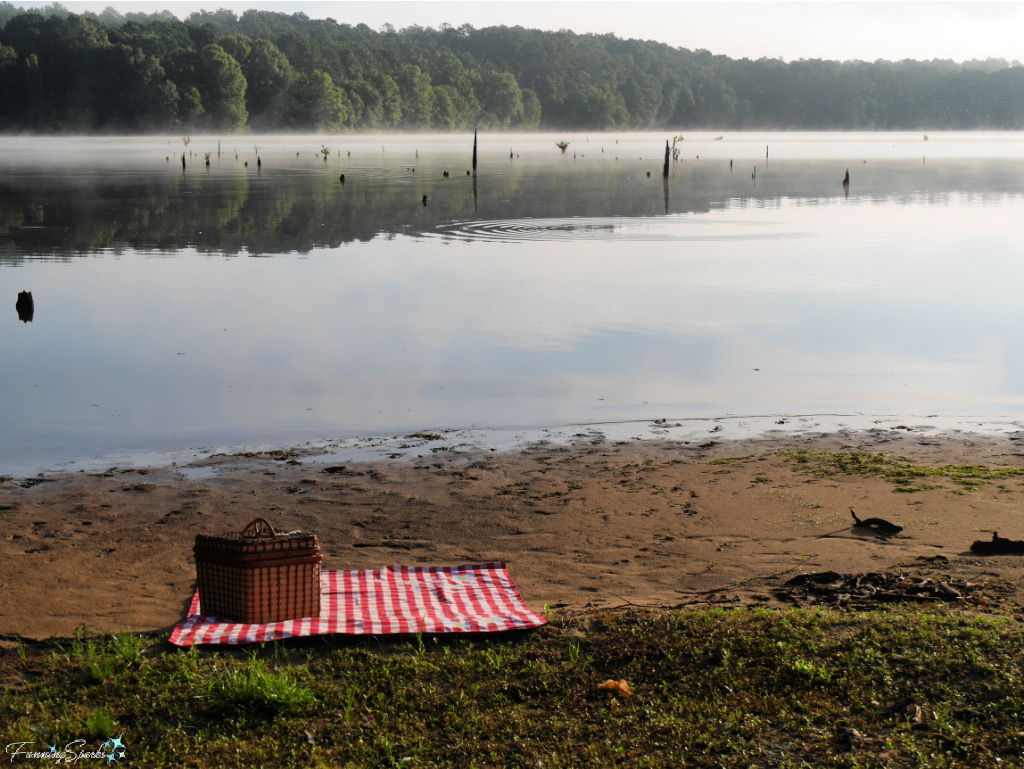
…tasty food and drink, a leisurely pace and a few key items for comfort. Enjoyable company even if it’s only your own. Nowadays, a location that is safely distant from others. Amusing ways to relax… kayaking, bird watching, reading, exploring, taking photos, watching the sunrise, playing games… or simply napping.

A thoughtfully designed picnic blanket is one of the key items for comfort. A picnic blanket should provide a protected place to sit—keeping moisture, bugs and pokey things at bay. It should be durable, easy care and machine washable. It should be lightweight and easy to carry. It should be generously-sized. And if it’s pretty and attractive that’s even better.
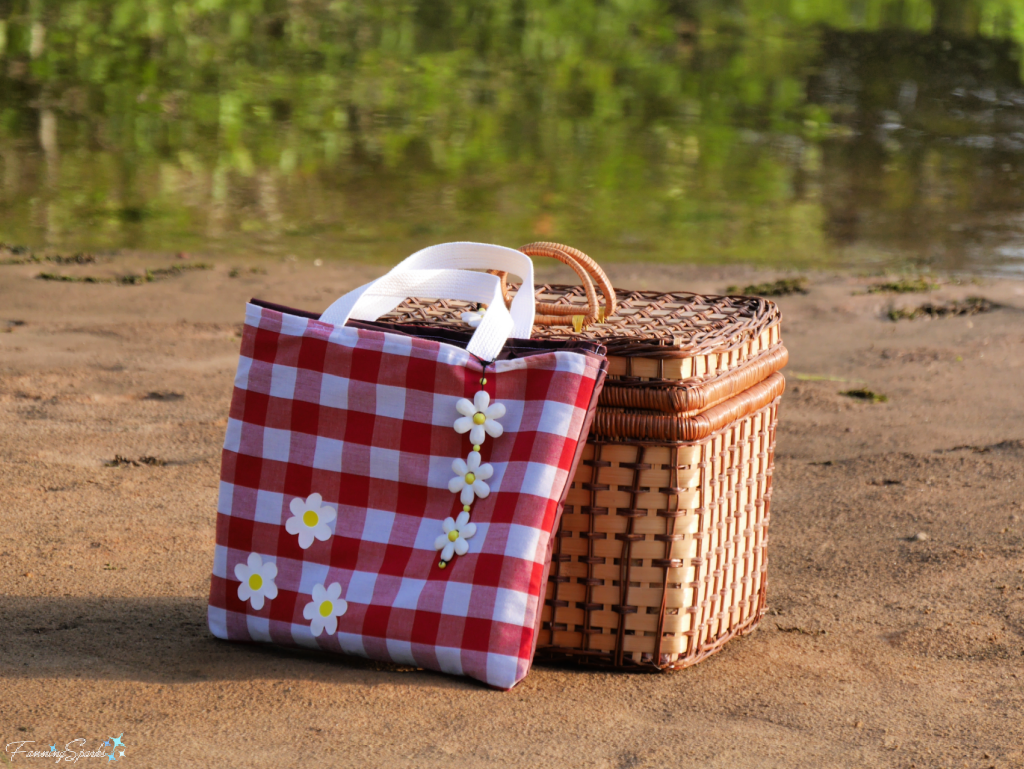 I think the picnic blanket featured in today’s post delivers on all that. Plus it’s easy to make with the step-by-step instructions provided below. Why not give it a try?
I think the picnic blanket featured in today’s post delivers on all that. Plus it’s easy to make with the step-by-step instructions provided below. Why not give it a try?
Supplies Needed
The following supplies will be needed to make the Ultimate Picnic Blanket:
. Decorative Cotton Fabric 2 yards of 45” wide A simple 100% cotton in your choice of pattern, color and design. I chose a large-checked gingham in red and white.
. Waterproof Backing Fabric 1 ¾ yards of 58” wide This is the secret ingredient of this picnic blanket. I chose a dark maroon-colored, coated taffeta which is a lightweight coated nylon. It’s designed for rain gear, tarps, tent flies and other camping gear. It’s machine-washable in warm/cold on the gentle cycle and partially machine-dryable on low. I ordered the coated taffeta online from The Rain Shed (see More Info below).
. Belting – 30” of 1” wide cotton belting This allows for 2 carrying handles. My original version of this Picnic Blanket had only 1 handle but it gaped open and was cumbersome to carry.
. Thread
. Iron-on Vinyl aka Heat Transfer Vinyl (optional) I purchased 1 – 12” x 24” sheet of white HTV and 1 – 12” x 12” sheet of yellow HTV for the daisy design shown but used only about half. There are various brands of heat transfer vinyl but I recommend Siser Classic Easyweed. Embellishing the picnic blanket with daisies is, of course, completely optional.
. Parchment Paper Used to apply the Heat Transfer Vinyl
. Beaded Trim (optional) The beaded daisy trim shown below is from the InBloom Bead Designs line from Hobby Lobby. It was a clearance section score from a few years ago and, unfortunately, doesn’t appear to be available. I used it as a fun accent on the carrying handle. Any type of trim, such as tassels, pompoms, or brightly colored ribbons, will work equally well.
. Paper Used to cut out design motifs
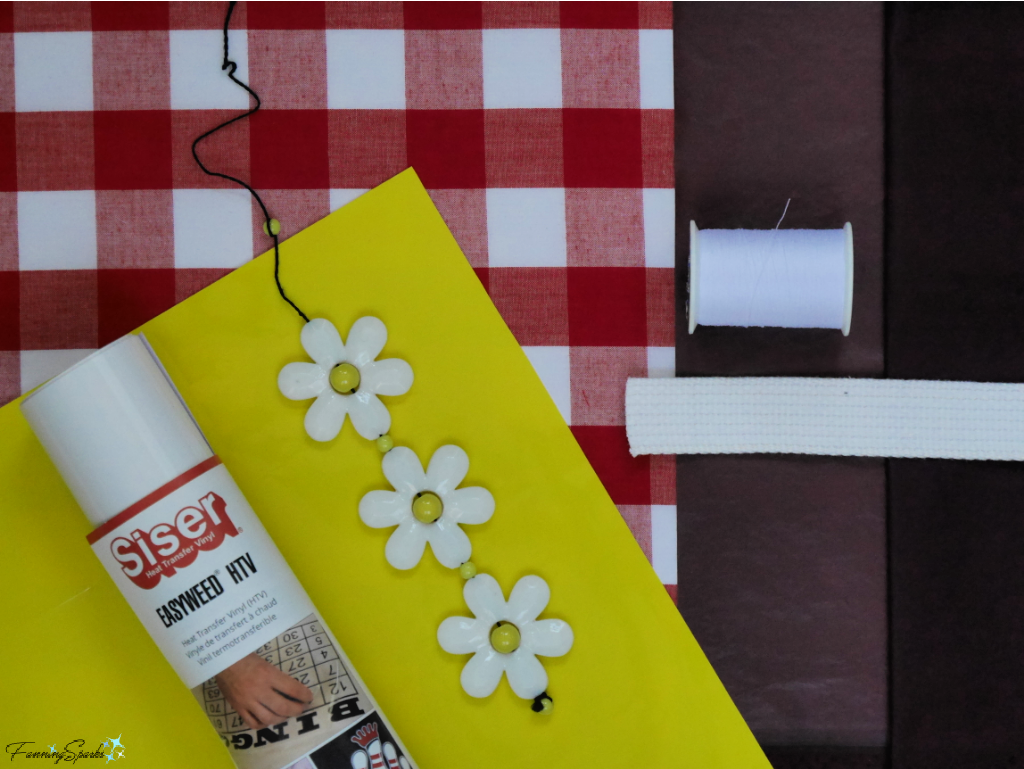 Tools and Equipment Needed
Tools and Equipment Needed
The following tools and equipment will be needed:
. Measuring Tape or Yardstick
. Scissors or Rotary Cutter with Mat
. Cutting Machine or Scissors I use a Cricut Explorer.
. Iron
. Sewing Machine
. Small Scissors or Snips for cutting threads
. Fabric Marker I love the Pilot FriXion Marker
. Straight Pins
. Seam Turner or Craft/Popsicle Stick.
Step 1 Determine Design. Determine the style and design for your Picnic Blanket. Select appropriate materials. I choose a classic red-and-white check with a cheerful daisy motif. My main fabric is 100% cotton in a large red-and-white gingham check. The backing is a maroon-colored coated taffeta. I chose to embellish the blanket and pillow with vinyl white and yellow daisies. A beaded daisy chain provided the perfect accent.
 Step 2 Cut Fabric Cut the following 4 rectangles of fabric:
Step 2 Cut Fabric Cut the following 4 rectangles of fabric:
. 1 – 45” x 57” rectangle from the decorative cotton fabric for the Blanket Top
. 1 – 15 ½” x 12½” rectangle from the decorative cotton fabric for the Pocket Front
. 1 – 45” x 57” rectangle from the waterproof backing fabric for the Blanket Backing
. 1 – 15 ½” x 12½” rectangle from the waterproof backing fabric for the Pocket Backing.
Step 3 Layout Design Cut out design motifs from paper and pin in place on the Blanket Top. Adjust until the layout is pleasing. I chose to position daisies in all 4 corners of the Blanket Top; each corner has a different number and arrangement.
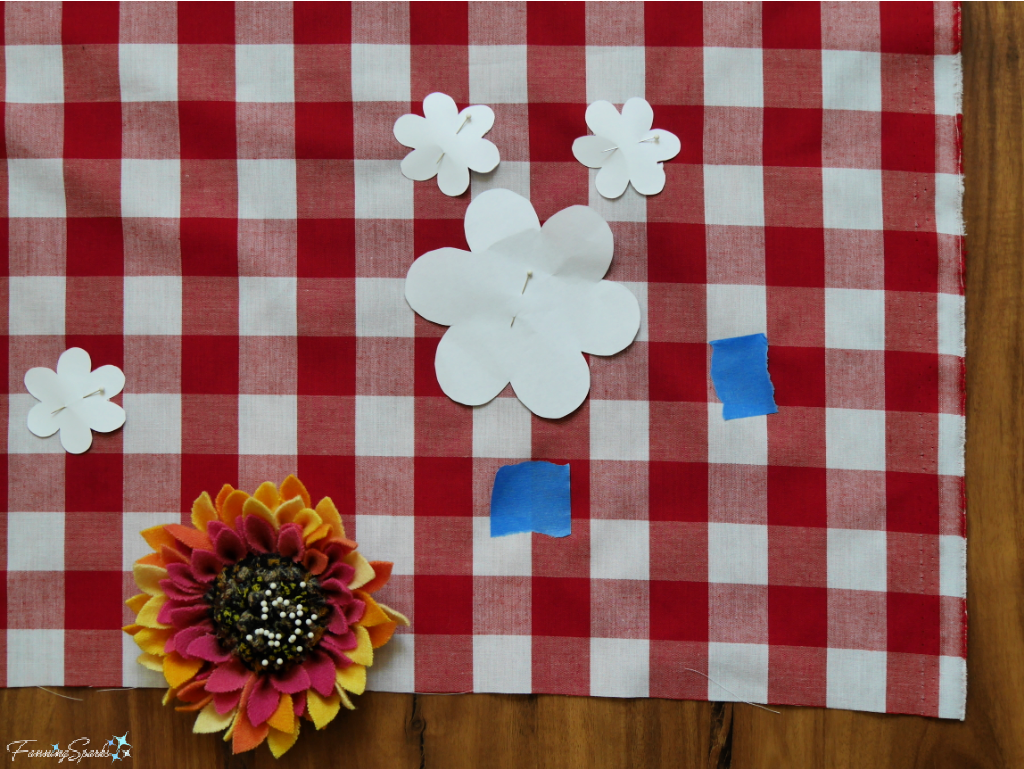 Step 4 Adhere Vinyl Daisies The daisy motif is made from heat transfer vinyl (HTV). HTV can be purchased in sheets or rolls. It can be cut with a cutting machine (such as a Cricut Explorer) or cut with scissors. HTV is an iron-on vinyl, which is available in a variety of brands and colors. Siser Classic Easyweed HTV brand seems to have the best reviews and, after working with it a few times, I would recommend it as well. If you’re not familiar with HTV, here’s a short explanation.
Step 4 Adhere Vinyl Daisies The daisy motif is made from heat transfer vinyl (HTV). HTV can be purchased in sheets or rolls. It can be cut with a cutting machine (such as a Cricut Explorer) or cut with scissors. HTV is an iron-on vinyl, which is available in a variety of brands and colors. Siser Classic Easyweed HTV brand seems to have the best reviews and, after working with it a few times, I would recommend it as well. If you’re not familiar with HTV, here’s a short explanation.
HTV has two layers; a layer of clear shiny “carrier” and a thin layer of colored vinyl (white and yellow in this case). The electronic cutter cuts the design in the thin colored vinyl while leaving the carrier layer intact. The carrier layer is used to position the design on the fabric and then removed after pressing. When cutting HTV, it’s important to place the HTV with the thin colored vinyl side UP on the cutting mat. This means the clear shiny carrier layer is facing down.
Step 4a) Cut Daisy. Use the cutting machine to cut the daisy from white HTV. Leave the center of the daisy intact. Use scissors to trim a generous border around the daisy so it’s easy to manipulate. Remove the excess white vinyl leaving only the white daisy on the carrier layer. Repeat this process to cut a circle for the flower center from the yellow HTV.
Alternatively, use scissors instead of a cutting machine. Cut out the white daisy flower and the yellow center with scissors cutting through both layers of the HTV. Adhere to the fabric in the same way described below with one exception. Because the carrier layer will be the same size and shape as the colored vinyl, the carrier layer will not stick to the fabric. Instead simply remove the carrier layer and place the colored vinyl directly on the fabric, taking care to position in the desired location.
Step 4b) Pre-heat Fabric. Pre-heat the Blanket Top fabric by pressing with a hot iron set on cotton (or whatever setting is appropriate for the fabric being used). Do not use steam.
Step 4c) Place white daisy. Press 2 seconds. Hot peel. Position a white daisy on the Blanket Top in the desired location with the white vinyl facing down and the sticky side of the carrier layer stuck to the fabric. Use hands to smooth into place. Cover the carrier layer with parchment paper. Press the hot iron down firmly, moving around very slowly, for 2 seconds. Lift the parchment paper and remove the carrier layer from the daisy (being careful of the hot surfaces). The white daisy should be attached to the fabric.
Step 4d) Place yellow center. Press 2 seconds. Hot peel.
Position the yellow flower center on top of the white daisy. Place it with the yellow vinyl facing down and the sticky side of the carrier layer stuck to the white daisy. Use hands to smooth into place. Cover all HTV with parchment paper. Press the hot iron down firmly, moving around very slowly, for 2 seconds. Lift the parchment paper and remove the carrier layer from the yellow center (being careful of the hot surfaces). The yellow center should be attached to the white daisy.
Step 4e) Press 8 seconds. Cover all HTV with parchment paper. Press the hot iron down firmly, moving around very slowly, for 8 seconds. Let cool.
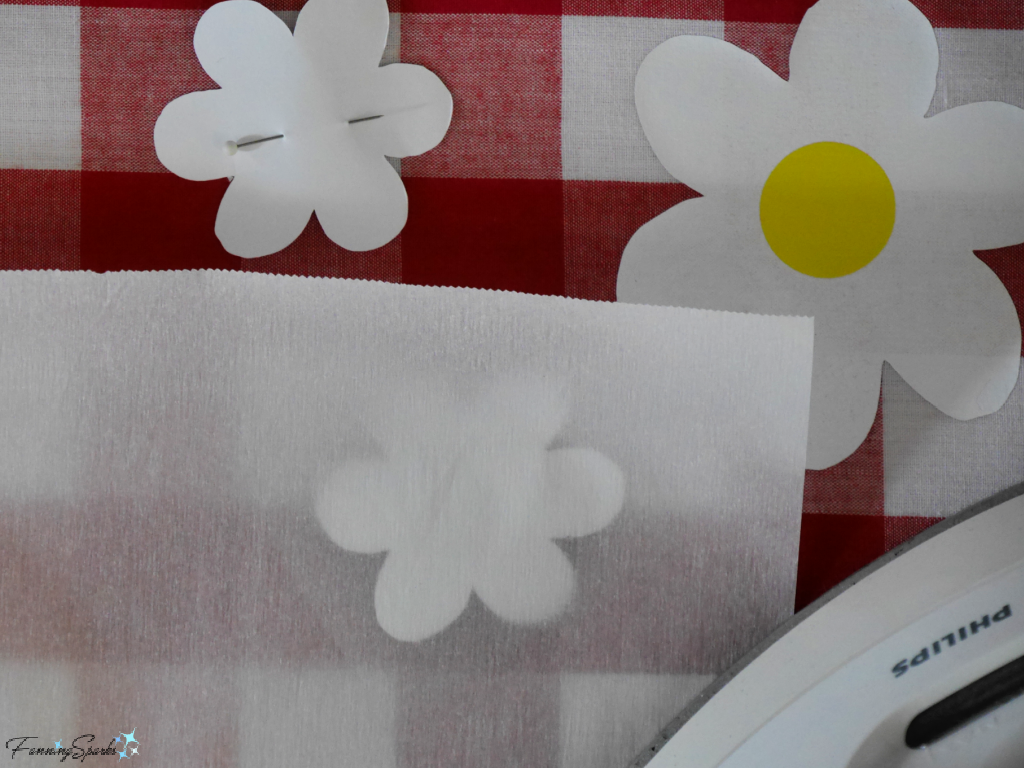 Step 4f) Repeat for all daisies.
Step 4f) Repeat for all daisies.
NOTE: The coated taffeta of the Blanket Backing should not be pressed with a hot iron so HTV can be adhered to the cotton fabric of the Blanket Top only.
Step 5 Attach Blanket Top to Backing Lay Blanket Top with right side facing up and top edge along top of work surface. Position the Blanket Backing over the Blanket Top with right side facing down. Align all edges. Pin edges taking care not to puncture the main section of the coated taffeta fabric with pins; instead place pins inside the seam allowance. Prepare to leave three openings when sewing the two Blanket pieces together.
. 1 opening will be used for turning the blanket right side out. It should be about 6”-8” long and positioned along the center of bottom edge.
. 2 openings will be used to insert the belting for a handle. They will be positioned along the top edge. Measure from the top left edge and mark at 17”, 19”, 22 ½ “, and 24 ½”. One unsewn gap should be between the 17” and 19” marks. The other unsewn gap should be between the 22 ½” and 24 ½” marks. Slide pins into these sections as a reminder not to sew here.
Sew around the Blanket with a ¼ “ seam allowance.
TIP: The slipperiness of the coated taffeta fabric can be a little tricky to sew. Place the decorative cotton fabric on the bottom and the coated taffeta on the top to make it easier to feed the fabric through the sewing machine. A non-stick presser foot is also helpful.
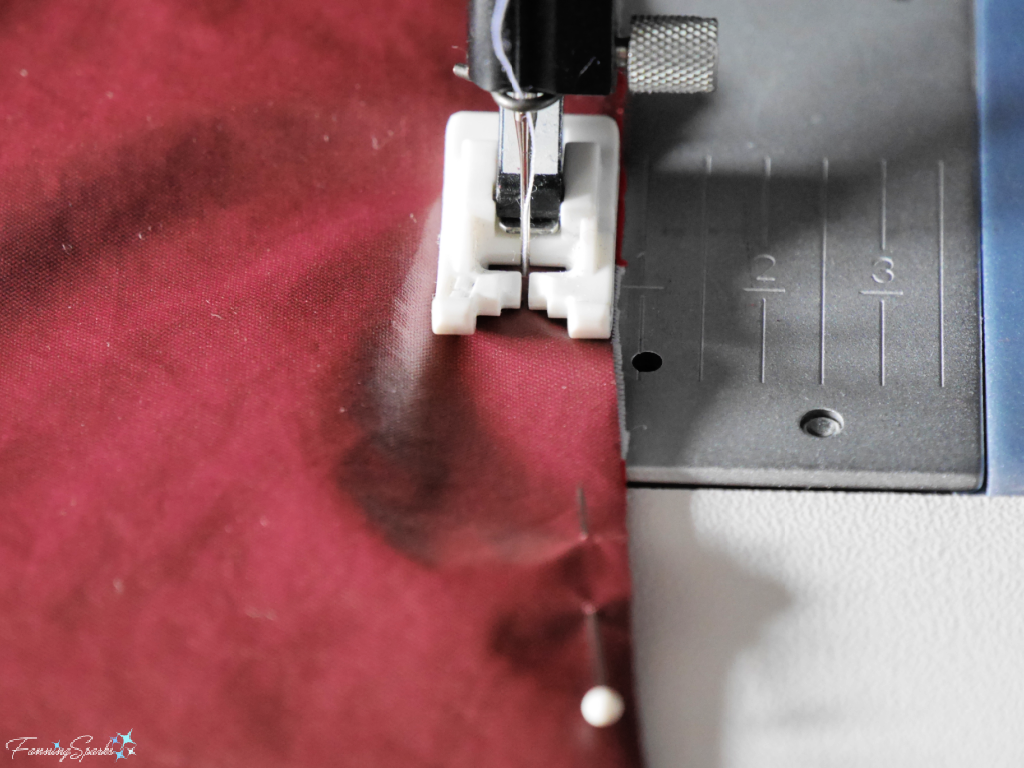 Step 6 Turn Right Side Out Pull the blanket through the opening to turn it right side out. Use seam turner to push out seams and corners. Press for a crisp finished seam taking care not to overheat the coated taffeta on the Blanket Backing. Sew the opening closed. Topstitch close to edge all around the Blanket skipping the two small openings left for the belting (from Step 5). Here’s how a finished corner looks.
Step 6 Turn Right Side Out Pull the blanket through the opening to turn it right side out. Use seam turner to push out seams and corners. Press for a crisp finished seam taking care not to overheat the coated taffeta on the Blanket Backing. Sew the opening closed. Topstitch close to edge all around the Blanket skipping the two small openings left for the belting (from Step 5). Here’s how a finished corner looks.
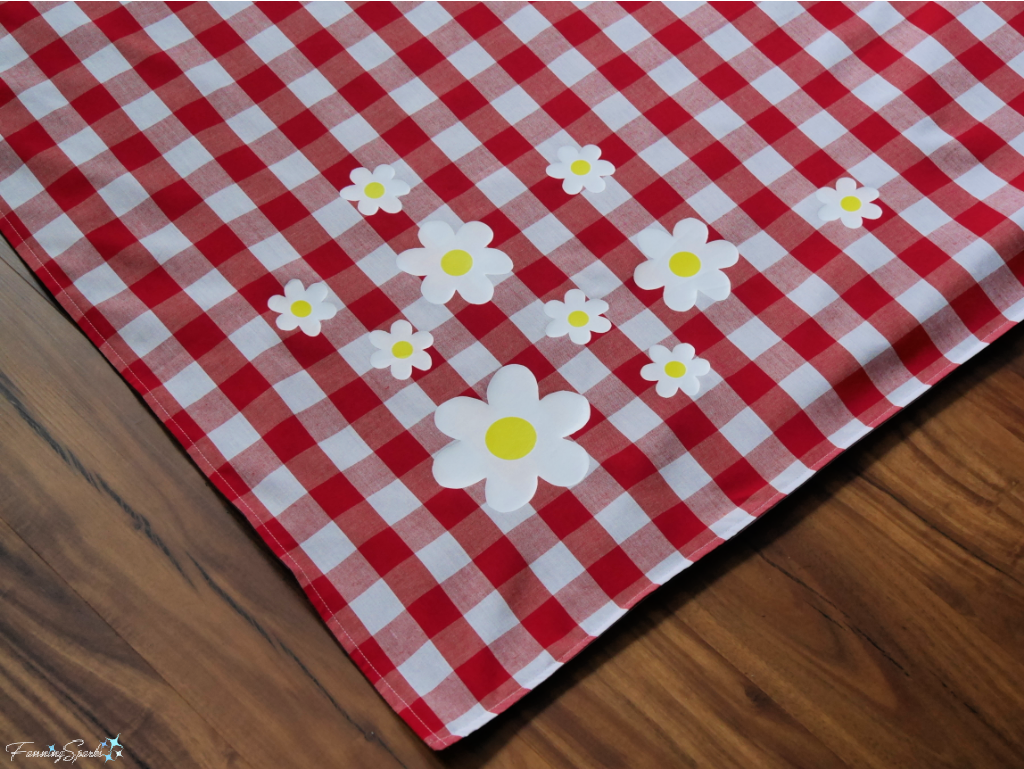 Step 7 Prepare Pocket Gather pieces for the Blanket Pocket including the decorative cotton fabric Pocket Front and the coated taffeta Pocket Backing. Cut 2 pieces of 1” belting each measuring 14”. Adhere HTV daisies to Pocket Front following method outlined above in Step 4. Use the zigzag stitch on the sewing machine to overcast the ends of the belting and prevent fraying.
Step 7 Prepare Pocket Gather pieces for the Blanket Pocket including the decorative cotton fabric Pocket Front and the coated taffeta Pocket Backing. Cut 2 pieces of 1” belting each measuring 14”. Adhere HTV daisies to Pocket Front following method outlined above in Step 4. Use the zigzag stitch on the sewing machine to overcast the ends of the belting and prevent fraying.
Step 8 Attach First Handle to Pocket Lay Pocket Front right side up with top edge along top of work surface. Measure and mark 5” from both outer edges. Take one of the pieces of belting and center each end over a 5” mark. Align ends of belting with the top edge of the fabric inserting ¼“ of belting into seam. Ensure belting is not twisted; same side of belting should be on the inside edge of both ends. Lay Pocket Backing, with right side facing down, on top of the Pocket Front. Align all edges. Pin.
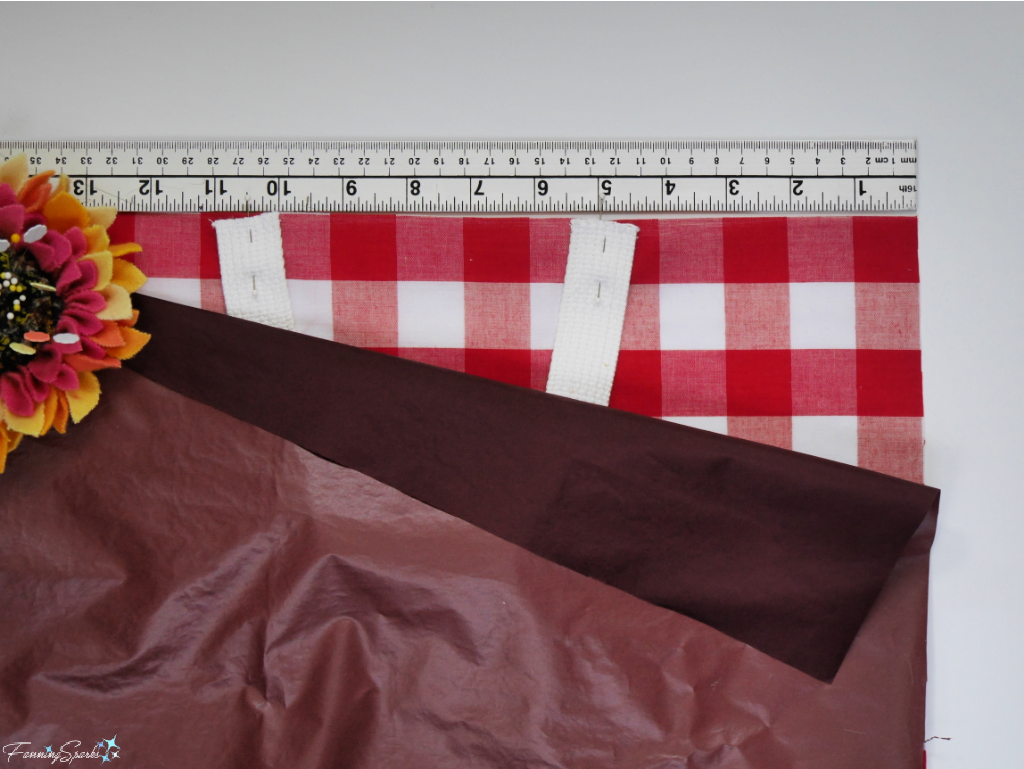 Sew all around the Pocket edges with a ¼“ seam allowance leaving a 4-6” opening along the bottom edge. Turn Pocket right side out. Use seam turner to push out seams and corners. Press for a crisp finished seam taking care not to overheat the coated taffeta on the Blanket Backing. Sew the opening closed. Topstitch close to edge all around the Pocket. Reinforce handle with a second row of stitching.
Sew all around the Pocket edges with a ¼“ seam allowance leaving a 4-6” opening along the bottom edge. Turn Pocket right side out. Use seam turner to push out seams and corners. Press for a crisp finished seam taking care not to overheat the coated taffeta on the Blanket Backing. Sew the opening closed. Topstitch close to edge all around the Pocket. Reinforce handle with a second row of stitching.
Step 9 Attach Pocket Lay out Blanket with Blanket Backing facing up and the top edge along the top of the work surface. The openings for the belting (from Step 5) should be along the top edge. Measure and mark 13 ½ “ from top right along the top edge. Repeat about 11” down from top edge. Position Pocket, with Pocket Front facing down, on top of Blanket Backing with top edges aligned and right edge of Pocket at 13 ½ “ marks. Pin along seamlines.
 Sew around sides and bottom of Pocket leaving top edges open. Backstitch at top edges to reinforce.
Sew around sides and bottom of Pocket leaving top edges open. Backstitch at top edges to reinforce.
Step 10 Attach Second Handle to Blanket Lay Blanket Top facing up with top edge along top of work surface. The Pocket should be at the top of the work surface. Insert ¼” of belting into the openings (from Step 5). Take care to align second handle with the first handle. Ensure belting is not twisted; same side of belting should be on the inside edge of both ends. Pin in place.
Stitch top edge of Blanket across handle ends. Take care to stitch only the Blanket layer keeping Pocket pulled out of the way. Sew a second row of stitches to reinforce handle. The two handles should match and line up across the top of the Pocket.
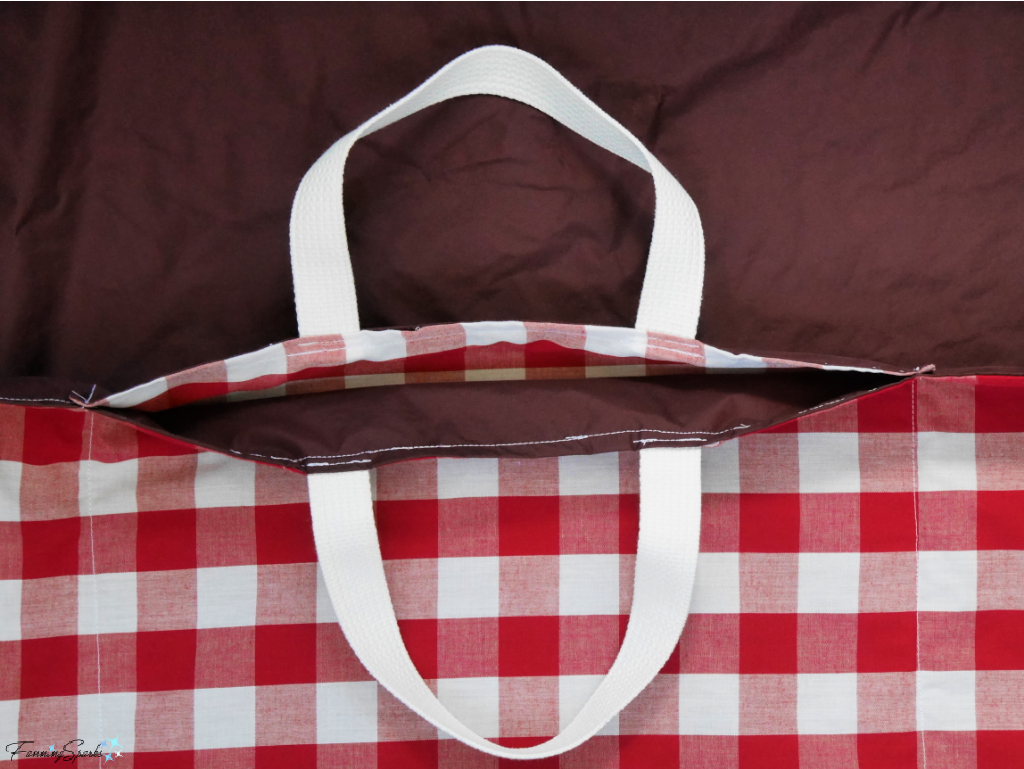 Step 11 Attach Trim Attach your trim of choice, beads, tassels, pompoms, ribbons, etc, with thread or string. It should be easy to remove before washing the Picnic Blanket. Simply tie a loop at the end of the string and then slip the trim through the loop and tighten.
Step 11 Attach Trim Attach your trim of choice, beads, tassels, pompoms, ribbons, etc, with thread or string. It should be easy to remove before washing the Picnic Blanket. Simply tie a loop at the end of the string and then slip the trim through the loop and tighten.
 Your Ultimate Picnic Blanket is ready to use! To fold the Blanket for easy carrying to your next picnic:
Your Ultimate Picnic Blanket is ready to use! To fold the Blanket for easy carrying to your next picnic:
1. Hold up the Picnic Blanket, a corner in each hand, with the handles hanging down from the bottom edge.
2. As you fold, keep Pocket to the outside. Bring hands together to fold Picnic Blanket in half. Fold again. Fold Picnic Blanket in half horizontally. Fold again.
3. The folded Picnic Blanket should now be the same size as the Pocket with the Pocket on the outside. Insert hand into Pocket and grab Blanket at the bottom of the Pocket. Turn Pocket inside out pulling Blanket into Pocket. Smooth Blanket pushing out corners from inside.
It’s that simple!
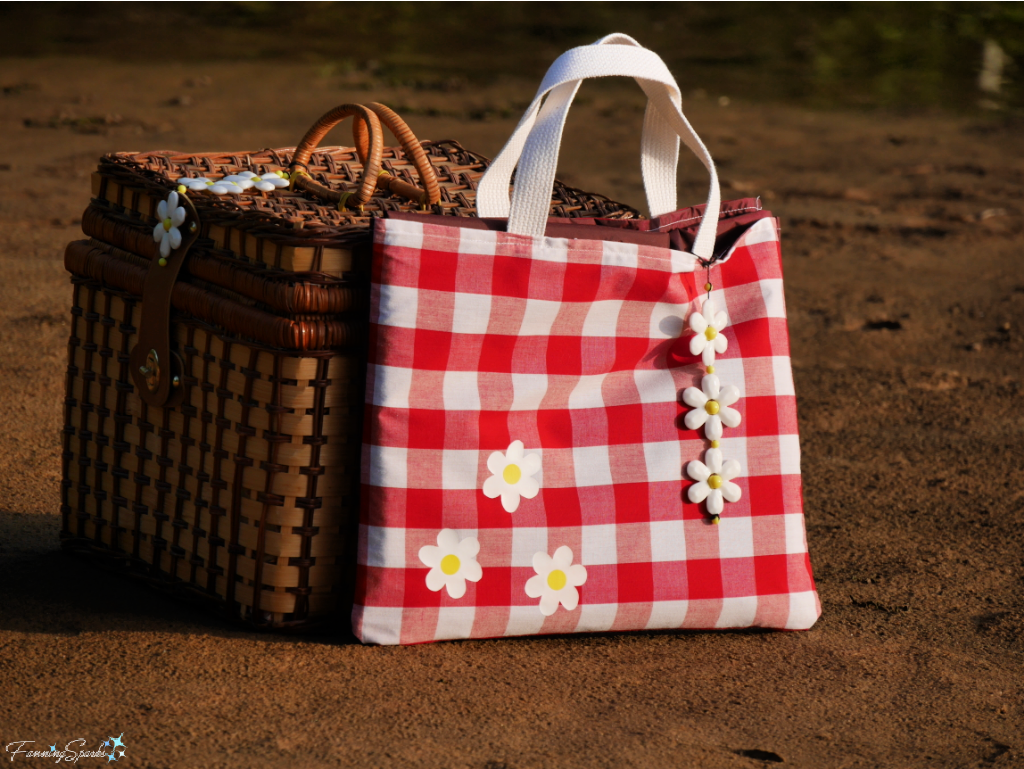
You may want to take a few extra minutes to make a small pillow to match your new Picnic Blanket. Check out the post, Basic Pillow DIY Tutorial, for step-by-step instructions to make a decorative envelope pillow. Simply substitute fabrics and embellishments to match your Picnic Blanket and follow the construction process. 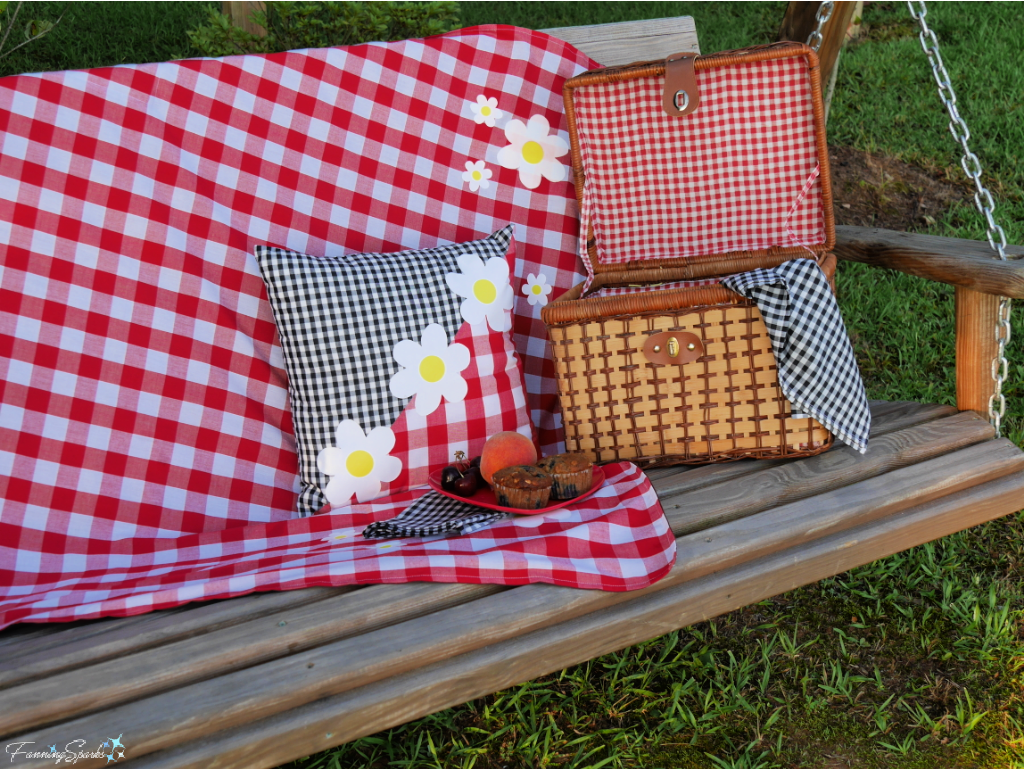
More Info
Please share this image or pin for future reference.
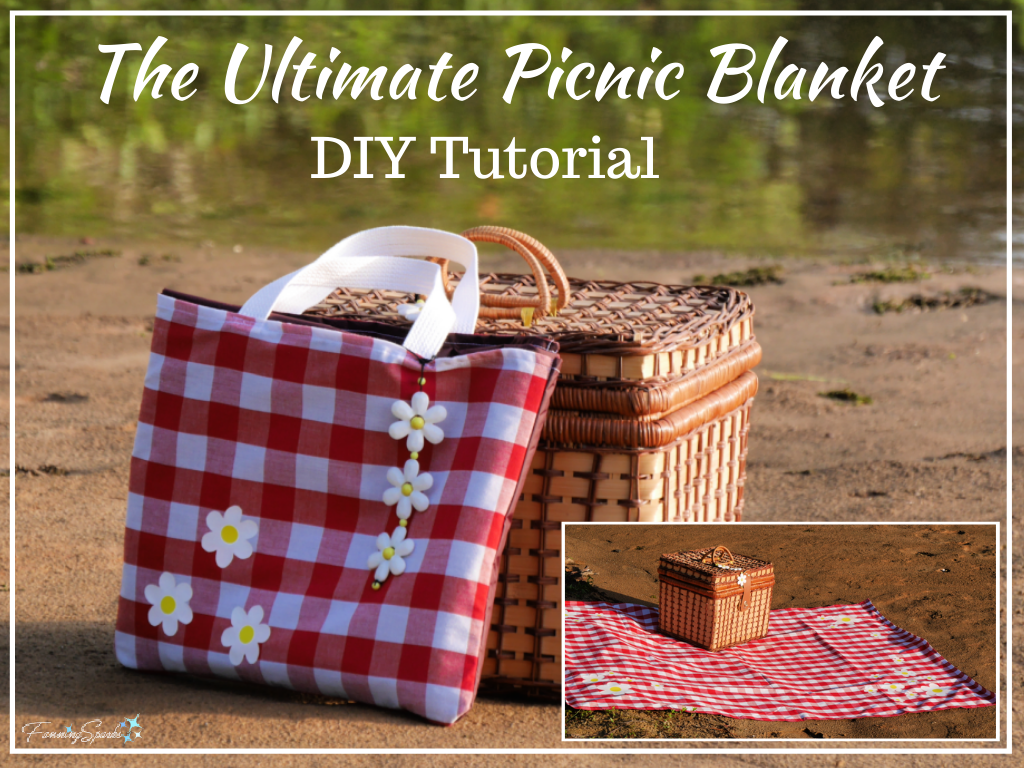
The Ultimate Picnic Blanket debuted in the Sunrise Breakfast Picnic post. Picnics were also featured in the posts: Picnic Under the Wisteria and A Colorful Backyard Picnic.
The coated taffeta fabric used for the Picnic Blanket Backing can be purchased from The Rain Shed. Look under Coated Fabrics in the Fabrics section. The Rain Shed has lots of difficult to find supplies and materials for outdoor activities. They even sell patterns for cool things like gaiters, rain chaps and umbrellas.
Today’s Takeaways
1. A picnic is an ideal way to enjoy the outdoors.
2. The Ultimate Picnic Blanket could make your next picnic more comfortable.
3. Even a simple handmade item, like a picnic blanket, is an opportunity to get creative.


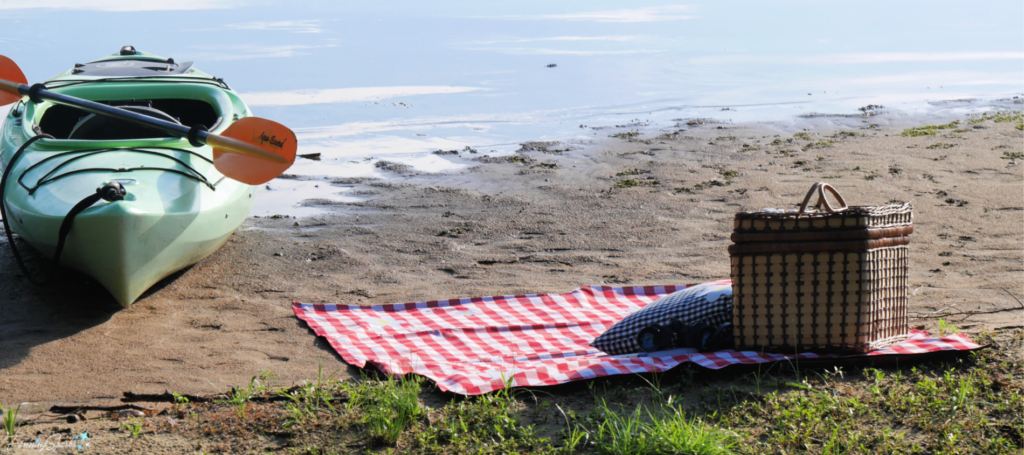
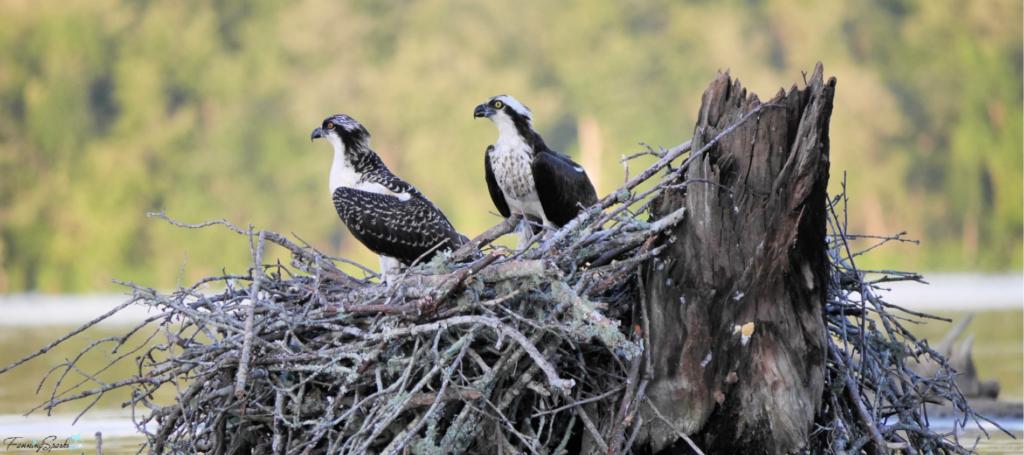
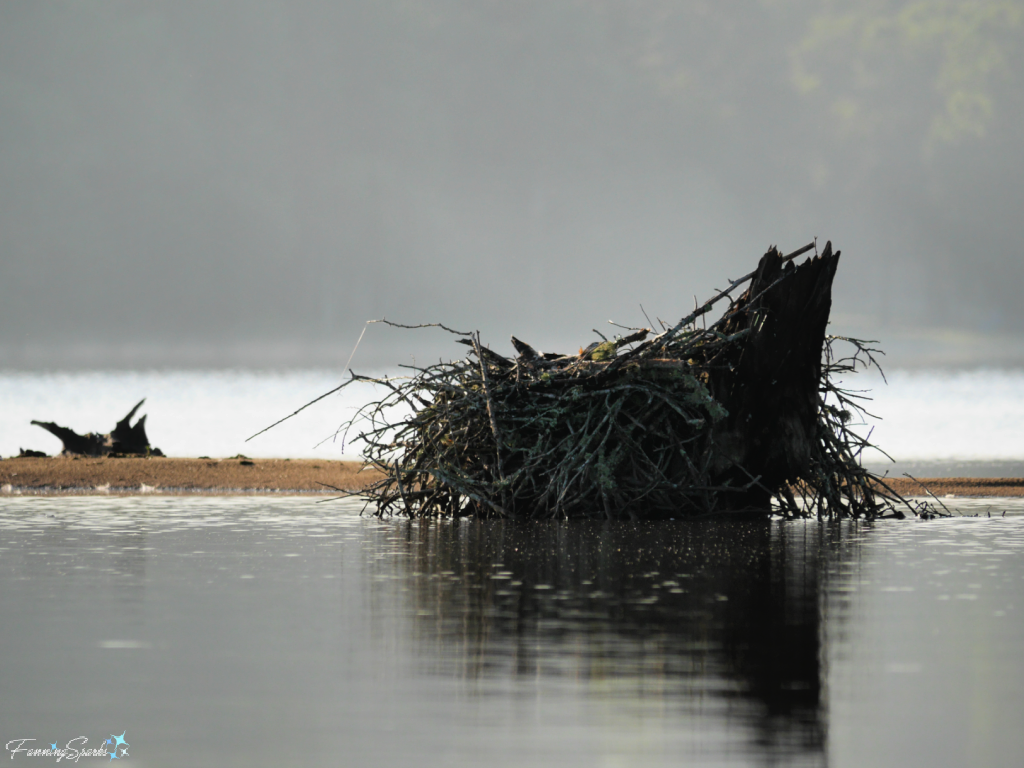
 But then I got curious and decided to go back for a closer look the next day. There were two osprey!
But then I got curious and decided to go back for a closer look the next day. There were two osprey!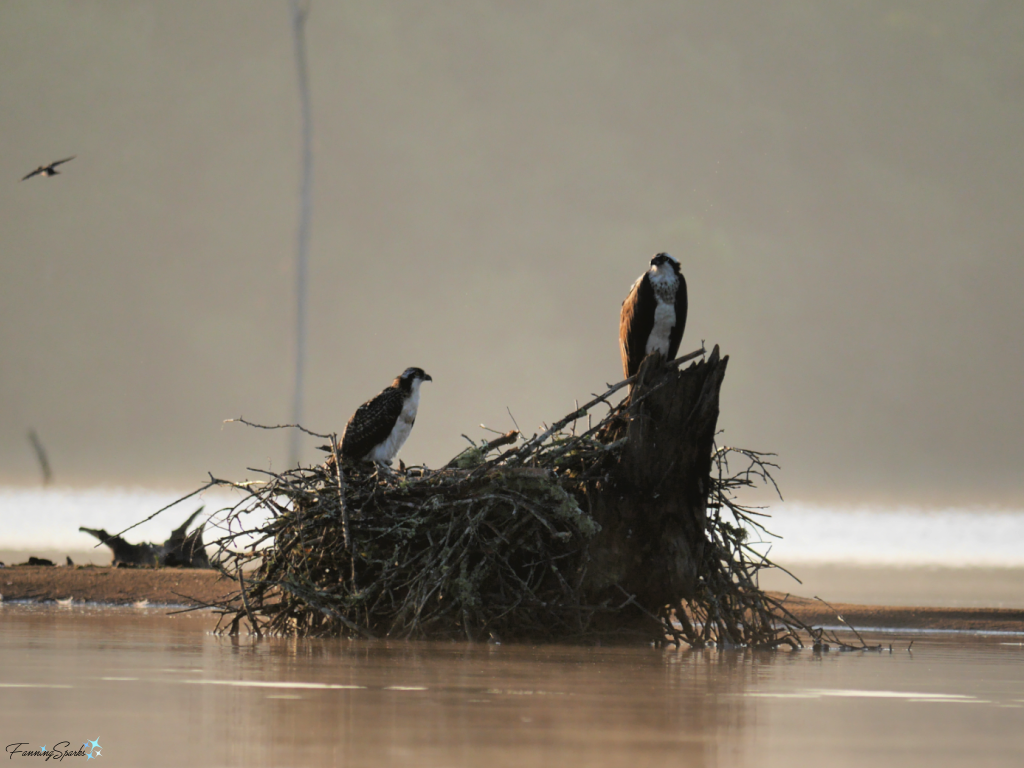 I’ve been back several times and have taken hundreds of photos of these two birds. One is an adult and the other is a juvenile. I assume the adult is female since they typically guard their young during the nestling period. Here’s one of my favorite shots of the mother (on right) and her chick (on left).
I’ve been back several times and have taken hundreds of photos of these two birds. One is an adult and the other is a juvenile. I assume the adult is female since they typically guard their young during the nestling period. Here’s one of my favorite shots of the mother (on right) and her chick (on left).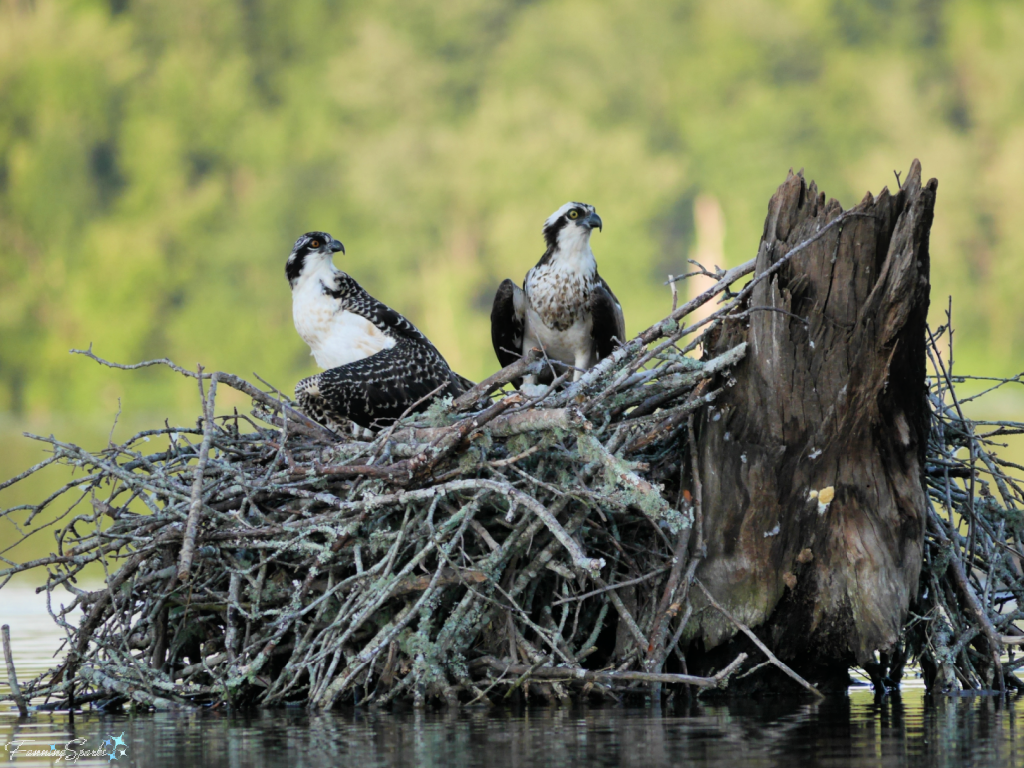
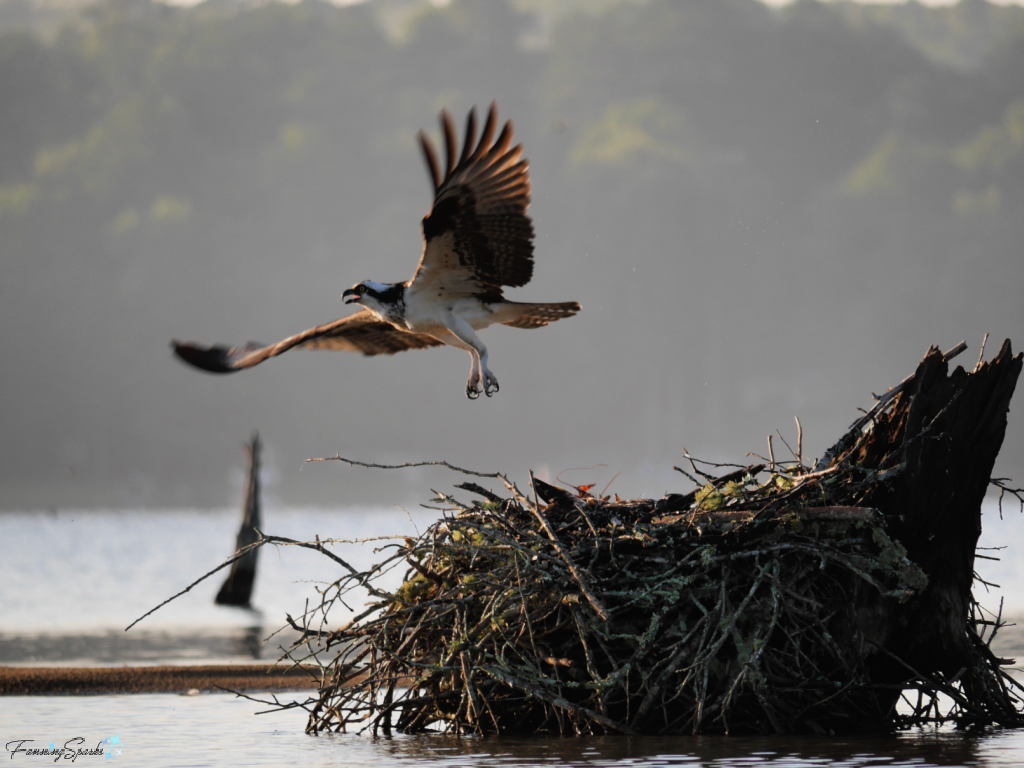 The juvenile osprey can’t fly yet so it hides in the nest. It blends in perfectly but its red eye is just visible (at center).
The juvenile osprey can’t fly yet so it hides in the nest. It blends in perfectly but its red eye is just visible (at center).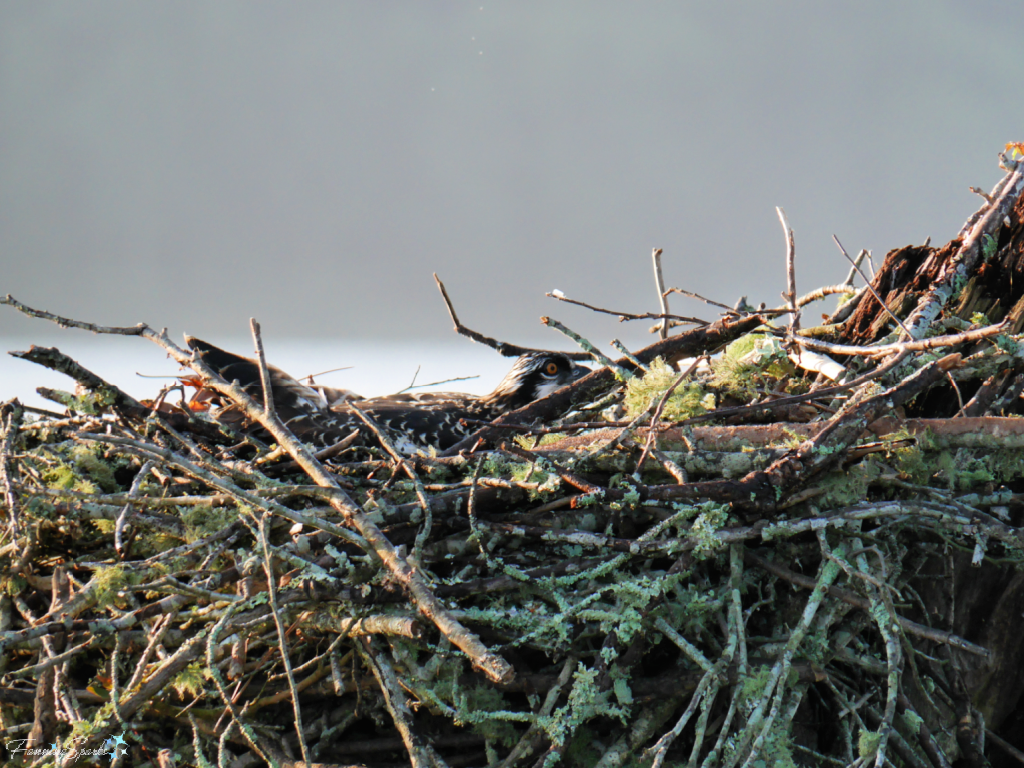 If I wait long enough, the juvenile osprey will come out of hiding. It seems to be impatient to fly and appears to be practicing. Several times, it has taken a few powerful, hops while frantically flapping its wings. On my most recent visit, it actually achieved liftoff! But it was a very short flight! These 3 photos were taken back-to-back over 10 seconds. It was awesome to watch!
If I wait long enough, the juvenile osprey will come out of hiding. It seems to be impatient to fly and appears to be practicing. Several times, it has taken a few powerful, hops while frantically flapping its wings. On my most recent visit, it actually achieved liftoff! But it was a very short flight! These 3 photos were taken back-to-back over 10 seconds. It was awesome to watch! Osprey (Pandion haliaetus) are fish-eating birds of prey. They are raptors similar to eagles, vultures and other hawks. The osprey has an astonishing ability to high dive into water to catch fish. The Royal Society for the Protection of Birds describes it this way: “The osprey…will fly above the water’s surface to locate fish, sometimes gliding and soaring up to 70 metres [approx. 230 feet or 20 building stories] high. The exact catching technique varies with the type of fish, but they all involve a nearly vertical plunge dive with wings half-folded and feet thrown forward at [the] last moment. The fish are caught in talons after a dive to a maximum depth of 1m [approx. 3 feet]. The fish is held head first, like a torpedo, when carried to a perch or to the nest.” I’ve had the pleasure of watching the osprey’s aerial dive from a distance but it happens in a split-second and actually capturing it on camera seems pretty unlikely. But that doesn’t mean I won’t continue to try.
Osprey (Pandion haliaetus) are fish-eating birds of prey. They are raptors similar to eagles, vultures and other hawks. The osprey has an astonishing ability to high dive into water to catch fish. The Royal Society for the Protection of Birds describes it this way: “The osprey…will fly above the water’s surface to locate fish, sometimes gliding and soaring up to 70 metres [approx. 230 feet or 20 building stories] high. The exact catching technique varies with the type of fish, but they all involve a nearly vertical plunge dive with wings half-folded and feet thrown forward at [the] last moment. The fish are caught in talons after a dive to a maximum depth of 1m [approx. 3 feet]. The fish is held head first, like a torpedo, when carried to a perch or to the nest.” I’ve had the pleasure of watching the osprey’s aerial dive from a distance but it happens in a split-second and actually capturing it on camera seems pretty unlikely. But that doesn’t mean I won’t continue to try.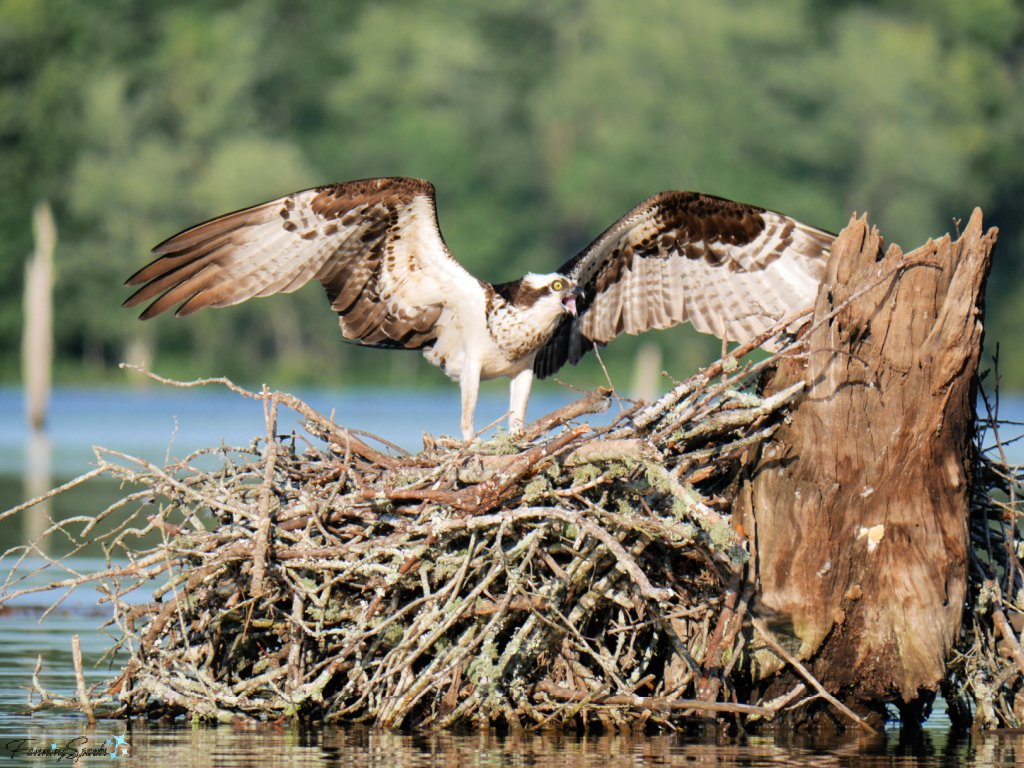 3. Be Stealthy. Obviously, avoid scaring away the bird to be photographed. Approach carefully. Be quiet. Set the camera to silent mode. Step lightly. Move slowly. Make no sudden movements. Hide out of sight. Blend in. It’s impossible to hide my bright green, 10-ft kayak from a sharp-eyed osprey. But I’ve found that the osprey will calm down and resume normal activity when I wait patiently snuggled into the shrubs along the shoreline (shown at right below).
3. Be Stealthy. Obviously, avoid scaring away the bird to be photographed. Approach carefully. Be quiet. Set the camera to silent mode. Step lightly. Move slowly. Make no sudden movements. Hide out of sight. Blend in. It’s impossible to hide my bright green, 10-ft kayak from a sharp-eyed osprey. But I’ve found that the osprey will calm down and resume normal activity when I wait patiently snuggled into the shrubs along the shoreline (shown at right below).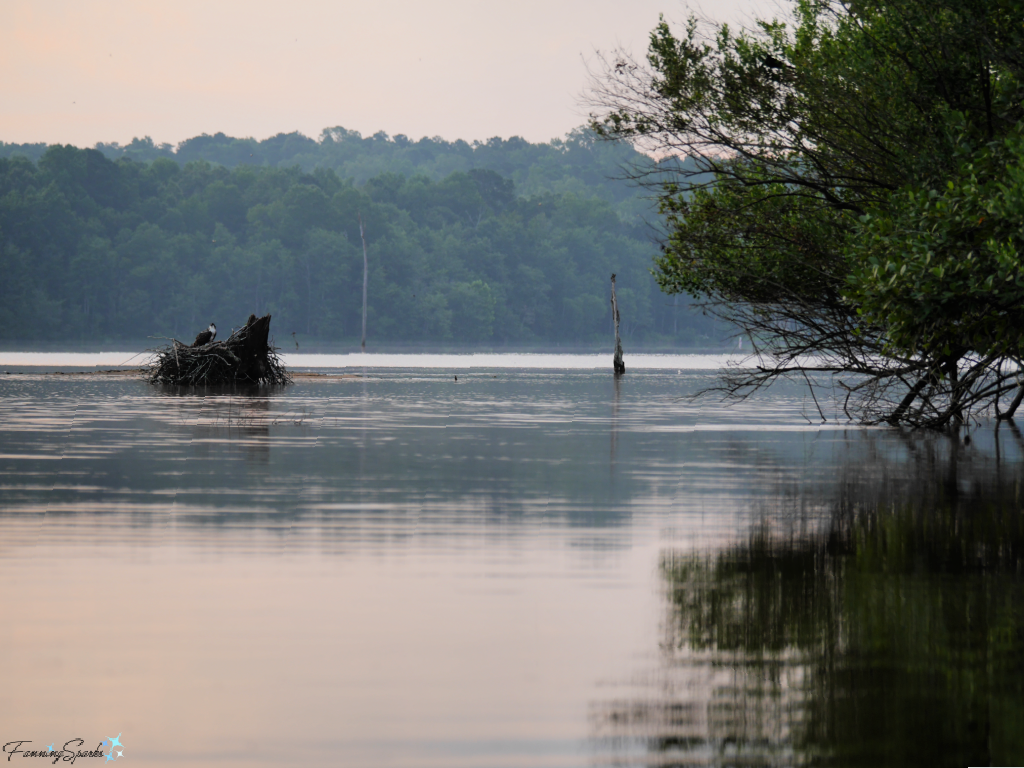
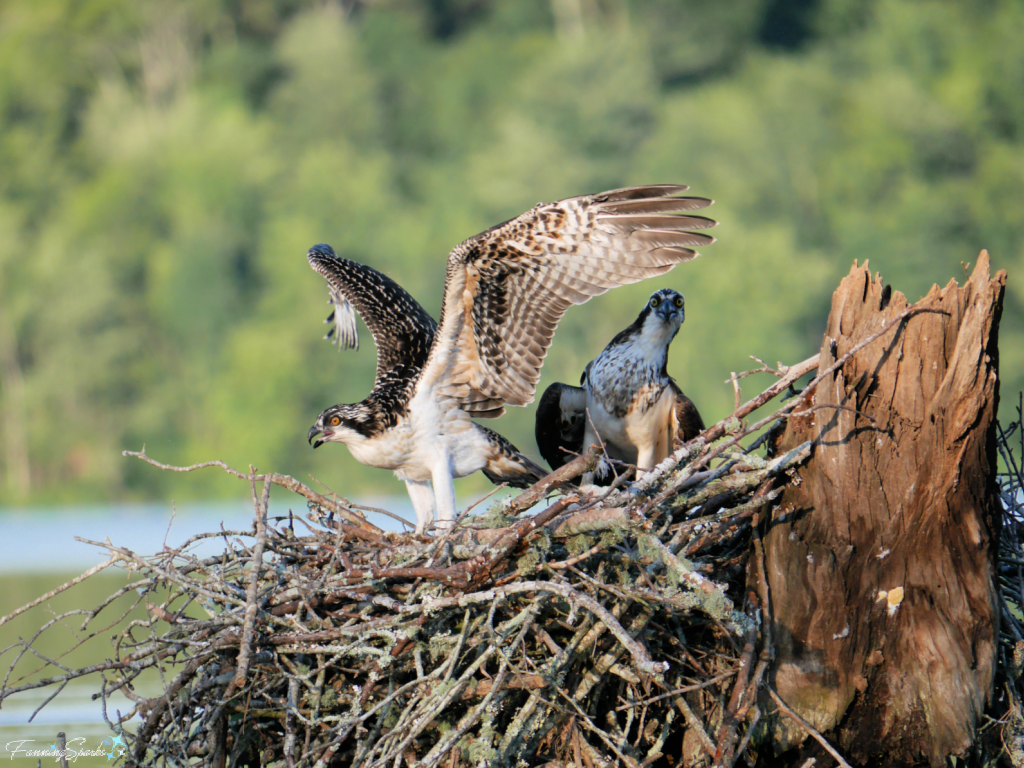 7. Research. Learn about the grooming, nesting, feeding, parenting and mating habits of the birds to be photographed. I’d visited the osprey nest several times and spotted only one adult and one juvenile osprey. I was completely unprepared when a third bird flew in and out of the scene. Luckily, I was able to wait long enough for the third osprey to come back. Turns out, it was delivering a fish and I caught the below amazing shot. After the fact, I learned that the male osprey is the major provider of fish for the female and young until the chicks are larger.
7. Research. Learn about the grooming, nesting, feeding, parenting and mating habits of the birds to be photographed. I’d visited the osprey nest several times and spotted only one adult and one juvenile osprey. I was completely unprepared when a third bird flew in and out of the scene. Luckily, I was able to wait long enough for the third osprey to come back. Turns out, it was delivering a fish and I caught the below amazing shot. After the fact, I learned that the male osprey is the major provider of fish for the female and young until the chicks are larger.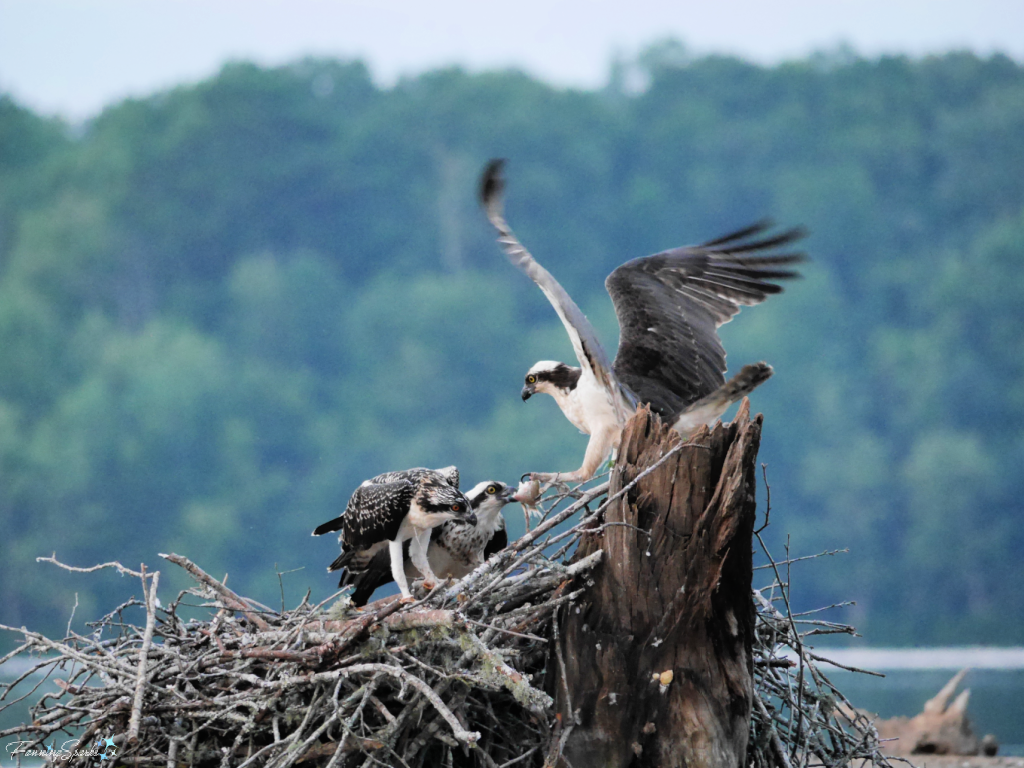 8. Be Curious. Visit the target location frequently and observe the birds over time. This practice will prepare you for the stages and special events in the bird’s natural cycles such as courting, nest building and raising young. Study their routines. How do they hunt/gather food? How do they feed it to their young? At what time? From where? What sounds do they make? What are their calls and songs? Osprey, for instance, have high-pitched whistling voices. Their calls, which are like a succession of chirps, will evolve into an intense squeal if they feel threatened. Become familiar with possible sites to identify the best vantage points and lighting conditions.
8. Be Curious. Visit the target location frequently and observe the birds over time. This practice will prepare you for the stages and special events in the bird’s natural cycles such as courting, nest building and raising young. Study their routines. How do they hunt/gather food? How do they feed it to their young? At what time? From where? What sounds do they make? What are their calls and songs? Osprey, for instance, have high-pitched whistling voices. Their calls, which are like a succession of chirps, will evolve into an intense squeal if they feel threatened. Become familiar with possible sites to identify the best vantage points and lighting conditions.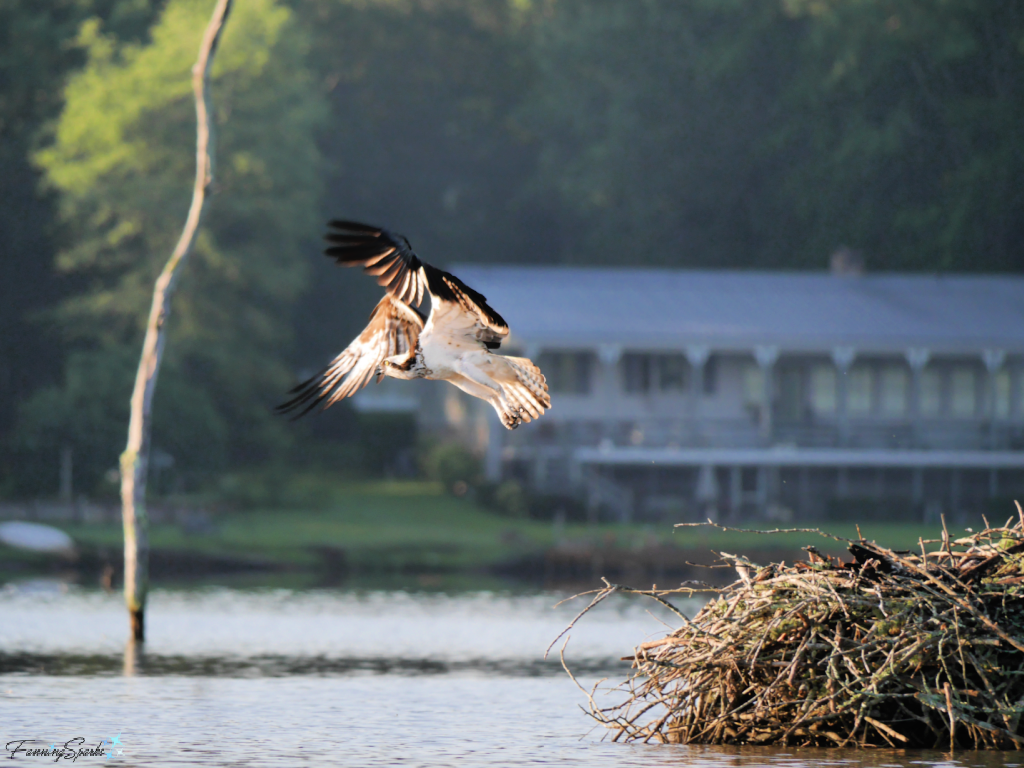
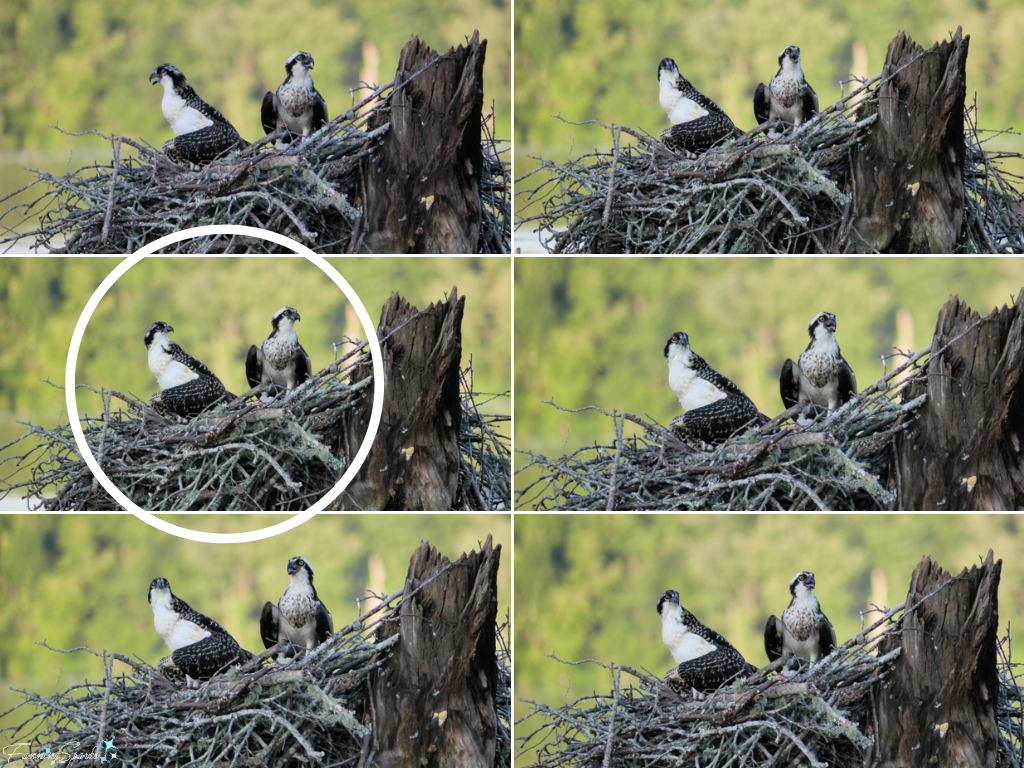 12. Be Ready and Alert. As difficult as it is to hold a camera steady with a finger on the shutter button for long periods of time, it’s necessary to catch the great shots. Of course, a tripod would make it much easier. I’m not geared up to use a tripod on my kayak, so I handhold my camera and lens. Holding it steady for 15 minutes at a time can be challenging! Staying focused and ready to shoot during that entire time can be even more challenging. But it’s worth the effort. It’s probably just a coincidence but it seems that every time I release my hands or look away, the birds change things up and I miss the shot! Here’s an example.
12. Be Ready and Alert. As difficult as it is to hold a camera steady with a finger on the shutter button for long periods of time, it’s necessary to catch the great shots. Of course, a tripod would make it much easier. I’m not geared up to use a tripod on my kayak, so I handhold my camera and lens. Holding it steady for 15 minutes at a time can be challenging! Staying focused and ready to shoot during that entire time can be even more challenging. But it’s worth the effort. It’s probably just a coincidence but it seems that every time I release my hands or look away, the birds change things up and I miss the shot! Here’s an example.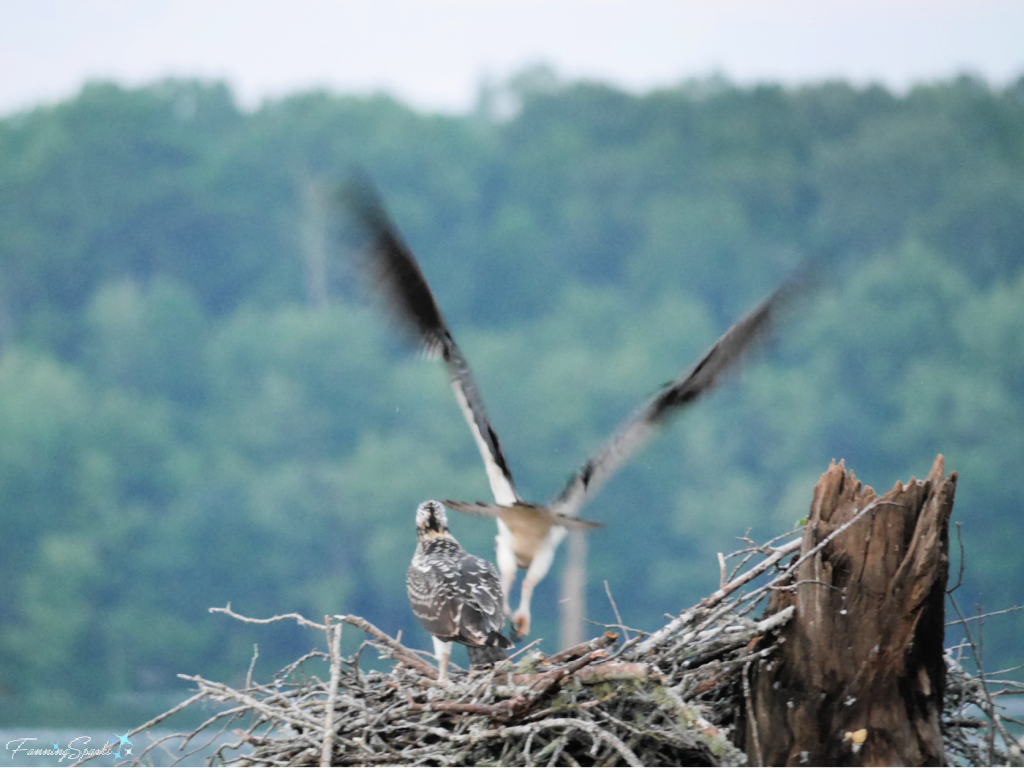 13. Compose the Shot. It’s easy to forget about good photo composition when scrambling to capture a shot. But all the rules about balance, unity, entrance and exit, lines, framing, breathing space, light, shade and so on still apply. It’s always better to leave room in the frame when a subject is looking off or moving towards to the side of the picture. So if a bird is flying into the frame from the right, compose the image so the bird is slightly to the right of center freeing up the majority of the left side for them to “fly into”. Here’s an example of how not to do it—notice how it looks like the osprey is about to fly off the image. The composition would have been better if it were framed along the white lines.
13. Compose the Shot. It’s easy to forget about good photo composition when scrambling to capture a shot. But all the rules about balance, unity, entrance and exit, lines, framing, breathing space, light, shade and so on still apply. It’s always better to leave room in the frame when a subject is looking off or moving towards to the side of the picture. So if a bird is flying into the frame from the right, compose the image so the bird is slightly to the right of center freeing up the majority of the left side for them to “fly into”. Here’s an example of how not to do it—notice how it looks like the osprey is about to fly off the image. The composition would have been better if it were framed along the white lines.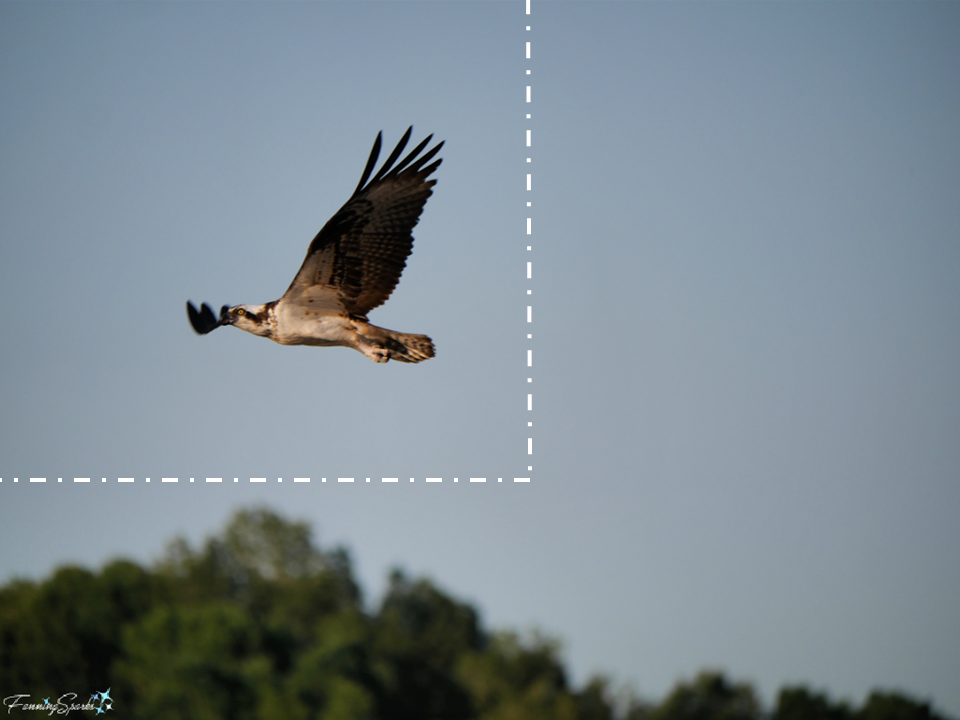 14. Be Patient. If there’s one thing I’ve learned about photographing wild birds, it’s patience. I’ve spent hours watching the osprey. Ironically, you often have to wait a long time to get a great shot but when it appears, you need to act in a split-second.
14. Be Patient. If there’s one thing I’ve learned about photographing wild birds, it’s patience. I’ve spent hours watching the osprey. Ironically, you often have to wait a long time to get a great shot but when it appears, you need to act in a split-second.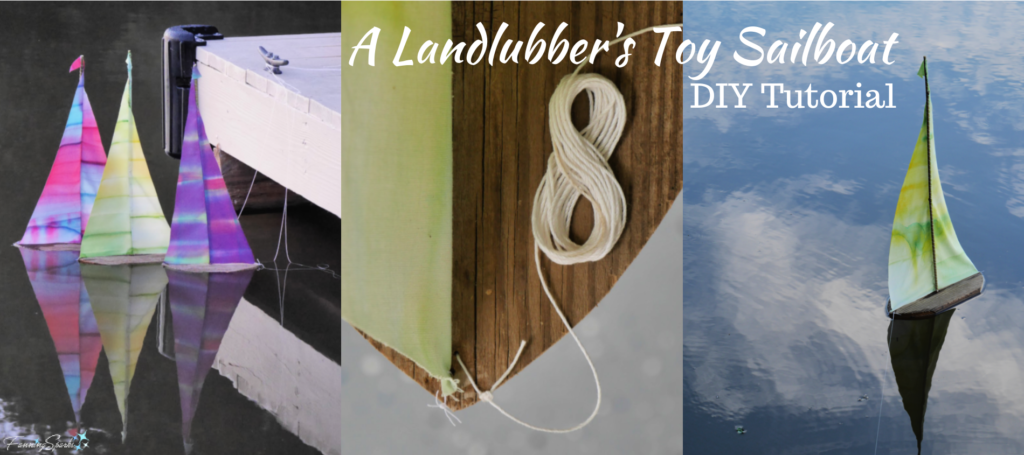
 The below graphic illustrates the parts and measurements for the landlubber’s toy sailboat. Essentially, it’s a piece of flat wood (aka Hull) with a vertical stick (aka Mast) and some pieces of fabric (aka Mainsail and Jib). The trick is to get it to float and stay upright. That’s where determination and perseverance came into play. It took lots of trial and error and several test runs to get to a solution that works. Now that I’ve figured it out, I’m happy to share the details with you!
The below graphic illustrates the parts and measurements for the landlubber’s toy sailboat. Essentially, it’s a piece of flat wood (aka Hull) with a vertical stick (aka Mast) and some pieces of fabric (aka Mainsail and Jib). The trick is to get it to float and stay upright. That’s where determination and perseverance came into play. It took lots of trial and error and several test runs to get to a solution that works. Now that I’ve figured it out, I’m happy to share the details with you!
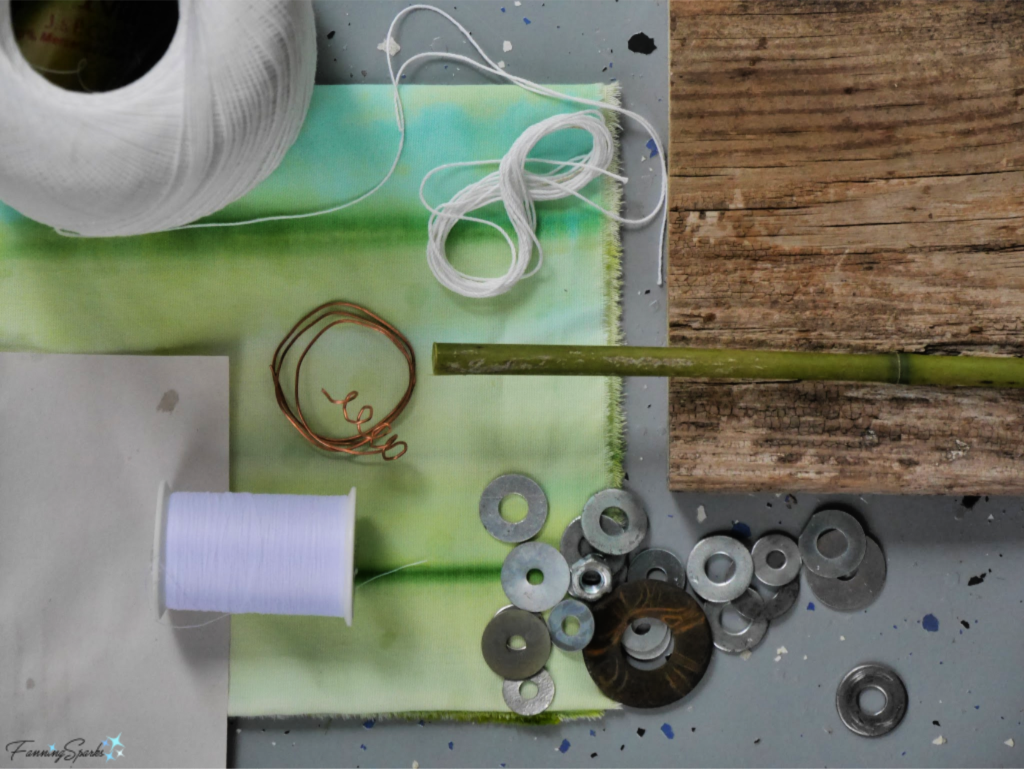 . Weathered Wood 12” x 5 ¼” x 1” (actual dimensions)
. Weathered Wood 12” x 5 ¼” x 1” (actual dimensions)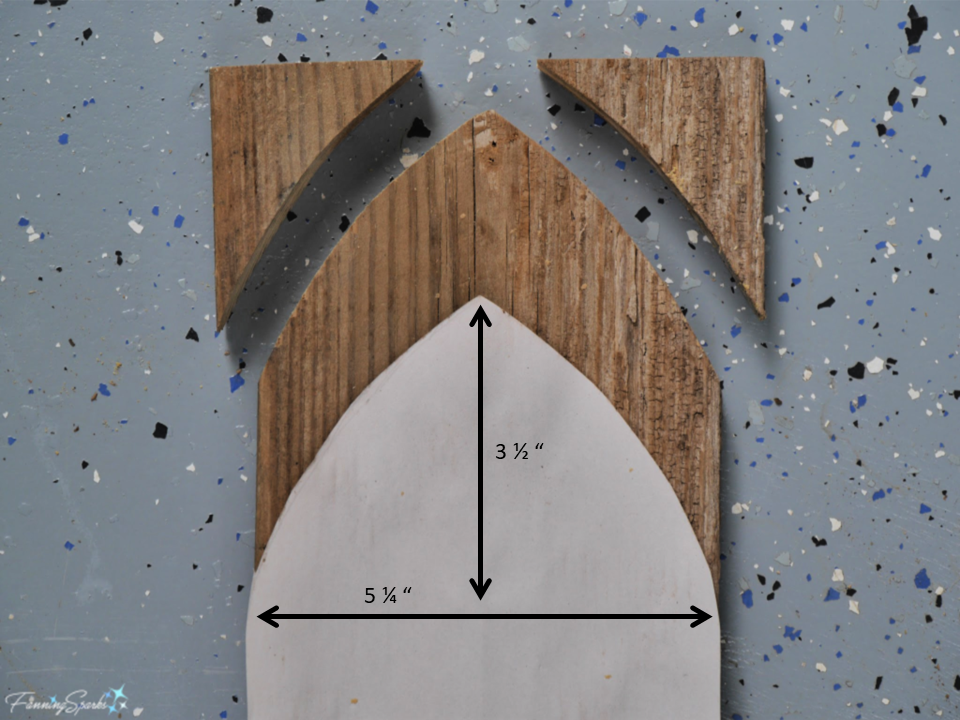 Step 2 – Drill Hull Using the ⅟₁₆” bit, drill 3 holes for thread and string as illustrated with black arrows on the below photo:
Step 2 – Drill Hull Using the ⅟₁₆” bit, drill 3 holes for thread and string as illustrated with black arrows on the below photo: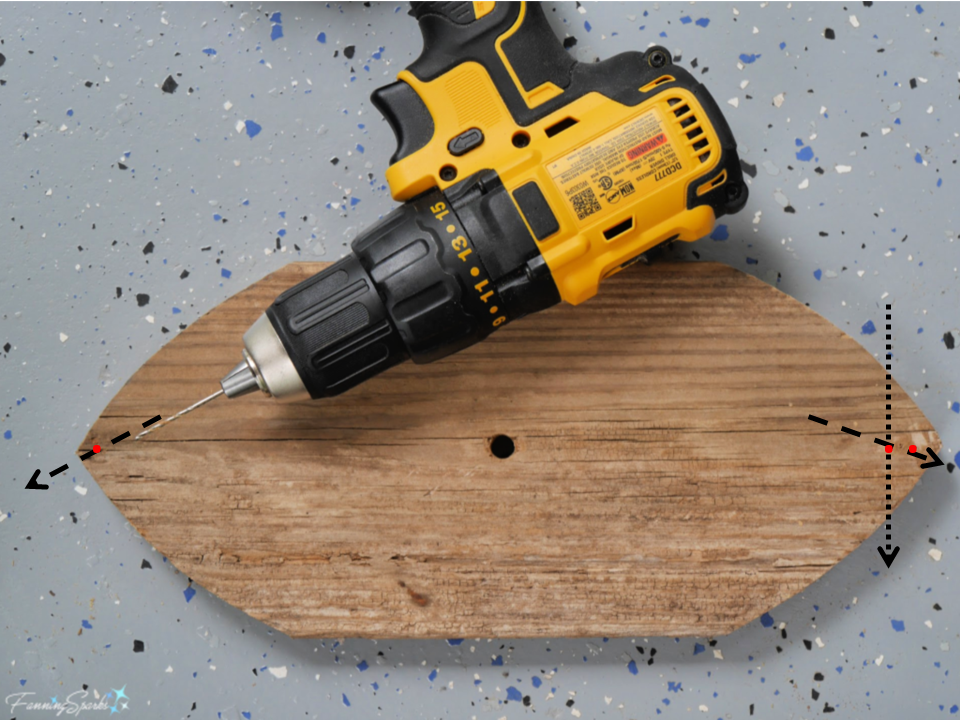 Step 3 – Cut Mast Cut a 34” section of ⅜” bamboo (or dowel) to make the Mast. Measure up 12” from the bottom of the Mast and drill with the ⅟₁₆” bit through the center of the bamboo rod at this point. Drill through the bamboo rod at each end of the Mast.
Step 3 – Cut Mast Cut a 34” section of ⅜” bamboo (or dowel) to make the Mast. Measure up 12” from the bottom of the Mast and drill with the ⅟₁₆” bit through the center of the bamboo rod at this point. Drill through the bamboo rod at each end of the Mast.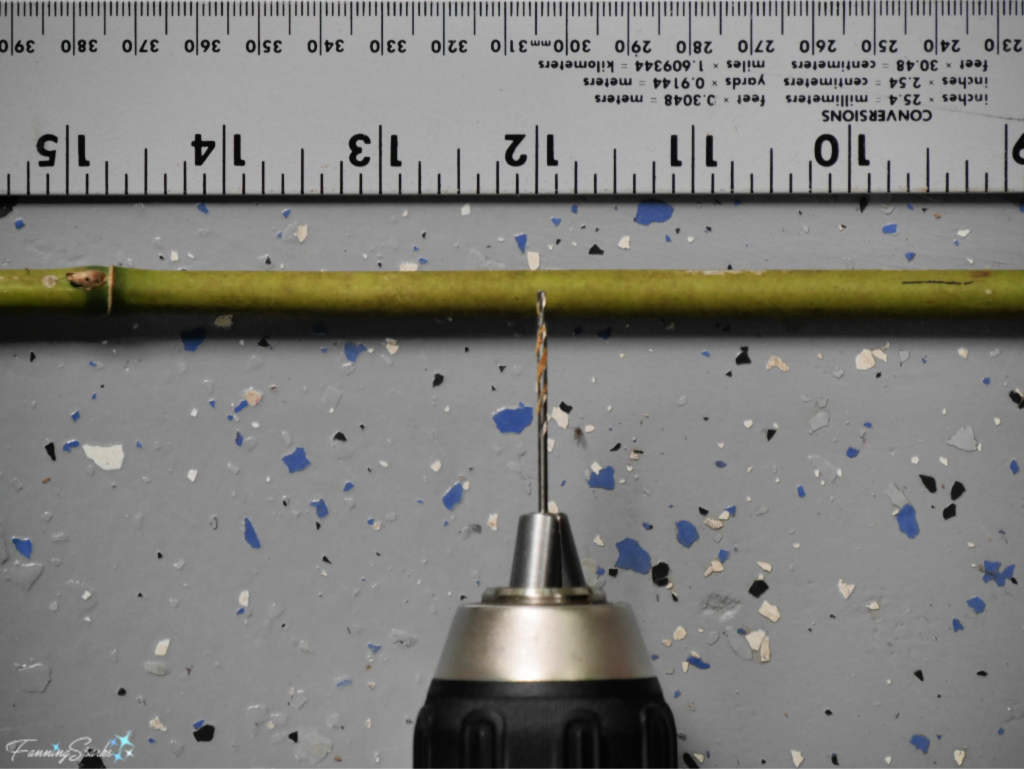 Step 4 – Cut Sails Cut the sails from the fabric. You will need 3 triangles of fabric:
Step 4 – Cut Sails Cut the sails from the fabric. You will need 3 triangles of fabric: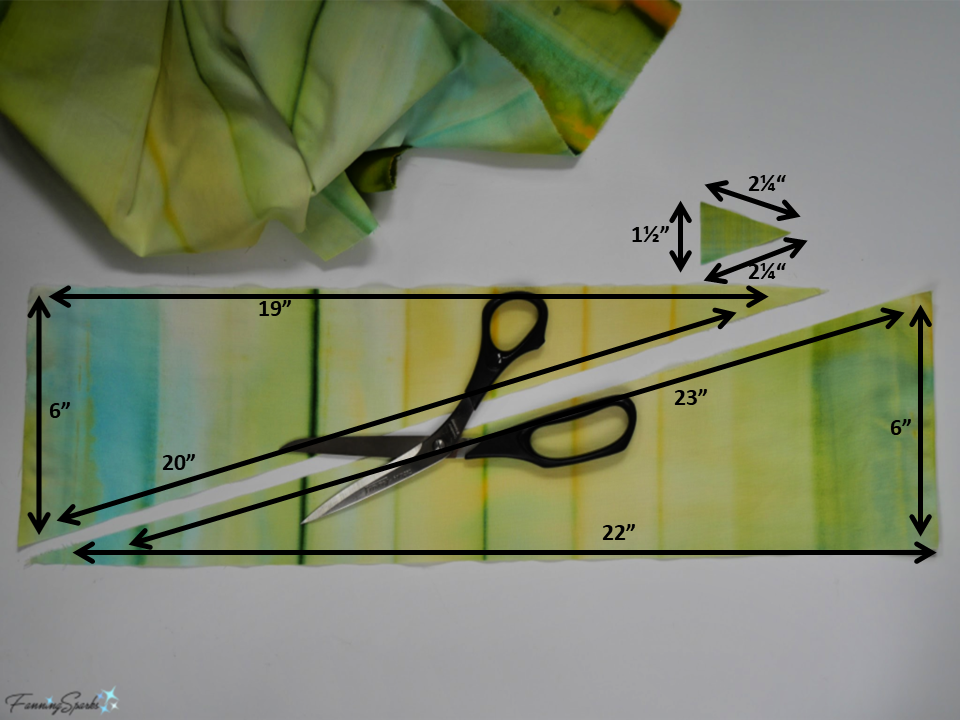 Step 5 – Sew Sails Lay the Jib on the Mainsail aligning the right angle corners and the long straight edges (Mainsail 22” and Jib 19”). Sew a small ¼” seam. Alternatively, you could use waterproof glue.
Step 5 – Sew Sails Lay the Jib on the Mainsail aligning the right angle corners and the long straight edges (Mainsail 22” and Jib 19”). Sew a small ¼” seam. Alternatively, you could use waterproof glue.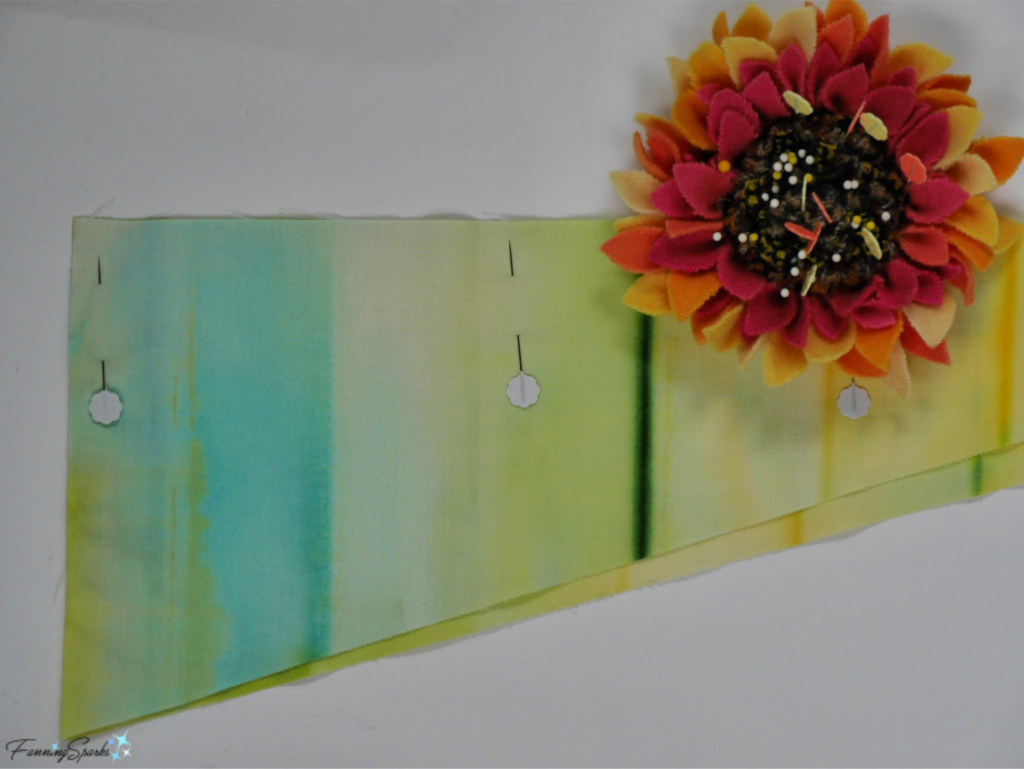 Step 6 – Attach Sails Cut about 1 ½” of wire. Bend loop into one end. Insert wire through the middle hole in Mast (at 12” mark). Bend loop in other end of wire to keep it snuggly in place. Sew the sails to the mast. Start by stitching thread through the bottom of the sails and the wire. Stitch by looping thread around Mast and through seam on sails. At the top of the Mast, insert needle and thread through hole in Mast to secure top of Mainsail. Take a few last stitches through the fabric to finish securely. Alternatively, you could use waterproof glue to attach the sails to the Mast.
Step 6 – Attach Sails Cut about 1 ½” of wire. Bend loop into one end. Insert wire through the middle hole in Mast (at 12” mark). Bend loop in other end of wire to keep it snuggly in place. Sew the sails to the mast. Start by stitching thread through the bottom of the sails and the wire. Stitch by looping thread around Mast and through seam on sails. At the top of the Mast, insert needle and thread through hole in Mast to secure top of Mainsail. Take a few last stitches through the fabric to finish securely. Alternatively, you could use waterproof glue to attach the sails to the Mast.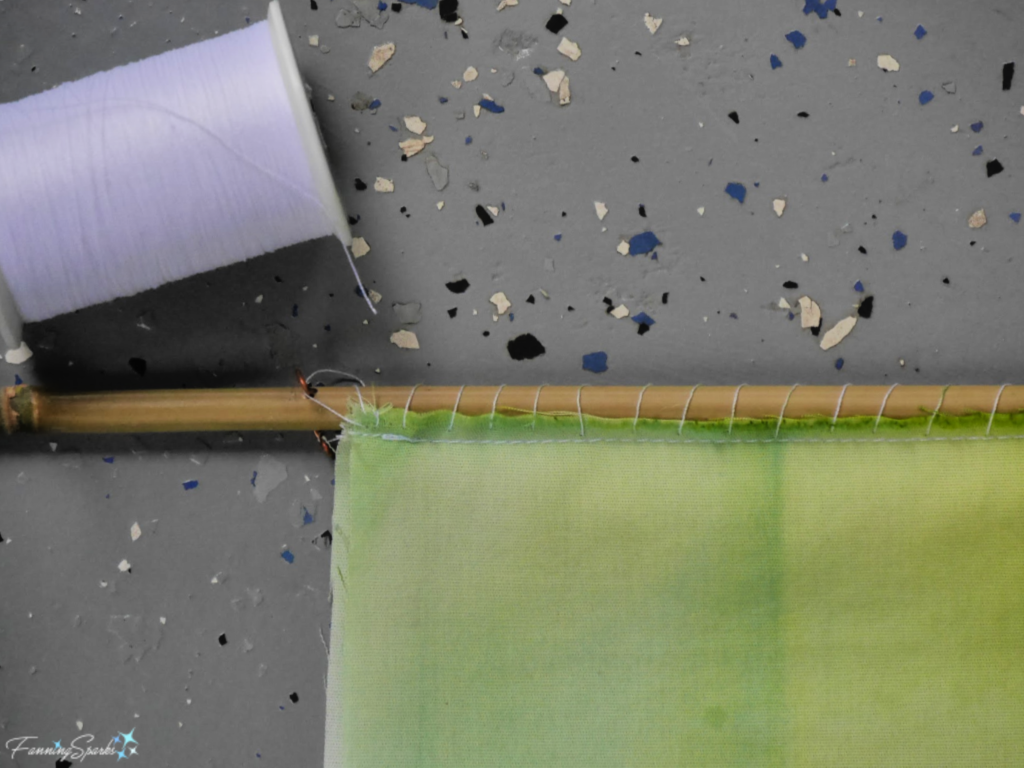 Step 7 – Attach Pennant Sew Pennant to top of Mast. Start at the top of the Mast, take a few stitches through the fabric to start securely. Insert needle and thread through hole in Mast to secure Pennant. Use running stitch to bring thread down to bottom of the Pennant. Wrap thread around Mast. Take a few last stitches through the fabric to finish securely. Alternatively, you could use waterproof glue to attach the Pennant to the Mast.
Step 7 – Attach Pennant Sew Pennant to top of Mast. Start at the top of the Mast, take a few stitches through the fabric to start securely. Insert needle and thread through hole in Mast to secure Pennant. Use running stitch to bring thread down to bottom of the Pennant. Wrap thread around Mast. Take a few last stitches through the fabric to finish securely. Alternatively, you could use waterproof glue to attach the Pennant to the Mast.
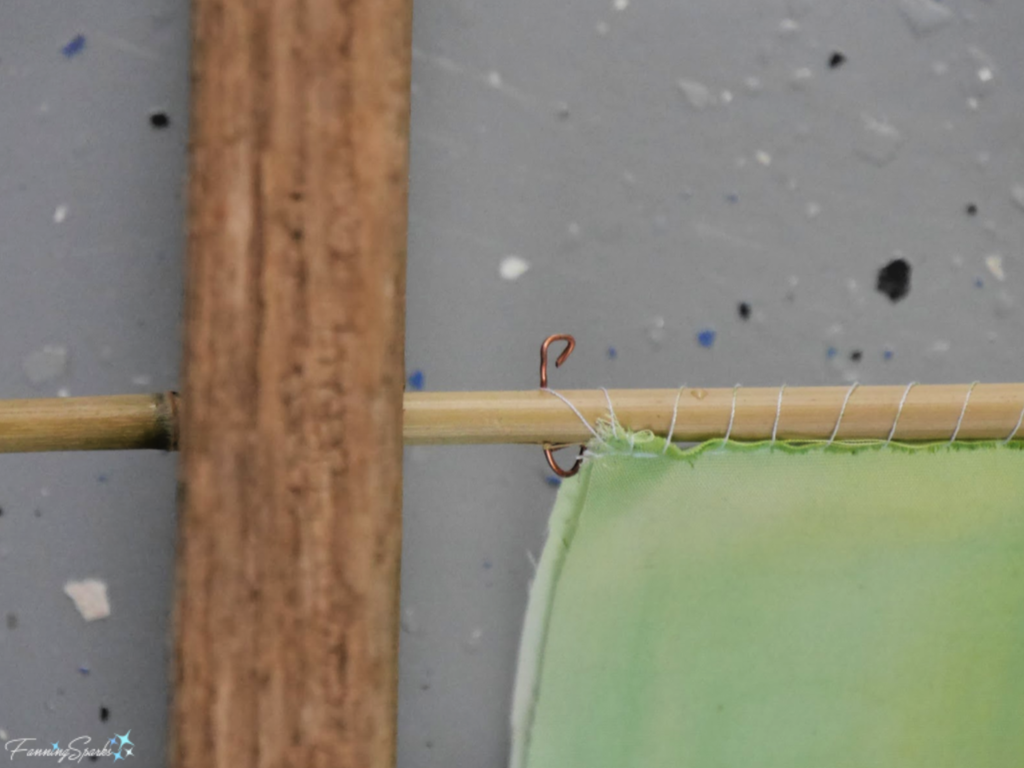 Step 9 – Attach Sails to Hull Attach front and back corners of sails to Hull with thread. Start with the Mainsail and the bow of the Hull.
Step 9 – Attach Sails to Hull Attach front and back corners of sails to Hull with thread. Start with the Mainsail and the bow of the Hull.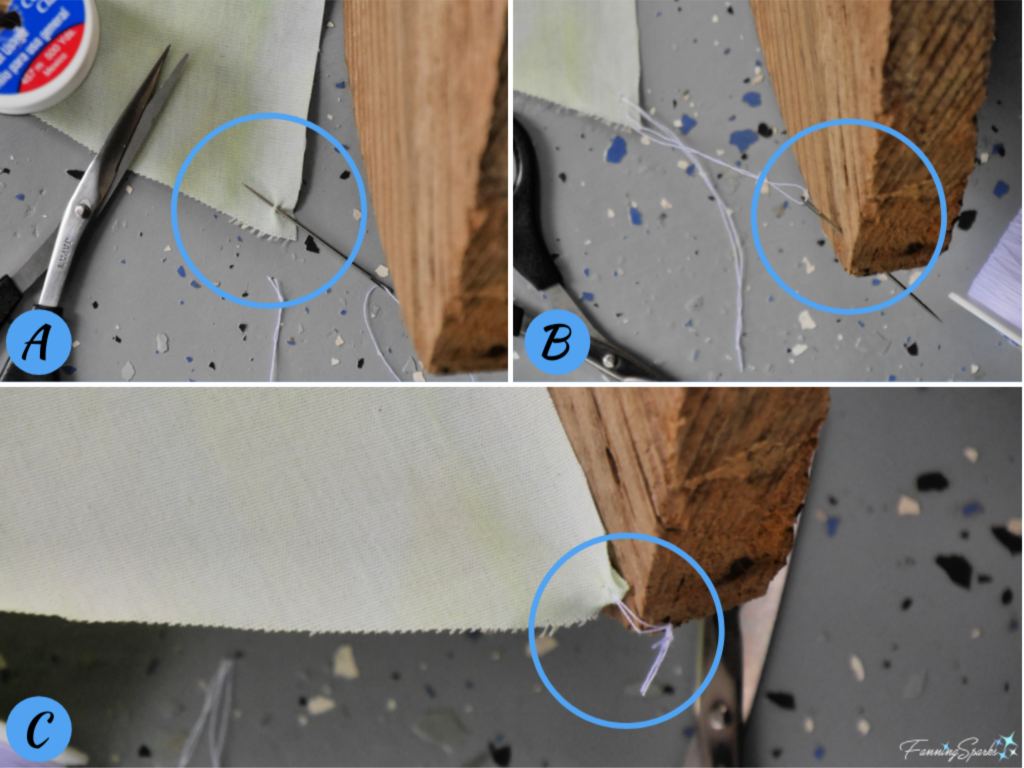 Step 10 – Attach Weights to Mast Cut about 6” of wire, put 4-6 1”washers (or nuts) on wire, thread wire through bottom hole of the Mast. This weight forms a keel, of sorts, and serves to keep the sailboat upright.
Step 10 – Attach Weights to Mast Cut about 6” of wire, put 4-6 1”washers (or nuts) on wire, thread wire through bottom hole of the Mast. This weight forms a keel, of sorts, and serves to keep the sailboat upright.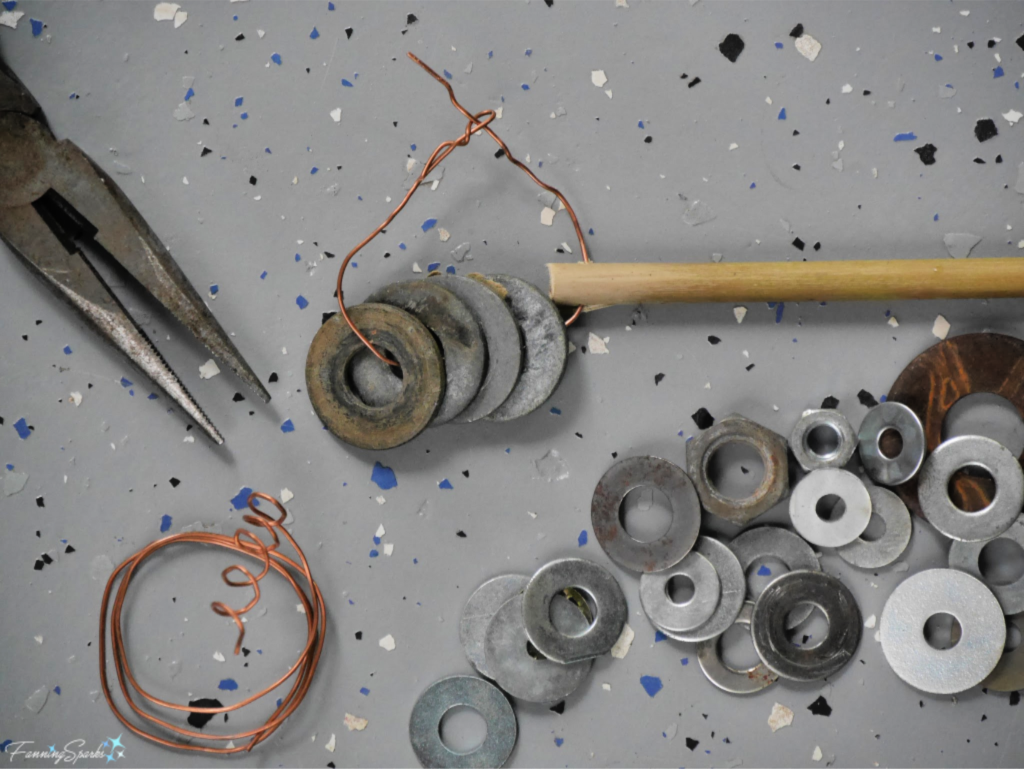 Step 11 – Attach String Cut a piece of string about 6 feet long. Use needle to thread the string through the hole at the stern of the Hull. Knot to attach securely. You’ll need this string to keep the sailboat from floating off into the sunset!
Step 11 – Attach String Cut a piece of string about 6 feet long. Use needle to thread the string through the hole at the stern of the Hull. Knot to attach securely. You’ll need this string to keep the sailboat from floating off into the sunset!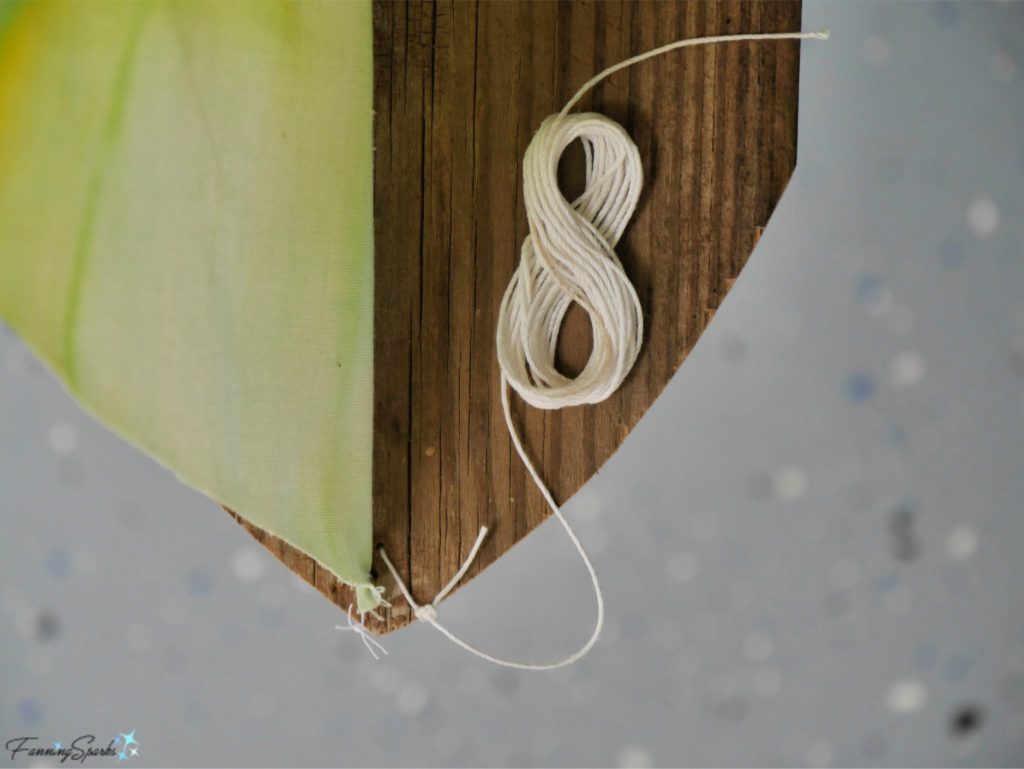 Step 12 Test Run It’s time to give your sailboat a try. This sailboat needs about 1 ½ feet of water to stand upright. Gently set it in water to ensure it floats and stays upright. Adjust if necessary; for example by centering or adding washers to the weights.
Step 12 Test Run It’s time to give your sailboat a try. This sailboat needs about 1 ½ feet of water to stand upright. Gently set it in water to ensure it floats and stays upright. Adjust if necessary; for example by centering or adding washers to the weights. UPDATE July 6, 2021: Shown below is my latest iteration of this sailboat. This time I made the sails with a polypropylene fabric called Oly*Fun™. This fabric repels water so the sails stay dry and the sailboat stays balanced.
UPDATE July 6, 2021: Shown below is my latest iteration of this sailboat. This time I made the sails with a polypropylene fabric called Oly*Fun™. This fabric repels water so the sails stay dry and the sailboat stays balanced.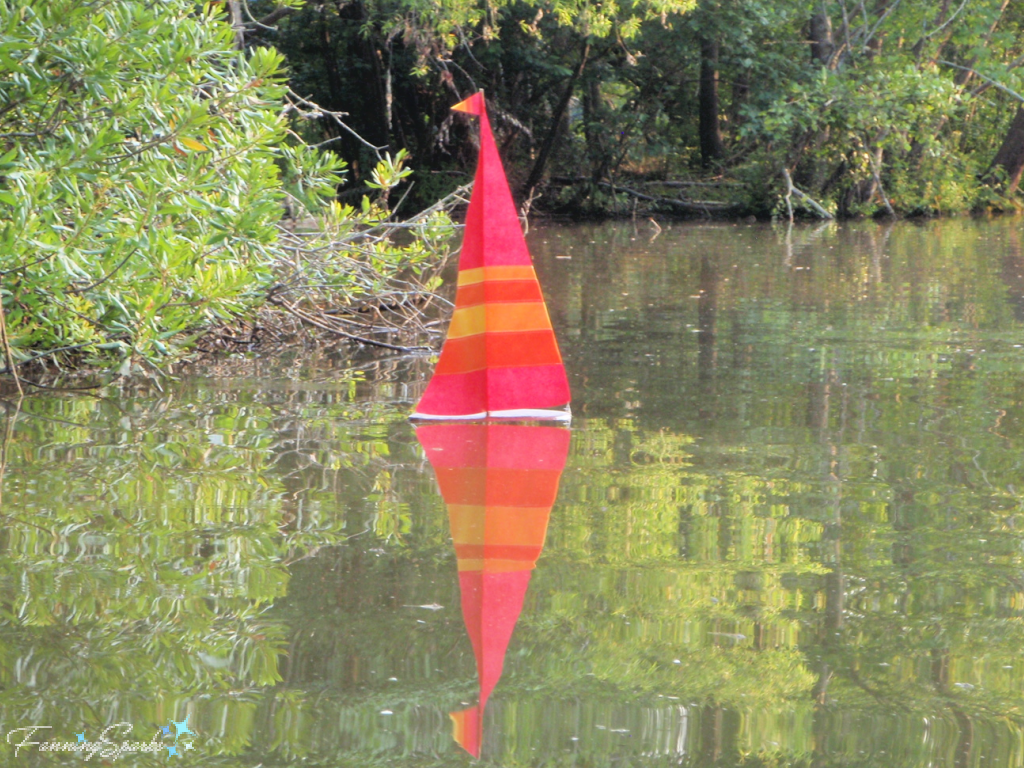
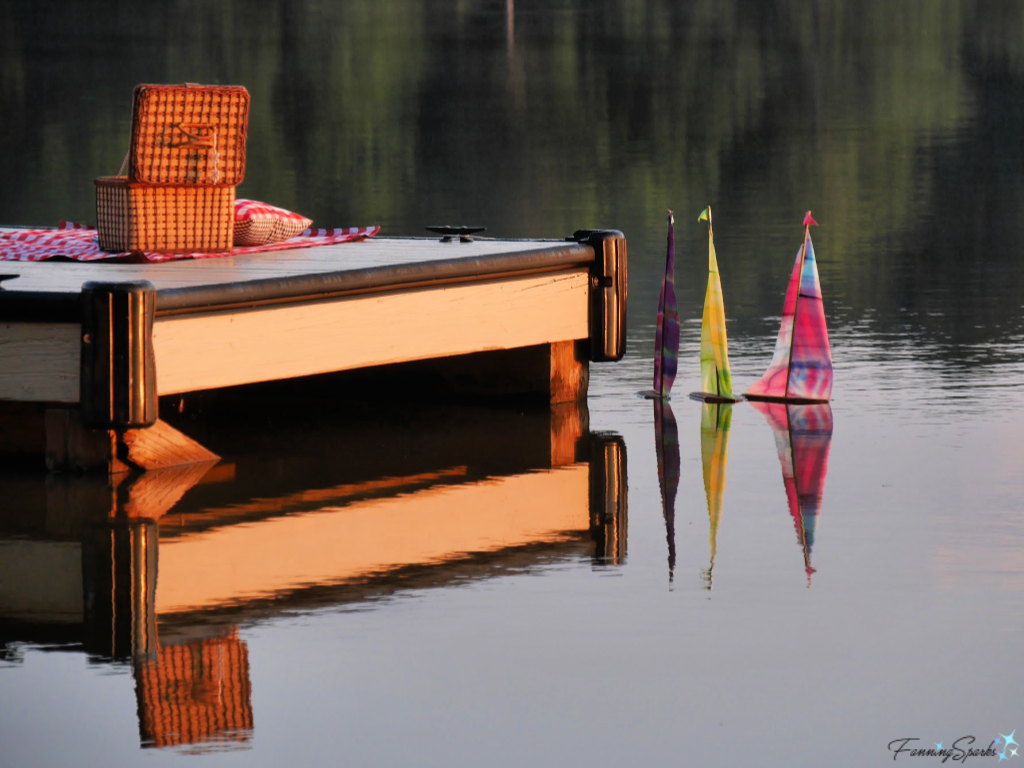 You can learn to build a tiny toy sailboat with a cork, craft foam and a toothpick in the hands-on science activity in this
You can learn to build a tiny toy sailboat with a cork, craft foam and a toothpick in the hands-on science activity in this 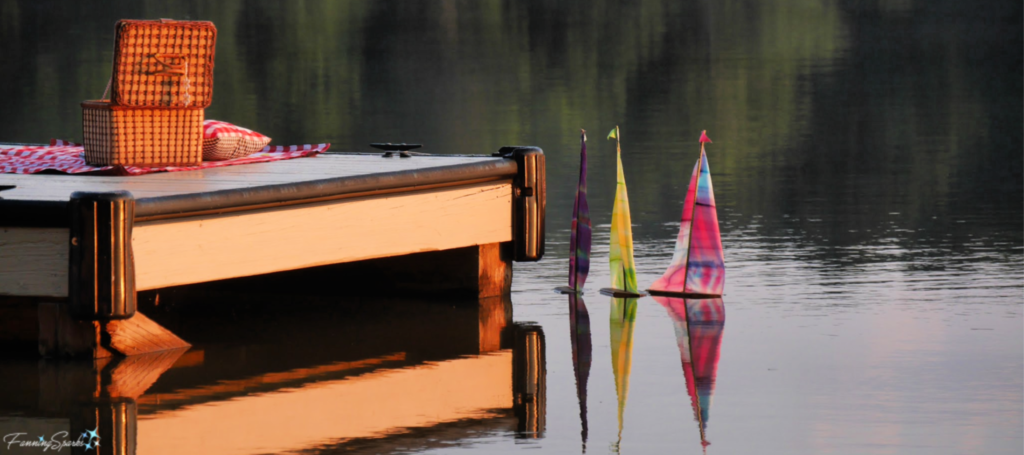
 The end of the dock provided the perfect spot to enjoy the show and await sunrise.
The end of the dock provided the perfect spot to enjoy the show and await sunrise.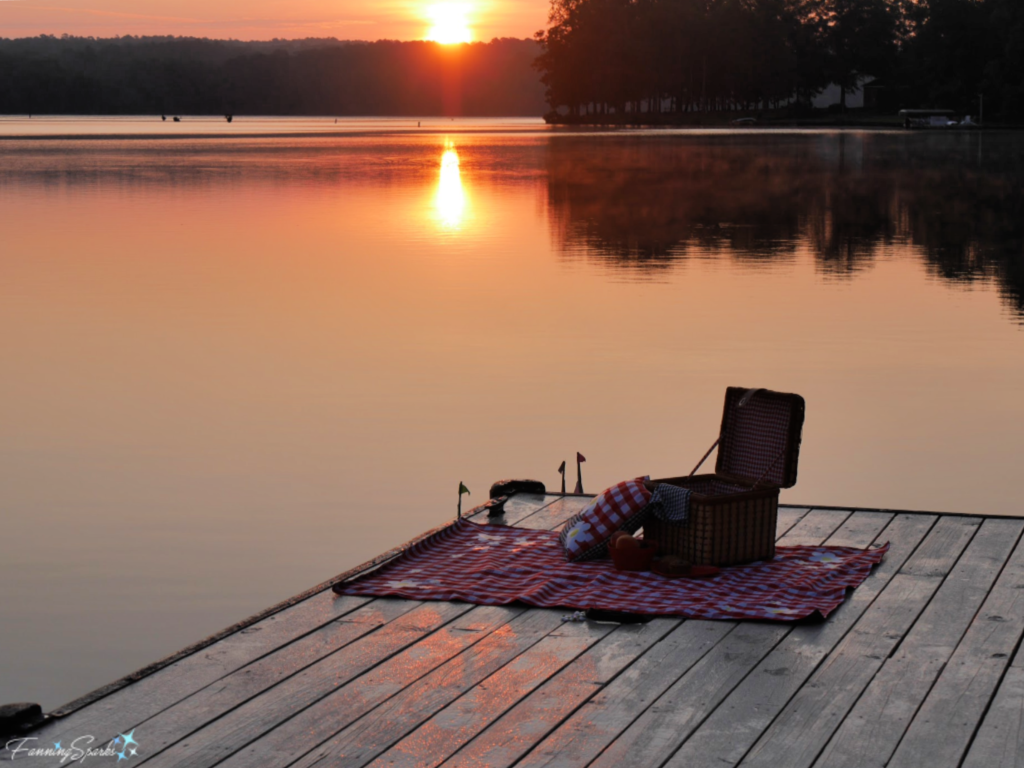 With such an early start, everything had to be prepared and packed the night before. Luckily, a breakfast picnic doesn’t require much food and the menu was super simple.
With such an early start, everything had to be prepared and packed the night before. Luckily, a breakfast picnic doesn’t require much food and the menu was super simple. My breakfast picnic consisted of blueberry muffins and fresh fruit. It would have been perfect if I hadn’t forgotten the coffee. My to-go coffee mug was ready but, in the rush to reach the boat launch for first light, I left it sitting on the kitchen counter. With or without coffee, this simple meal was tasty and hassle-free.
My breakfast picnic consisted of blueberry muffins and fresh fruit. It would have been perfect if I hadn’t forgotten the coffee. My to-go coffee mug was ready but, in the rush to reach the boat launch for first light, I left it sitting on the kitchen counter. With or without coffee, this simple meal was tasty and hassle-free.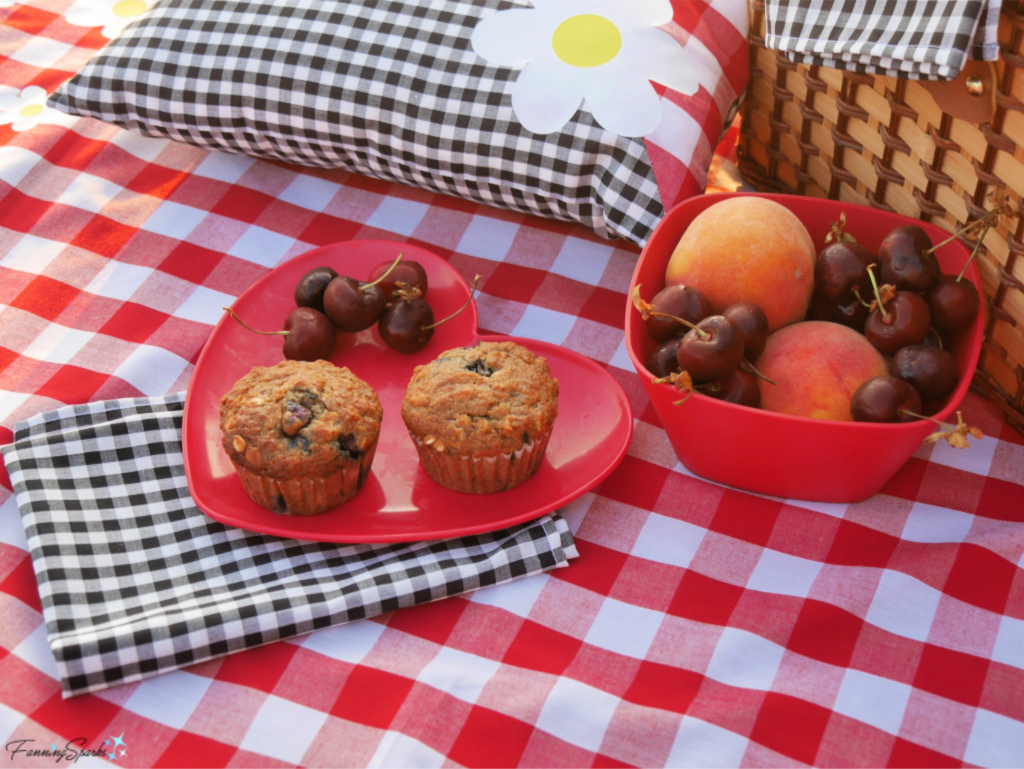 Aside from the picnic blanket, everything fit inside the picnic hamper. This was my first time using this new picnic blanket and I’m really pleased with the results. The waterproof backing kept the blanket dry despite the heavy dew on the dock—just as intended.
Aside from the picnic blanket, everything fit inside the picnic hamper. This was my first time using this new picnic blanket and I’m really pleased with the results. The waterproof backing kept the blanket dry despite the heavy dew on the dock—just as intended.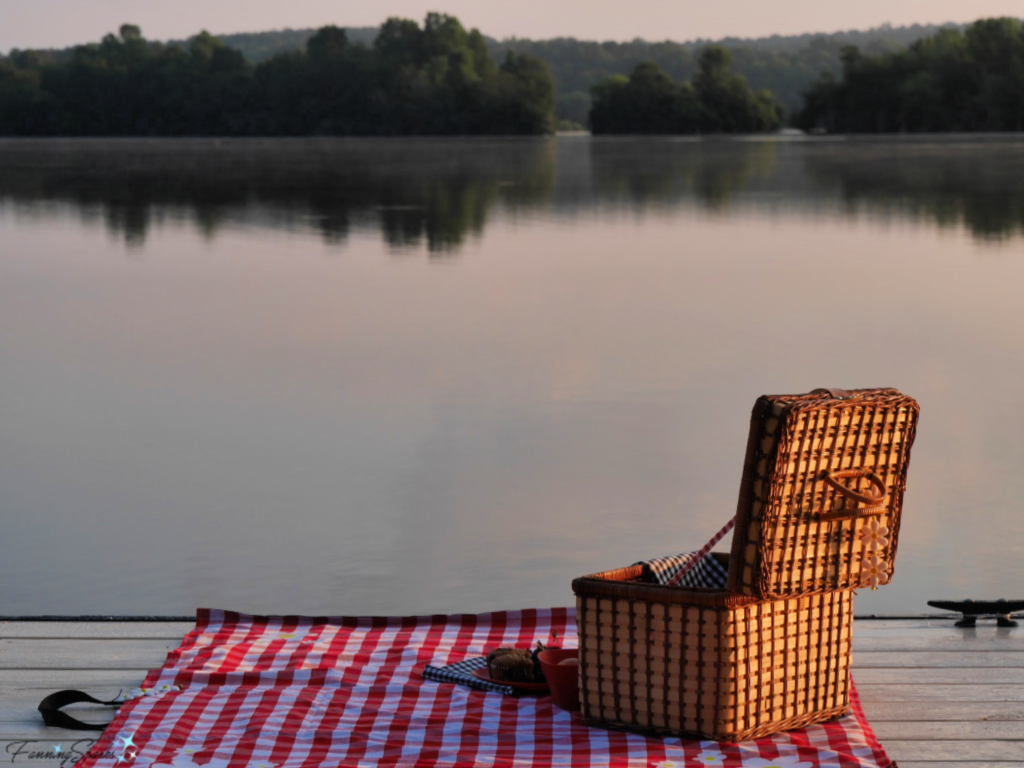 This picnic blanket is a project from last summer. At the time, my research showed that while there are dozens of online tutorials for making a picnic blanket none had all the features I wanted. So I designed, what I consider to be, the ultimate picnic blanket. It’s a generous size, machine washable, waterproof but not slippery, easy to transport, and has a pretty, eye-catching design. I’ll share the step-by-step instructions in an upcoming post. There’s even a built-in pocket that turns into a compact carrying case.
This picnic blanket is a project from last summer. At the time, my research showed that while there are dozens of online tutorials for making a picnic blanket none had all the features I wanted. So I designed, what I consider to be, the ultimate picnic blanket. It’s a generous size, machine washable, waterproof but not slippery, easy to transport, and has a pretty, eye-catching design. I’ll share the step-by-step instructions in an upcoming post. There’s even a built-in pocket that turns into a compact carrying case.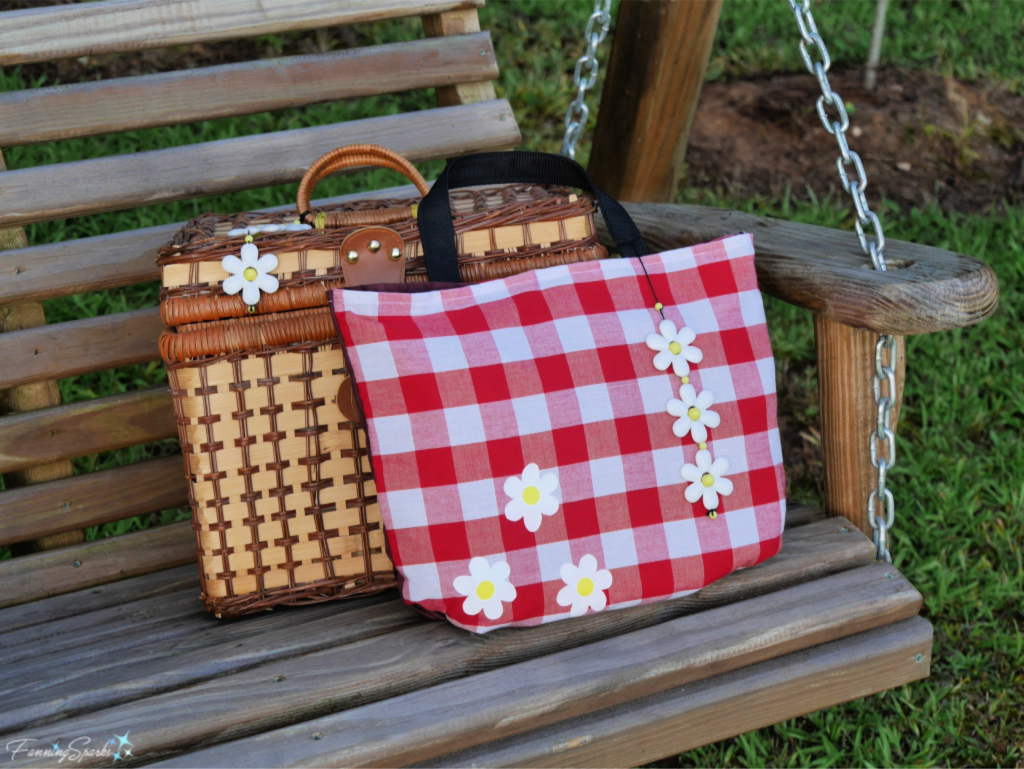 As I was planning for the breakfast picnic, it occurred to me it might be fun to include a small boat. I readily admit I got a little carried away. Instead of a small boat, a small fleet of sailboats, complete with colorful fabric sails, emerged. Thankfully, the sailboats actually floated! Here’s the photographic evidence—3 pretty sailboats floating in the diffused light of the magic hour.
As I was planning for the breakfast picnic, it occurred to me it might be fun to include a small boat. I readily admit I got a little carried away. Instead of a small boat, a small fleet of sailboats, complete with colorful fabric sails, emerged. Thankfully, the sailboats actually floated! Here’s the photographic evidence—3 pretty sailboats floating in the diffused light of the magic hour.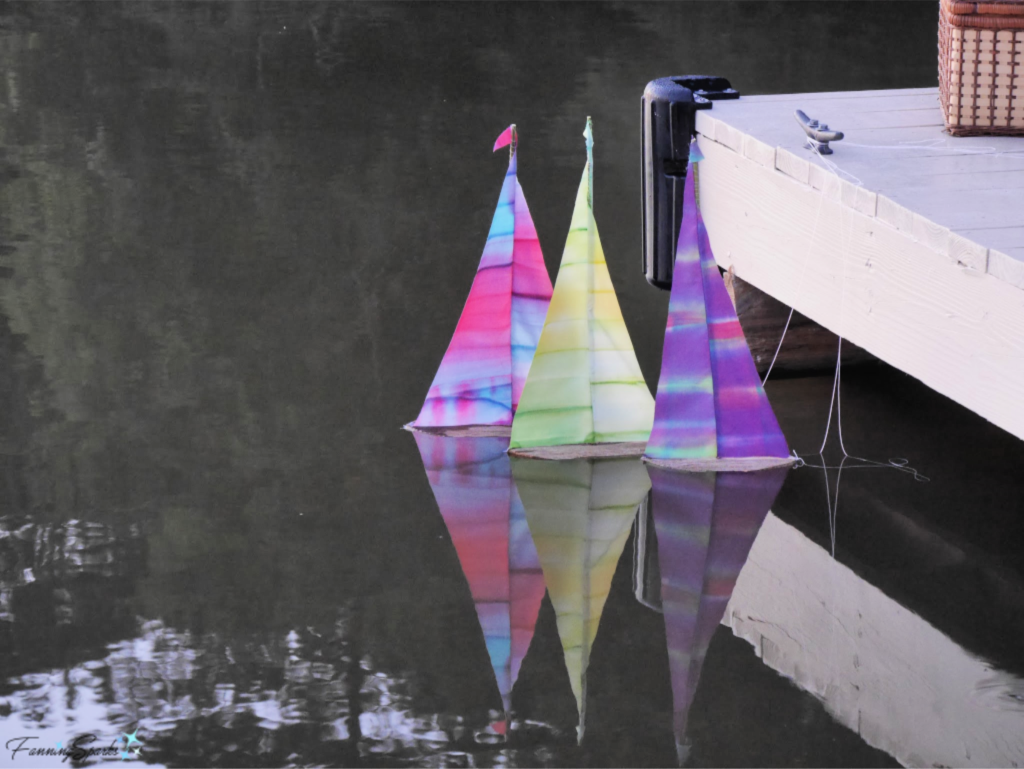 By the way, the term “magic hour” is used by photographers to describe the natural light around sunrise and sunset. The morning sequence is magic hour > sunrise > golden hour. It’s the opposite at sunset. Typically, the light during these hours is softly diffused producing the warm, rich colors that photographers love. I also raved about the beauty of this natural light in the post
By the way, the term “magic hour” is used by photographers to describe the natural light around sunrise and sunset. The morning sequence is magic hour > sunrise > golden hour. It’s the opposite at sunset. Typically, the light during these hours is softly diffused producing the warm, rich colors that photographers love. I also raved about the beauty of this natural light in the post 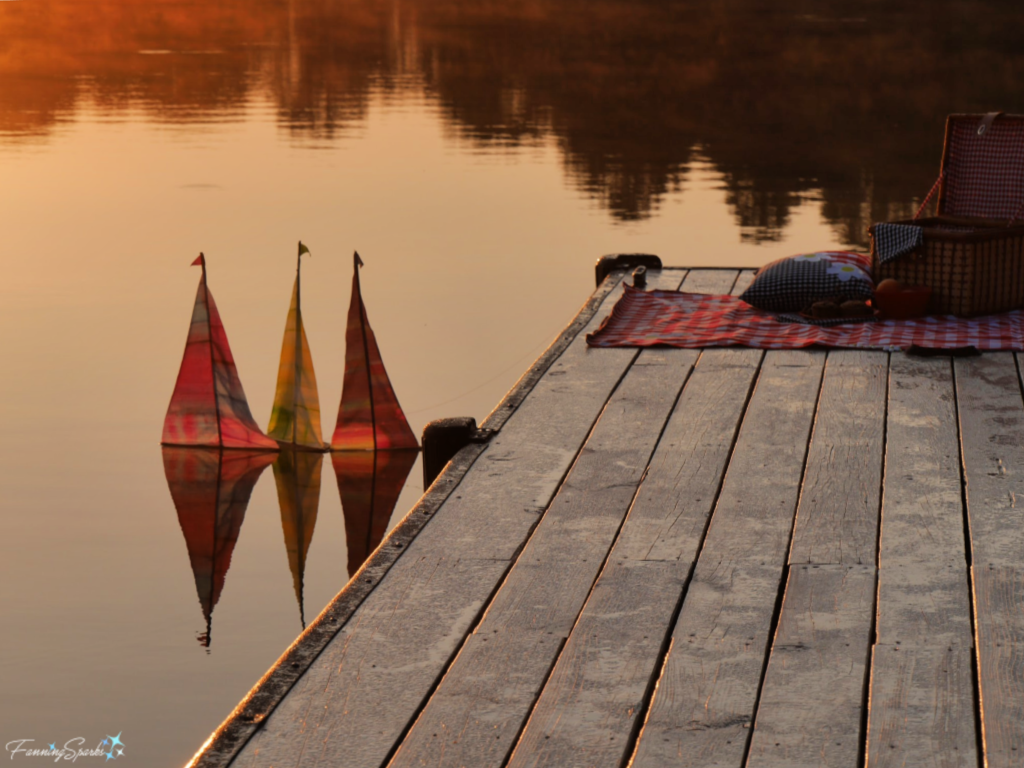 Here’s another example of the little fleet caught in the golden hour.
Here’s another example of the little fleet caught in the golden hour.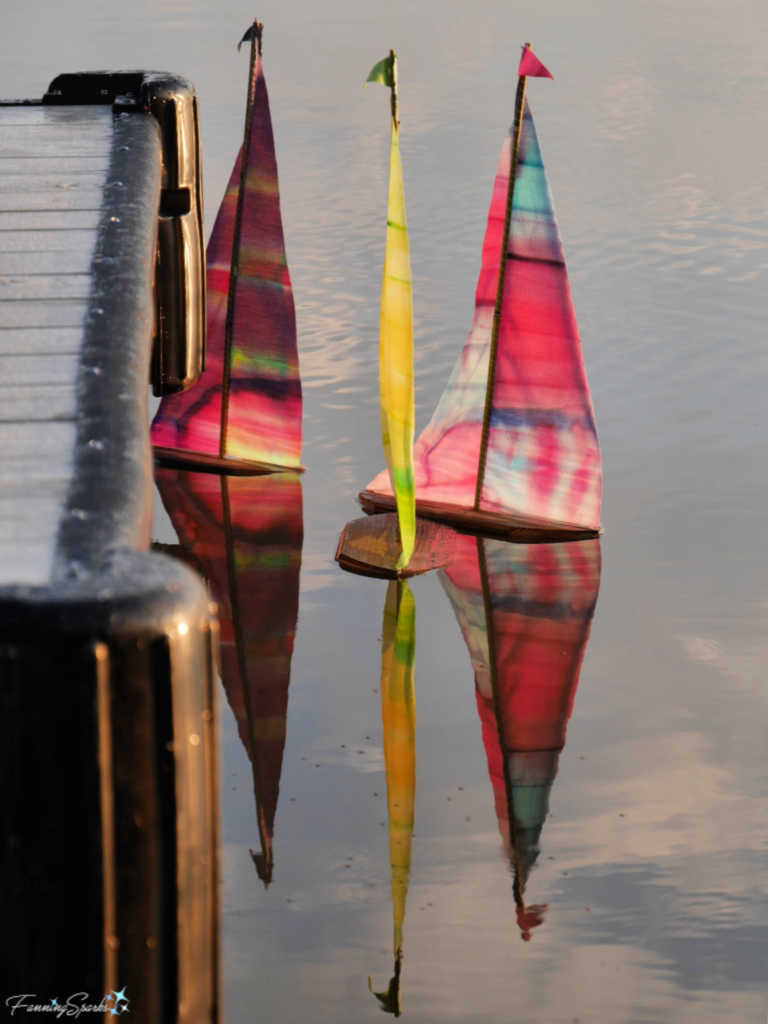
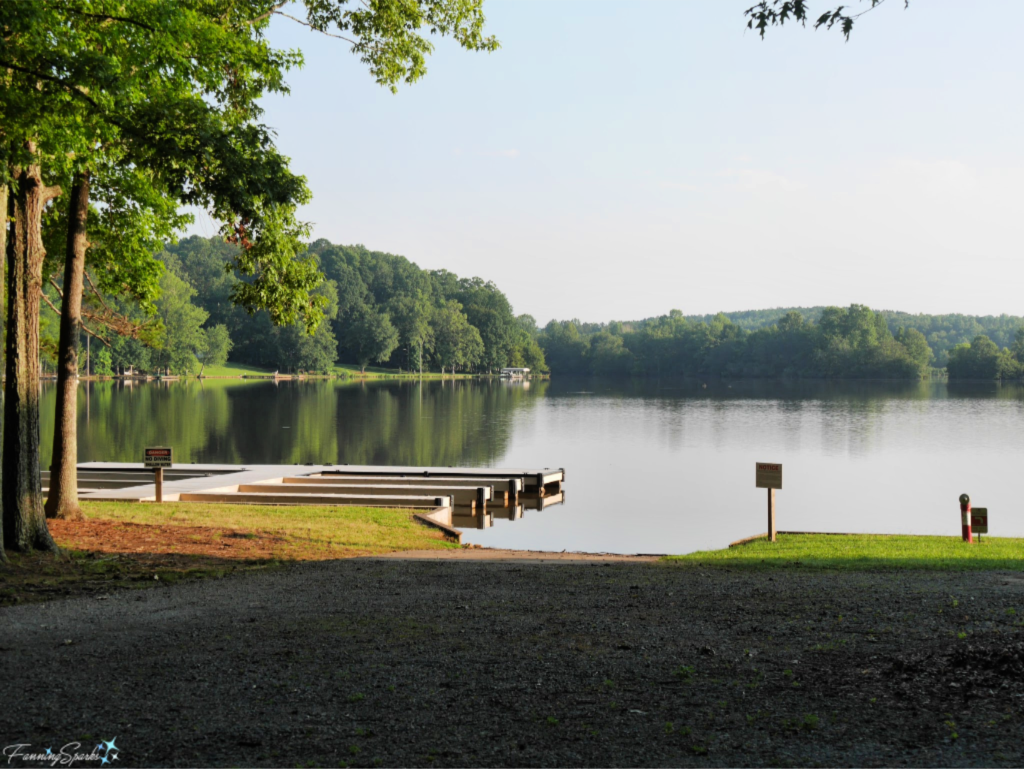
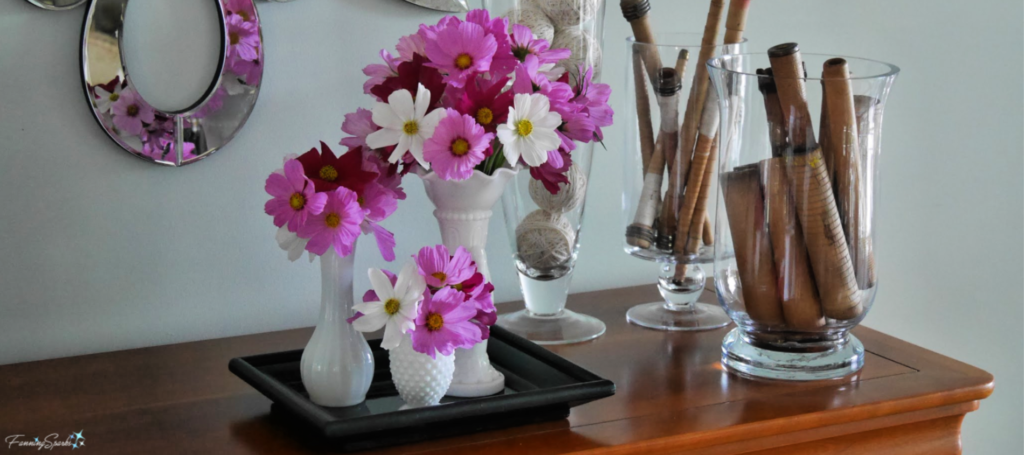
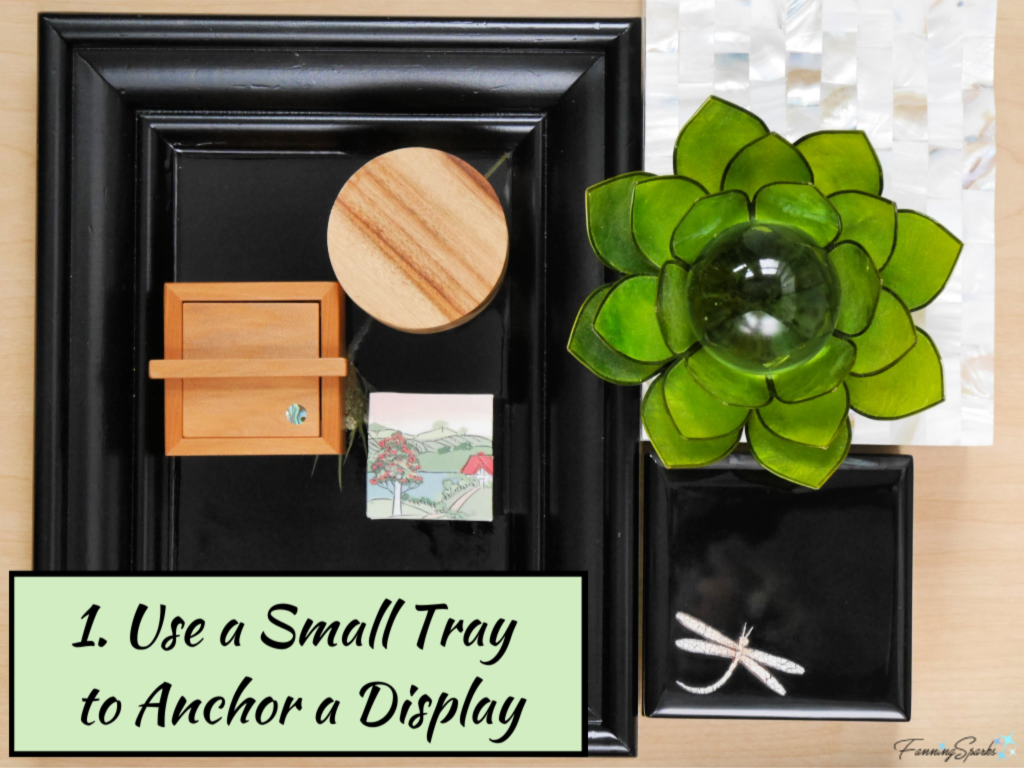
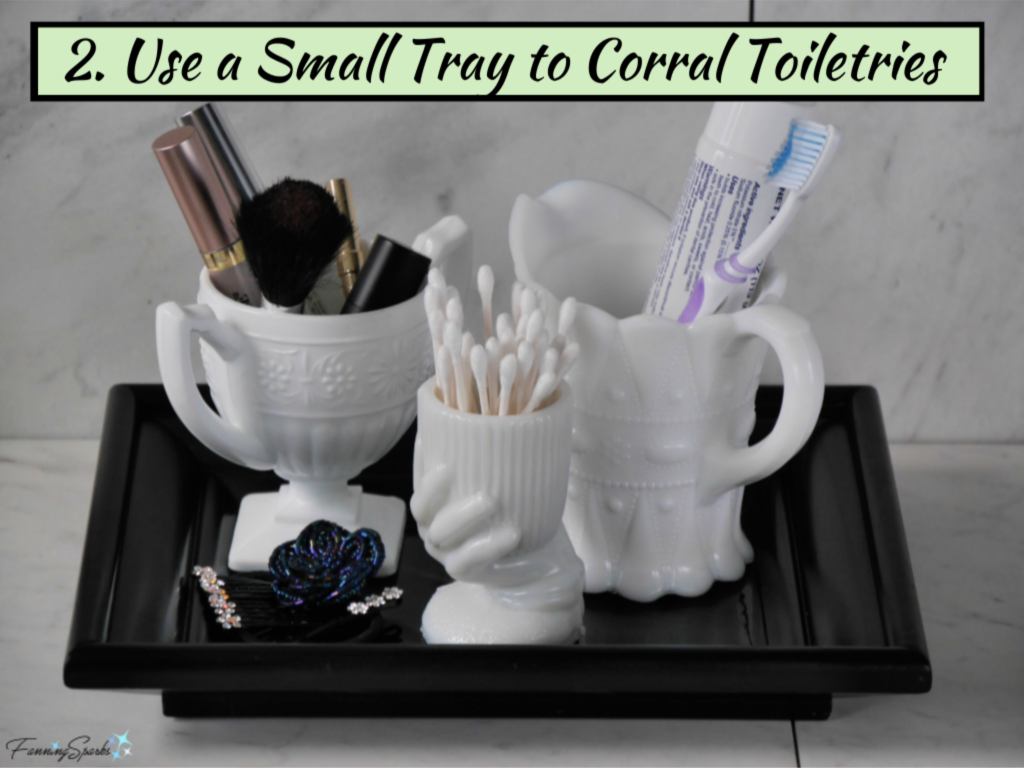

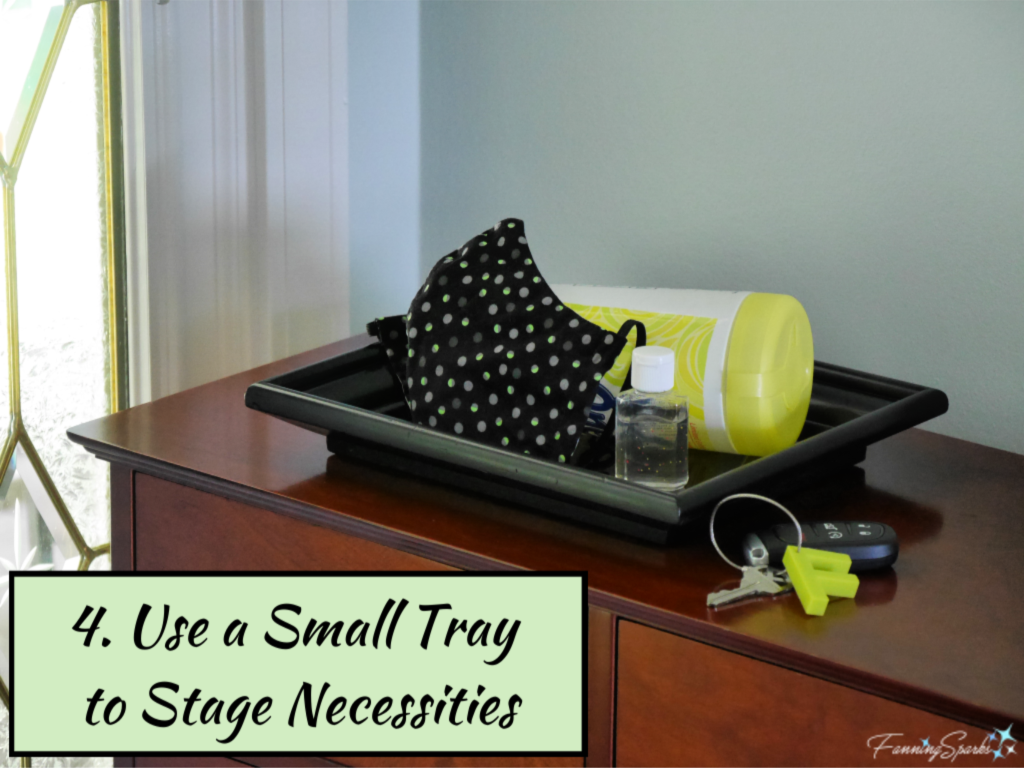
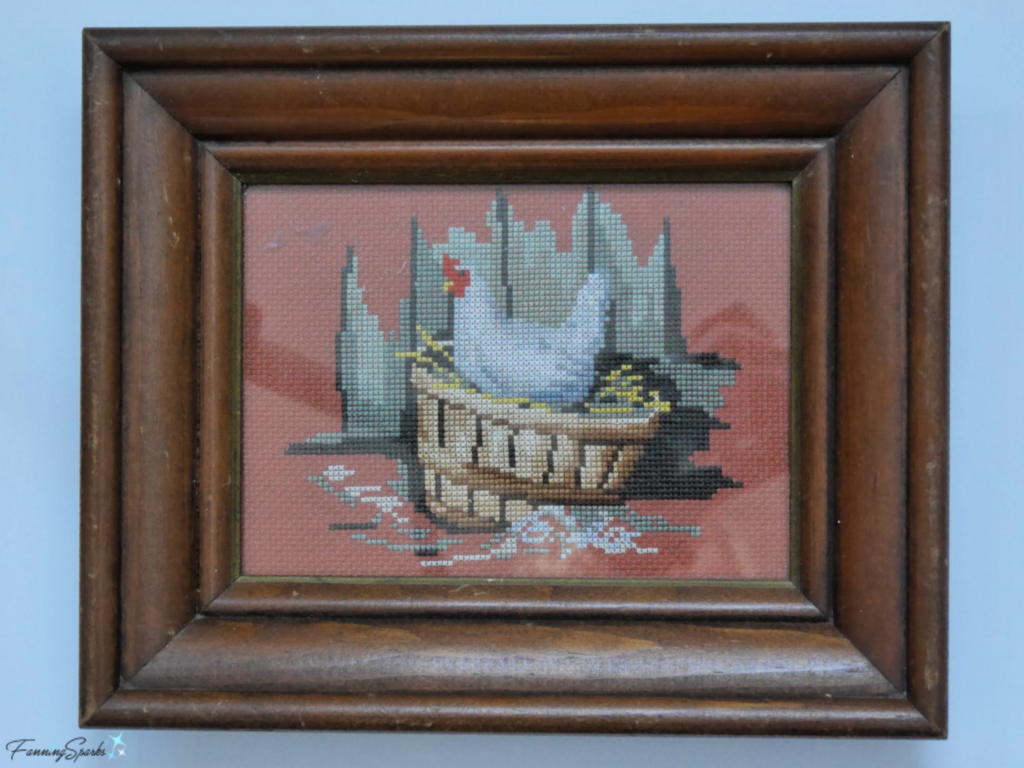

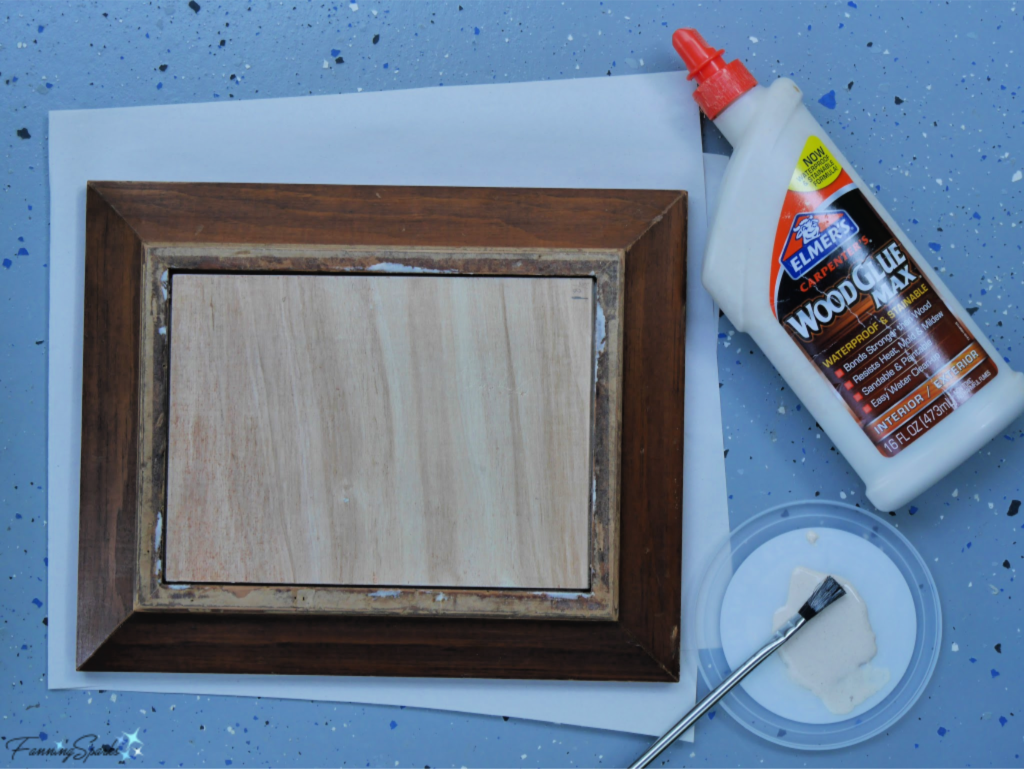
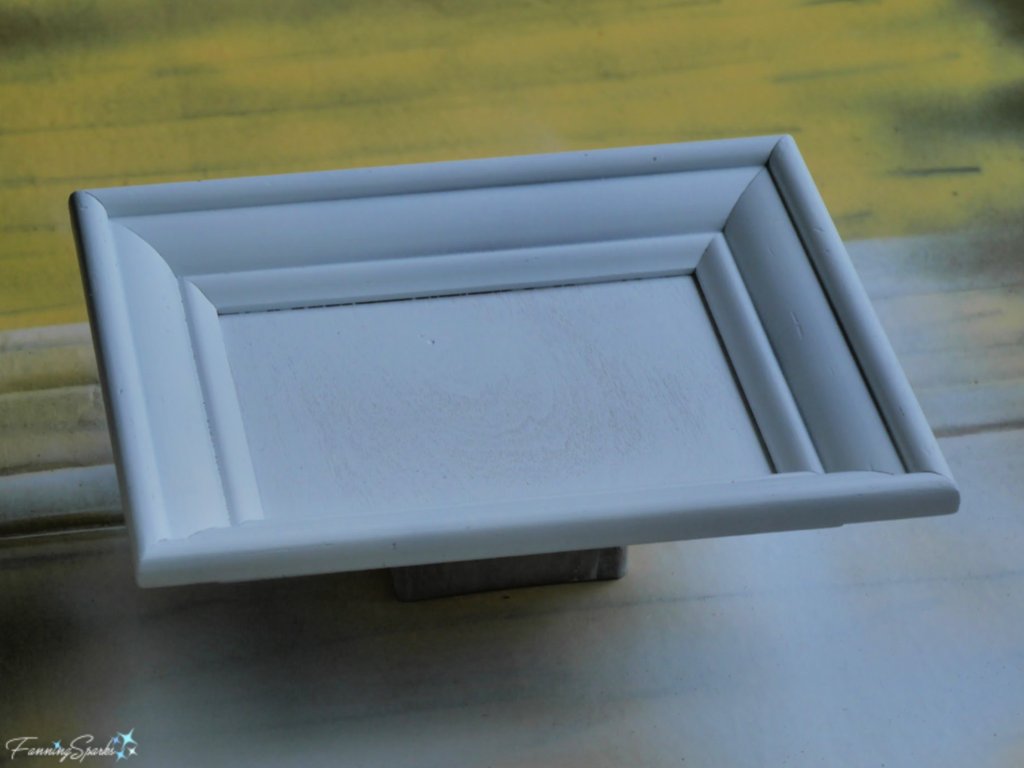
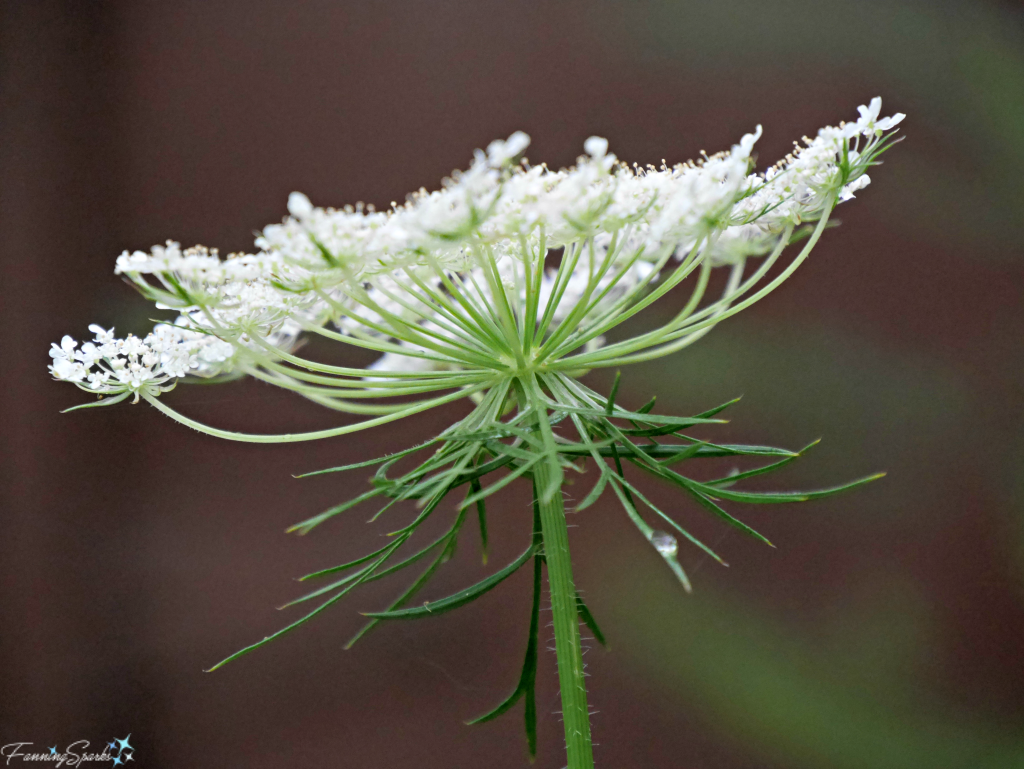 The partially open blossom of Queen Anne’s Lace (shown below) is strikingly simple against the black background. I used Mod Podge matte finish to glue the pressed wildflower in place and to seal the surface.
The partially open blossom of Queen Anne’s Lace (shown below) is strikingly simple against the black background. I used Mod Podge matte finish to glue the pressed wildflower in place and to seal the surface.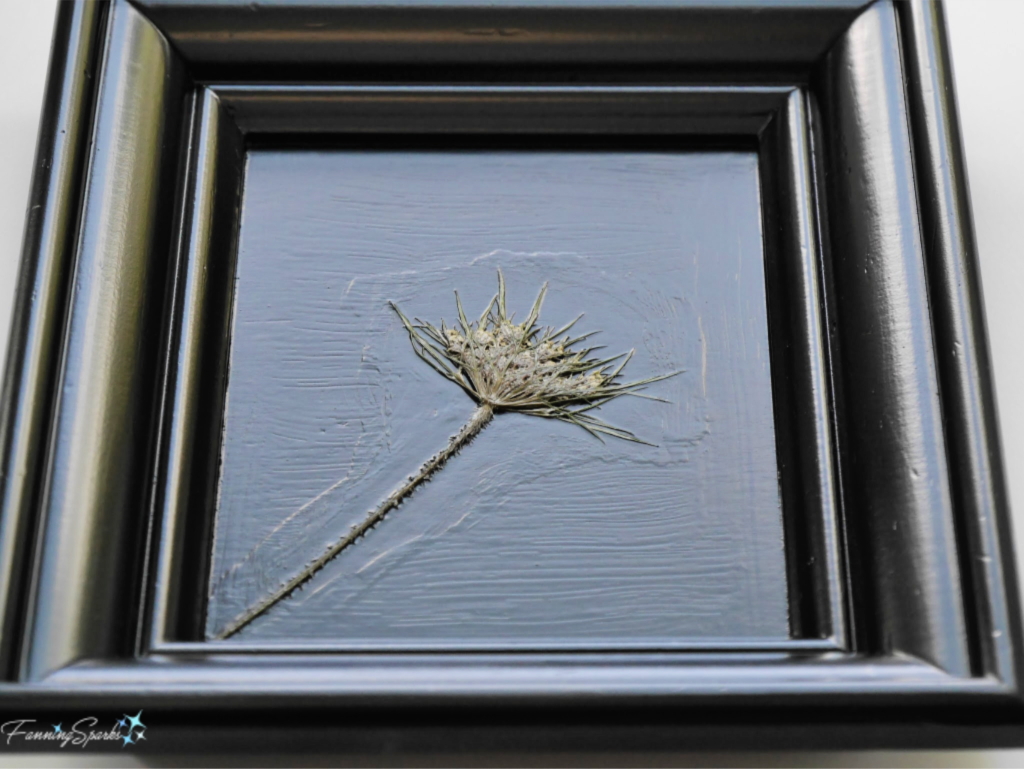
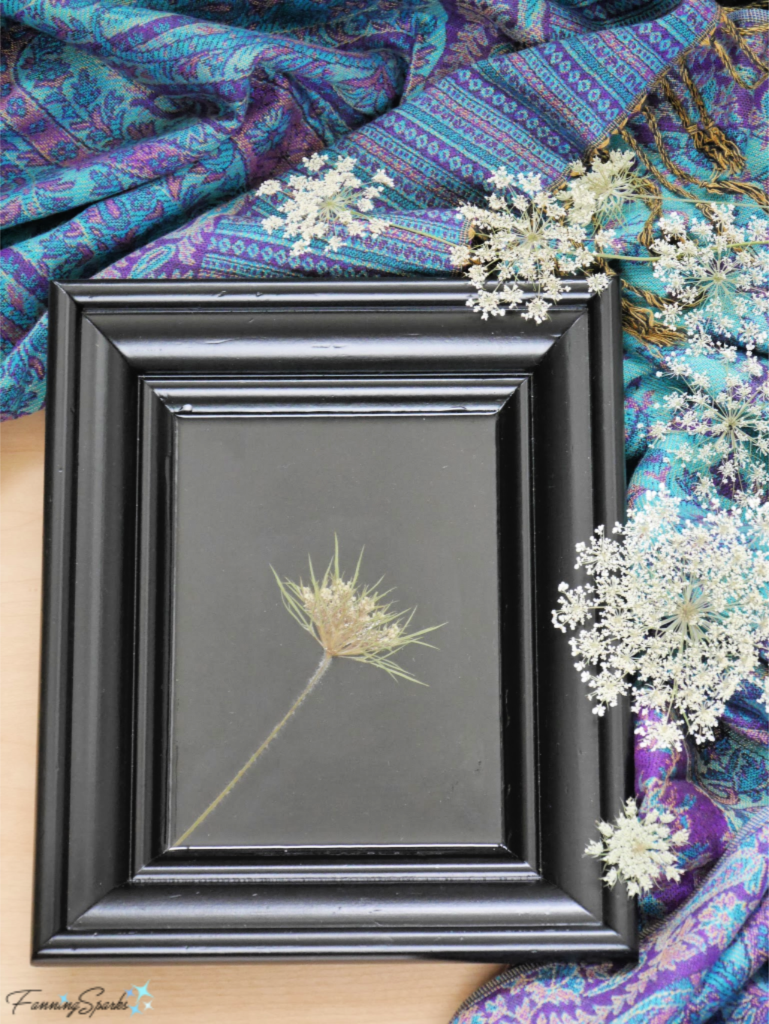
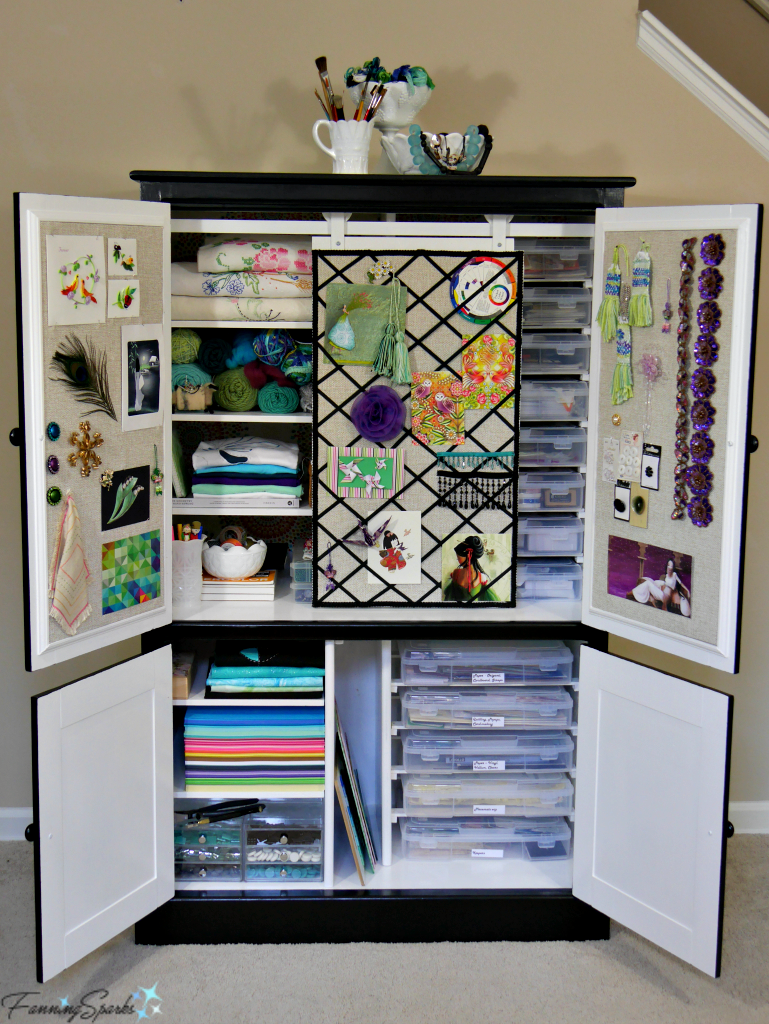
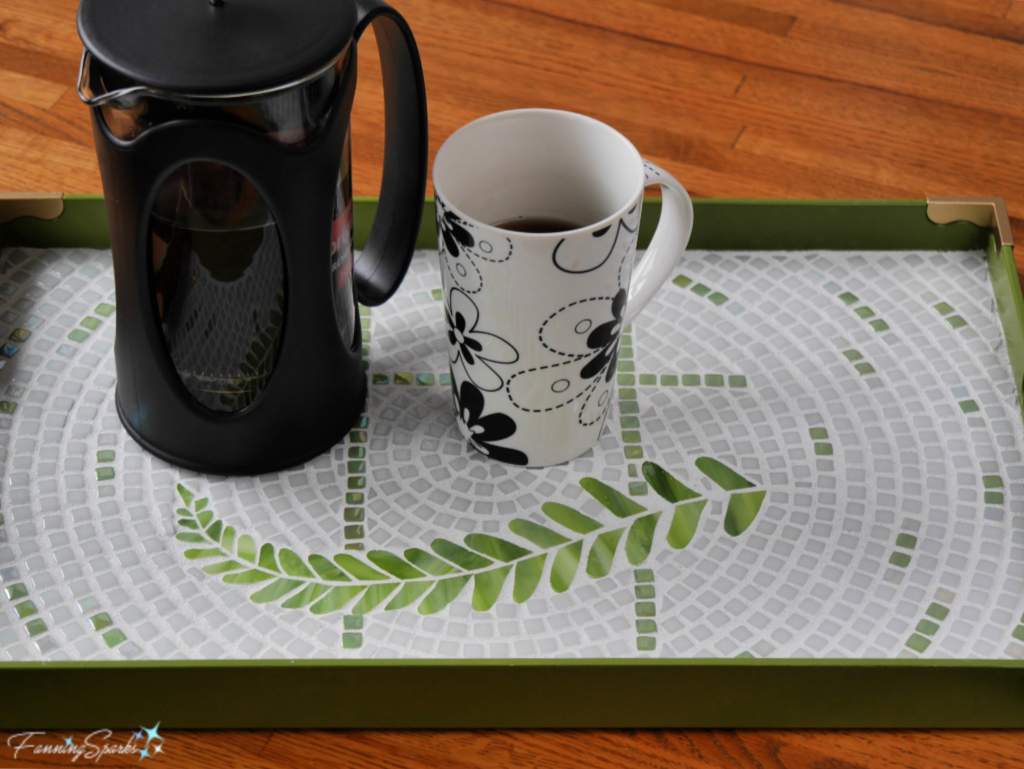
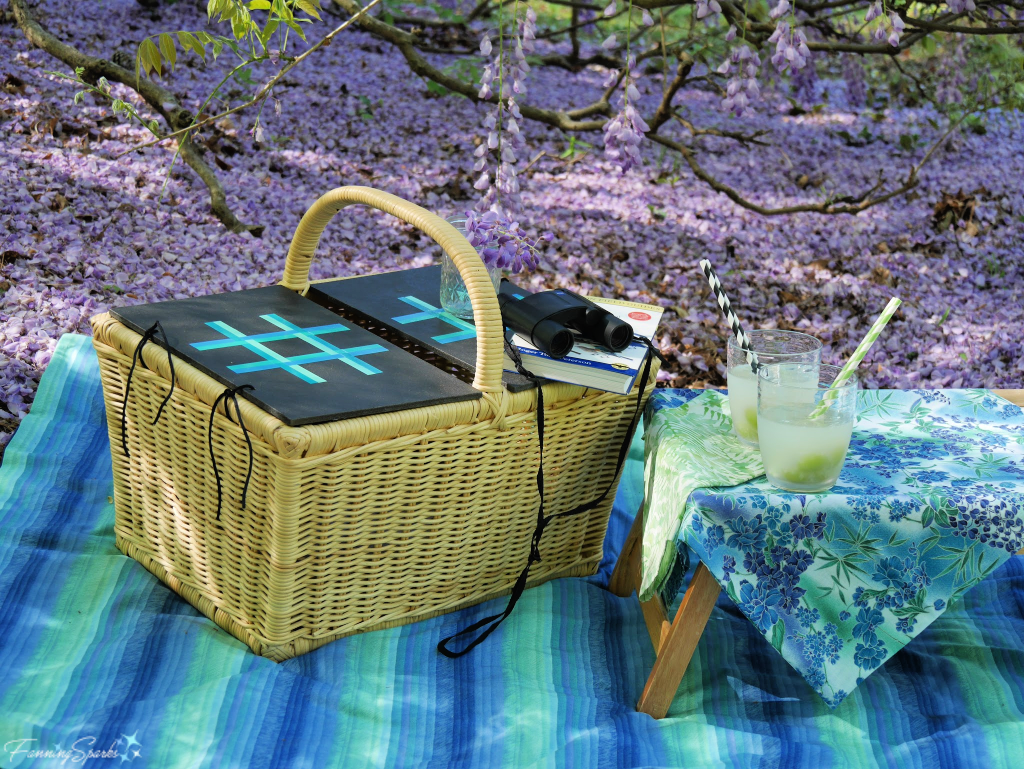
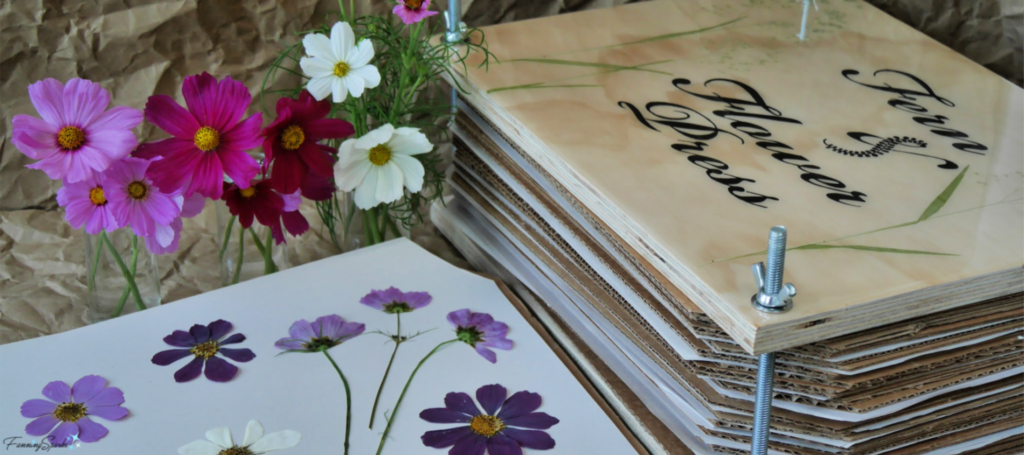
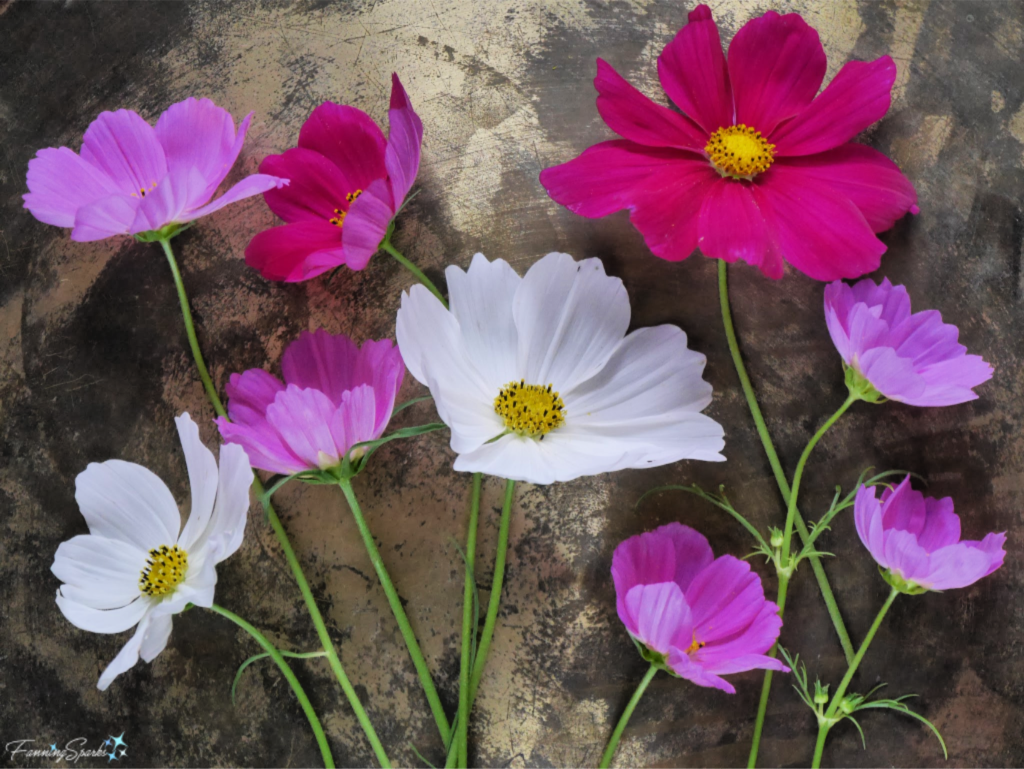
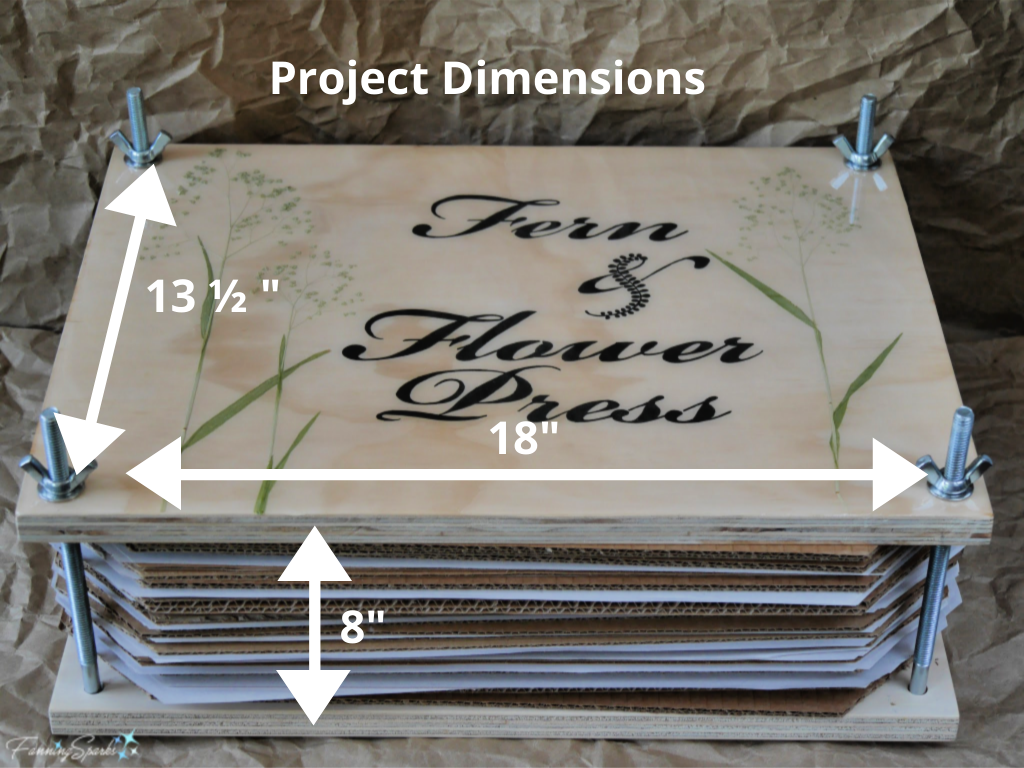
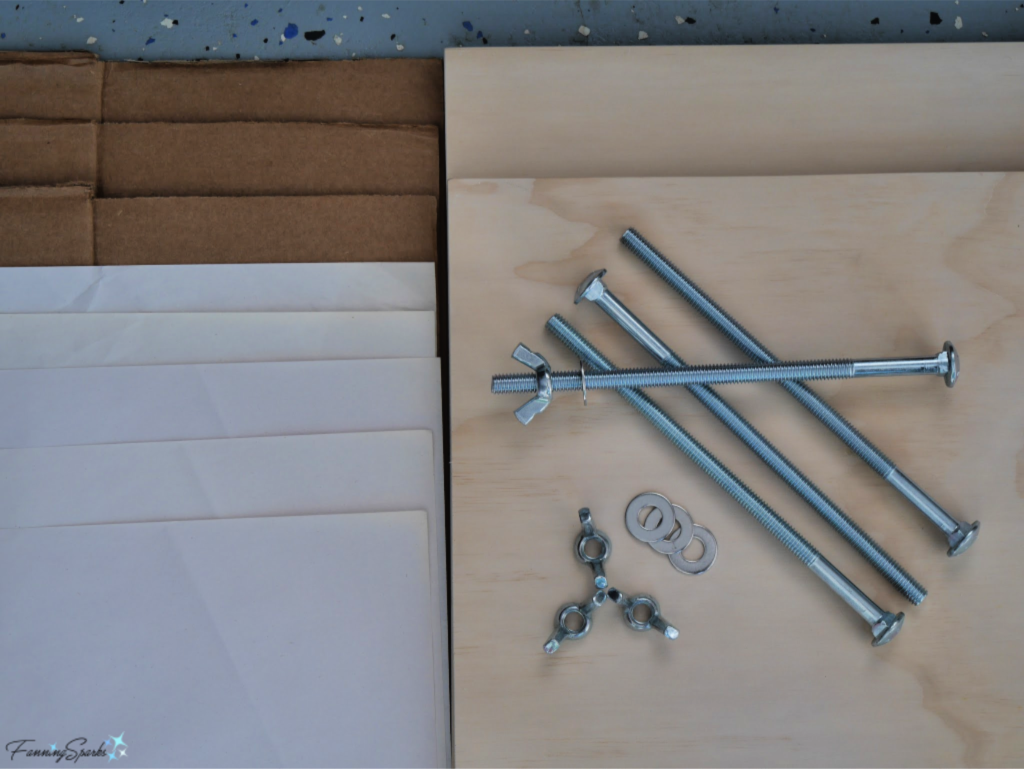
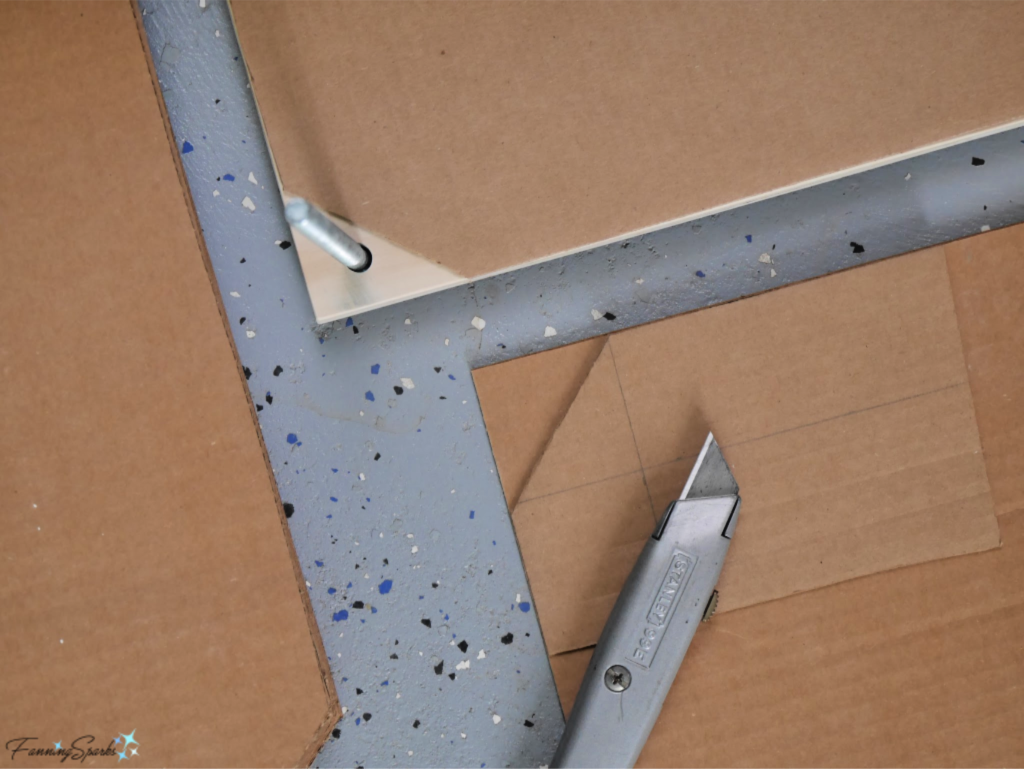 Use one of the cardboard sheets to cut a piece of packing paper to the same size. I found it easiest to use scissors and cut multiple sheets of paper at once. Repeat to make 72 sheets of paper.
Use one of the cardboard sheets to cut a piece of packing paper to the same size. I found it easiest to use scissors and cut multiple sheets of paper at once. Repeat to make 72 sheets of paper.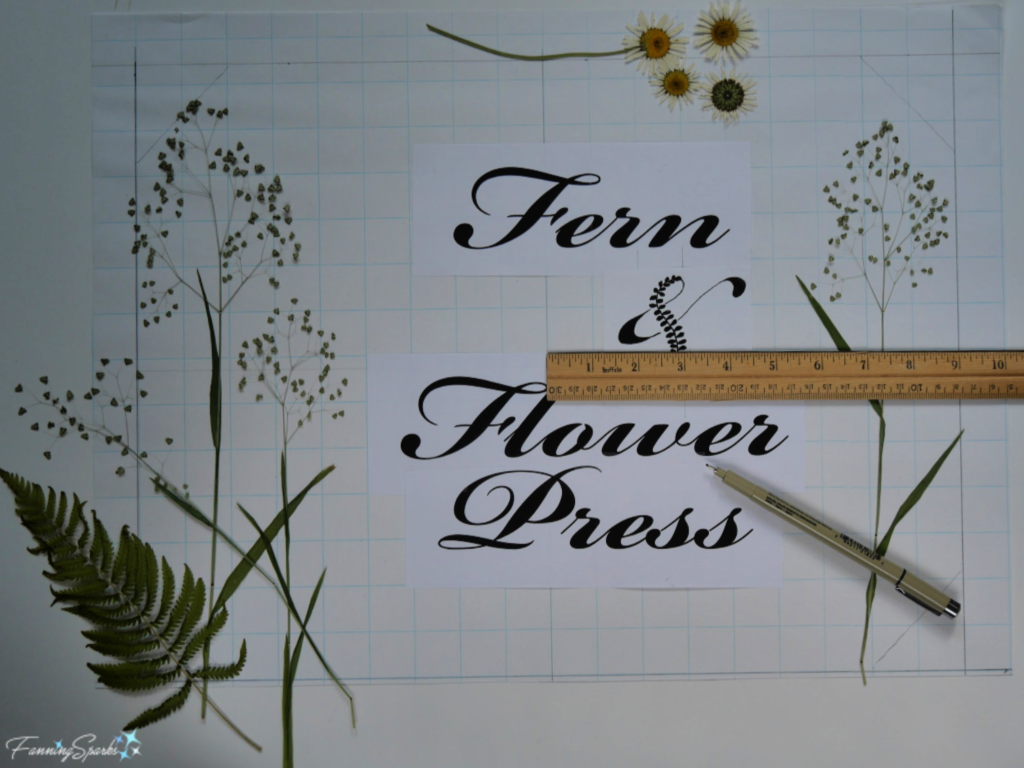 Step 6 – Trace and Color Title on Top Cover Tape your final design to the Top Cover. Use a ball stylus tool or dull pencil to trace the letters pressing down to indent the surface of the wood. Check to ensure indentation is visible.
Step 6 – Trace and Color Title on Top Cover Tape your final design to the Top Cover. Use a ball stylus tool or dull pencil to trace the letters pressing down to indent the surface of the wood. Check to ensure indentation is visible.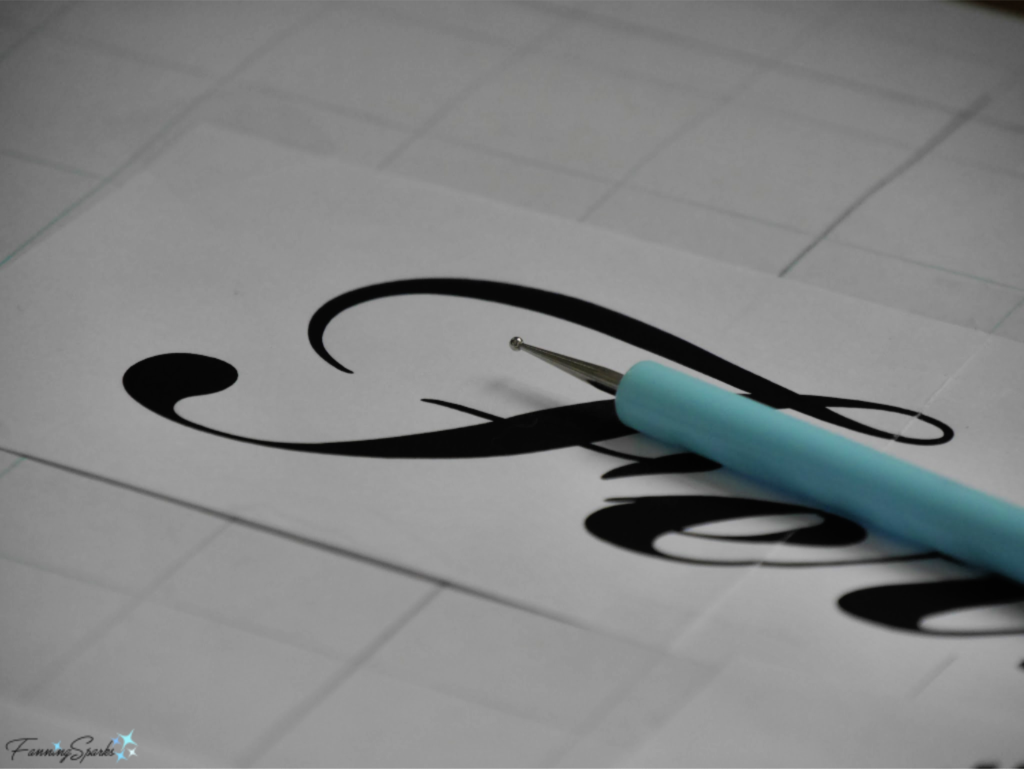 Use 08 black marker to trace along the indentations. Fill in letters with brush tip black marker.
Use 08 black marker to trace along the indentations. Fill in letters with brush tip black marker.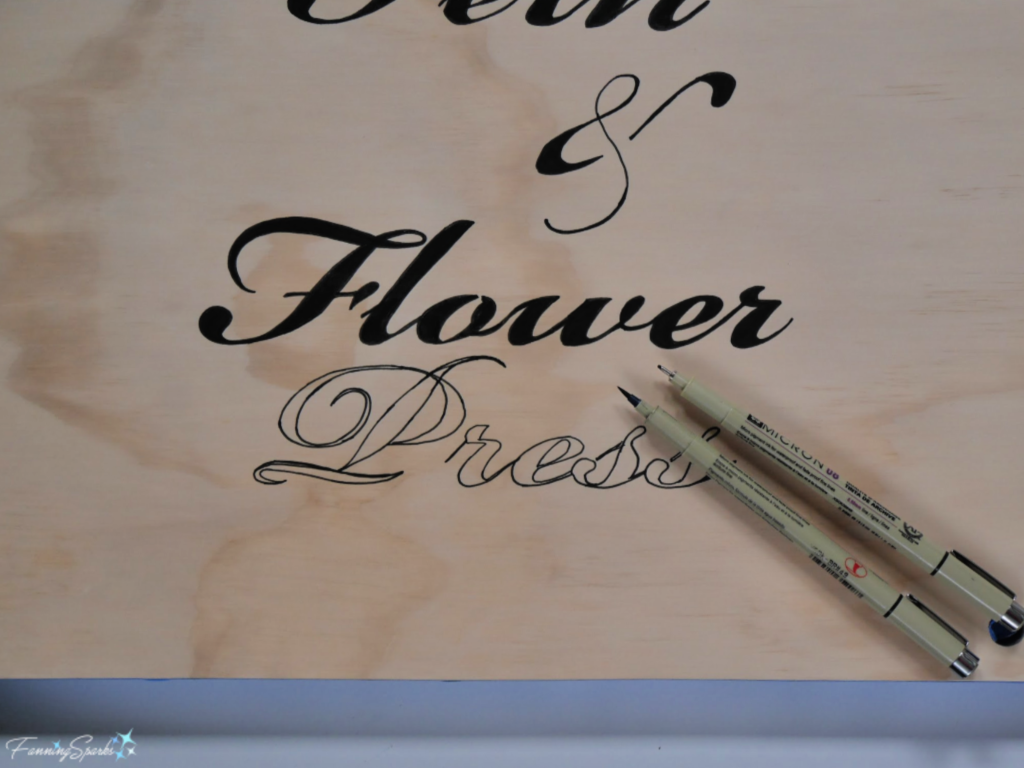 Step 7 – Seal with Mod Podge Use small paint brush to apply a thin coat of Mod Podge matte finish over the entire surface of the Top Cover. Start with the lettering. Then apply Mod Podge to the areas where the dried materials will be positioned. Carefully, place the dried materials on the Mod Podge pressing down to attach all stems, leaves, seeds, etc to the surface of the wood.
Step 7 – Seal with Mod Podge Use small paint brush to apply a thin coat of Mod Podge matte finish over the entire surface of the Top Cover. Start with the lettering. Then apply Mod Podge to the areas where the dried materials will be positioned. Carefully, place the dried materials on the Mod Podge pressing down to attach all stems, leaves, seeds, etc to the surface of the wood.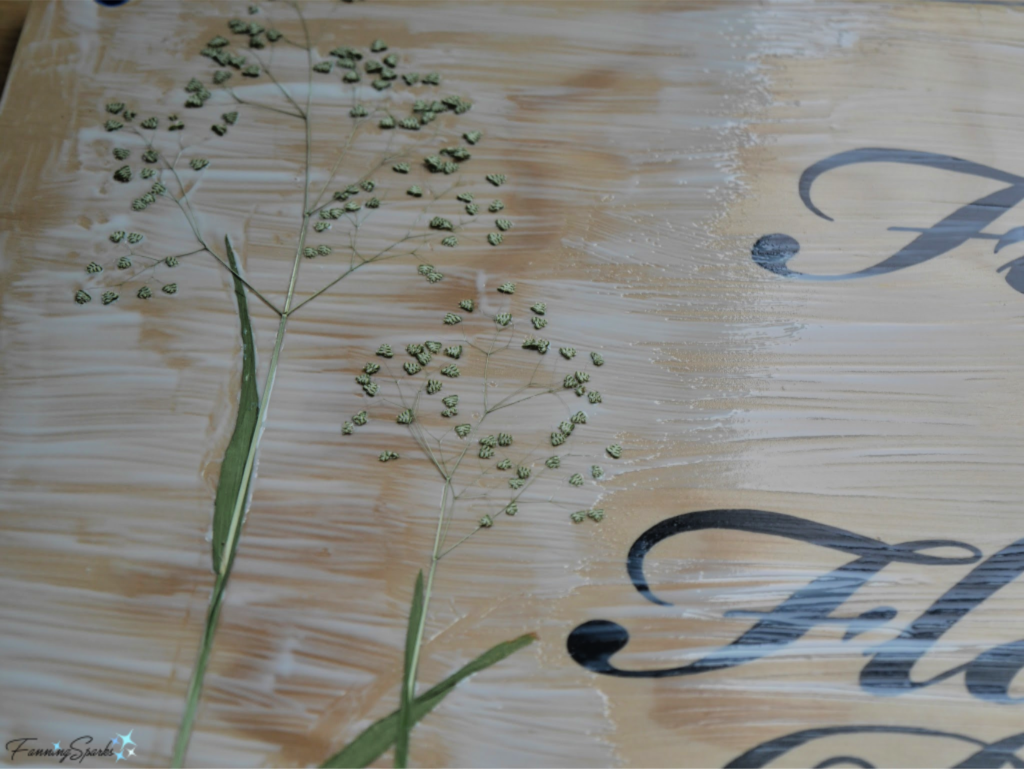 After placing everything as desired, prepare to apply a top coat of Mod Podge. The top coat can be thinned out with a little water if desired. The objective is to seal all the natural materials under the Mod Podge so everything stays in place when the resin coat is applied. Sealing also reduces the number of air bubbles in the next step.
After placing everything as desired, prepare to apply a top coat of Mod Podge. The top coat can be thinned out with a little water if desired. The objective is to seal all the natural materials under the Mod Podge so everything stays in place when the resin coat is applied. Sealing also reduces the number of air bubbles in the next step.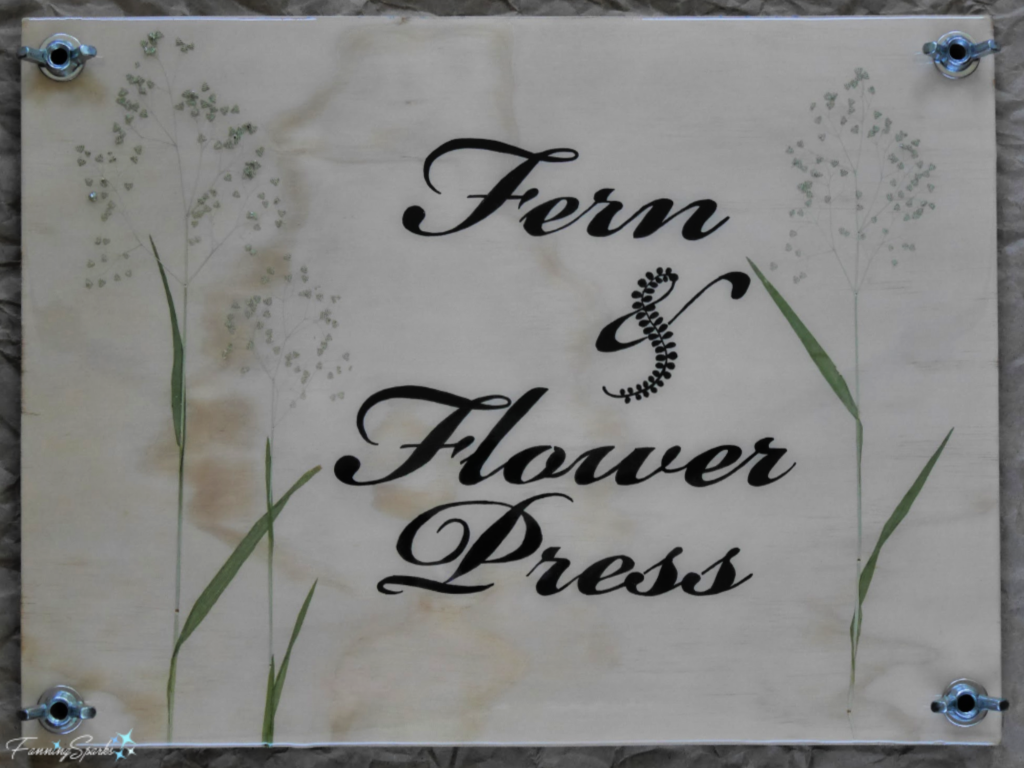 Your new Fern & Flower Press is ready to use! Begin by gathering leaves, fronds, flowers, grasses, seed heads and any other plant materials you wish to dry and press. It’s best to cut plant materials early in the day as soon as they are dry. Avoid thick or dense elements such as roses or peonies. Work quickly to minimize drooping and wilting.
Your new Fern & Flower Press is ready to use! Begin by gathering leaves, fronds, flowers, grasses, seed heads and any other plant materials you wish to dry and press. It’s best to cut plant materials early in the day as soon as they are dry. Avoid thick or dense elements such as roses or peonies. Work quickly to minimize drooping and wilting.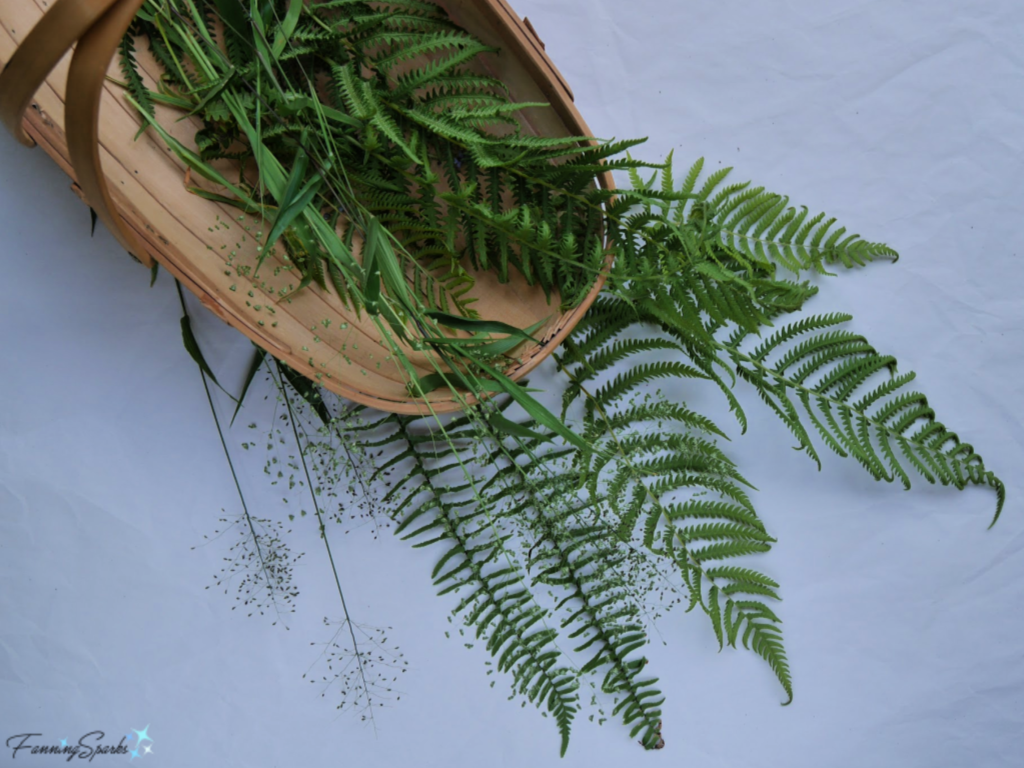 Separate and trim the materials to be pressed.
Separate and trim the materials to be pressed.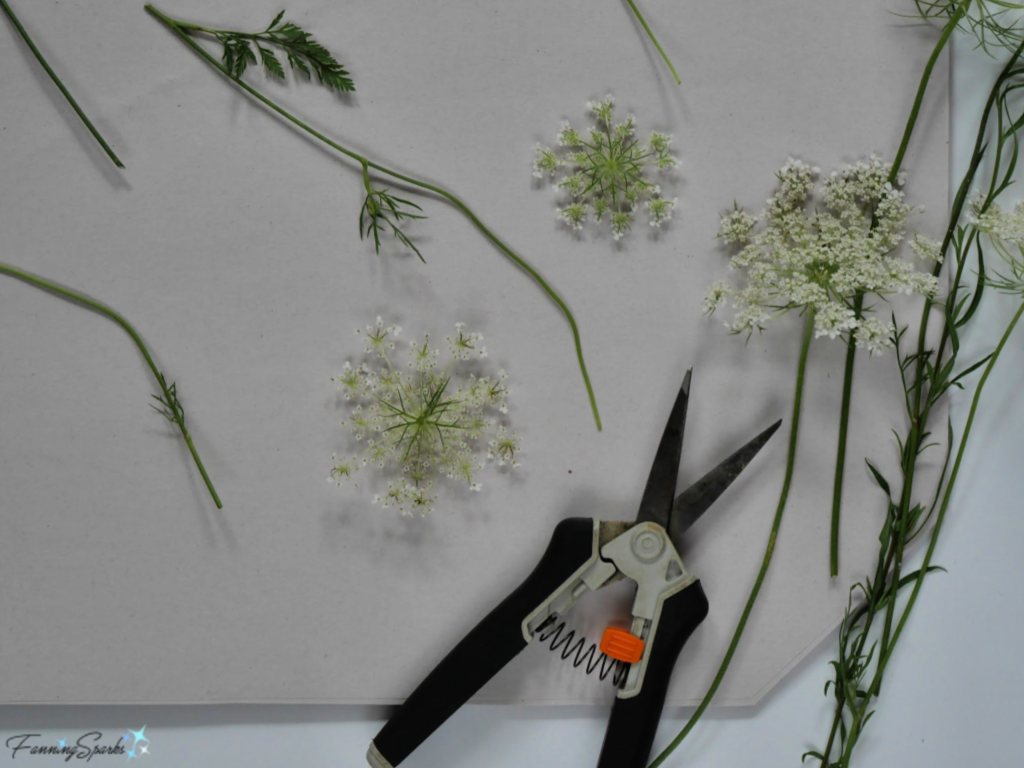 To place plant materials in the press, layer the components as follows:
To place plant materials in the press, layer the components as follows: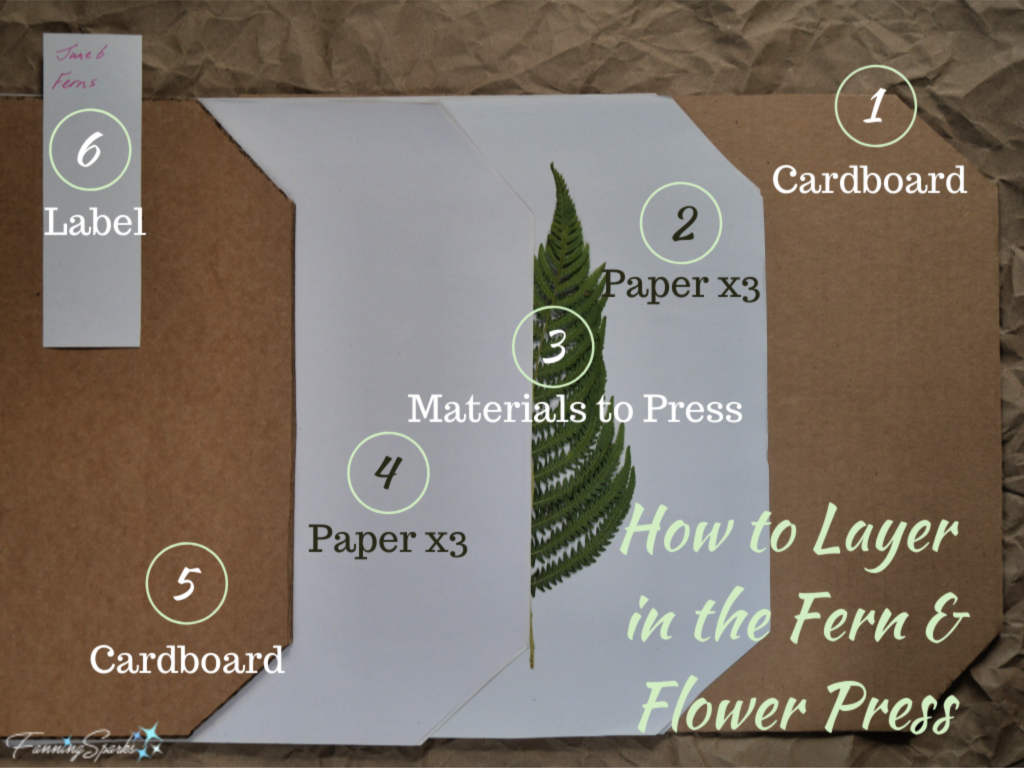 Insert the carriage bolts into the Bottom Cover. Continue to build layers stacking them on the bottom of the press. When all layers are ready, slip the Top Cover onto the carriage bolts, slide on flat washers and tighten with the wingnuts. Ensure all 4 wingnuts are tightened equally.
Insert the carriage bolts into the Bottom Cover. Continue to build layers stacking them on the bottom of the press. When all layers are ready, slip the Top Cover onto the carriage bolts, slide on flat washers and tighten with the wingnuts. Ensure all 4 wingnuts are tightened equally. Now it’s time to let the press do the work. Drying times will vary but most plant materials are ready in about 2 weeks. You may need to re-tighten the wingnuts as the materials dry. While you’re waiting, start planning how you’ll use your beautifully pressed plant materials!
Now it’s time to let the press do the work. Drying times will vary but most plant materials are ready in about 2 weeks. You may need to re-tighten the wingnuts as the materials dry. While you’re waiting, start planning how you’ll use your beautifully pressed plant materials!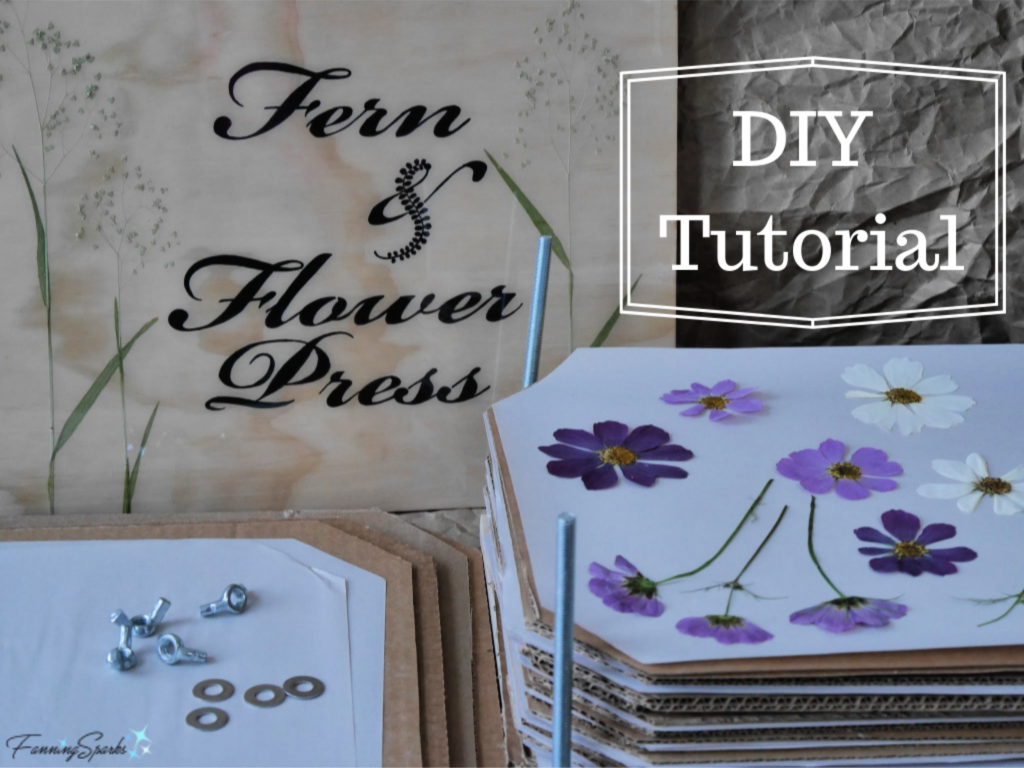 You can learn more about epoxy resin on the
You can learn more about epoxy resin on the